
mobile - desktop
 | mobile - desktop |
 |
 3 months for $50.00 |
|
News & Events:
|
|
Reptile & Amphibian
News Blog Keep up with news and features of interest to the reptile and amphibian community on the kingsnake.com blog. We cover breaking stories from the mainstream and scientific media, user-submitted photos and videos, and feature articles and photos by Jeff Barringer, Richard Bartlett, and other herpetologists and herpetoculturists.
Friday, April 27 2012Gila Monsters
I am currently working with four yearling Reticulated Gila Monsters. I purchased them from Dr. Mark Seward in Colorado. They are wonderful animals and every one of them has a different personality. I try to handle them often (usually during feeding). The first two have become very docile and are very easy to handle. The other two are still a little defensive so, they are handled with a welding glove. It took me a while to get used to the handling technique. I received two small bites since January. Even though they were very small, short, nips, the pain was out of this world. It lasted for a good 6 hours. None the less, I really love these animals, bite or no bite. I am getting the funds together now to purchase an adult pair. I am very much looking forward to next years breeding season. I seriously doubt I will sell any of the hatchlings this first go around.
Mark's animals are spectacular. Check out his website www.docseward.com I will be working on a YouTube video of my animals soon. I found my first Gila Monster in May of 2000, road cruising a 4 wheel trail in the Organ Pipe National Monument. It was about 8:30 PM and about 85 degrees F. I managed to get three shots off using my old Nikon FM, a flash and some good slide film. After that minute and a half of excitement, I was hooked! I was so excited, I got lost on the way down the mountain trail only to get stopped by 4 Boarder Patrol cars. They were friendly and were only interested if I had any illegals hiding in the Chevy Blazer. When I explained what I was doing and told them what I found, they asked if they could "see" my new found Gila. I don't think they had any idea that they were protected. If it would have been DNR, it would have been another story........... I sure would be interested in some more Gila stories......this is my first blog,,,hope I did OK??? Saturday, April 21 2012Living Gems 2011 Babies
Living Gems 2011 Babies
At long last, Living Gems Reptiles is thrilled to profile the babies from its 2011 breeding year. The 17 youngsters in this litter, our first ever, were born on September 14, the result of a pairing between Hills, a brilliant orange male estimated to be born in late 2006: 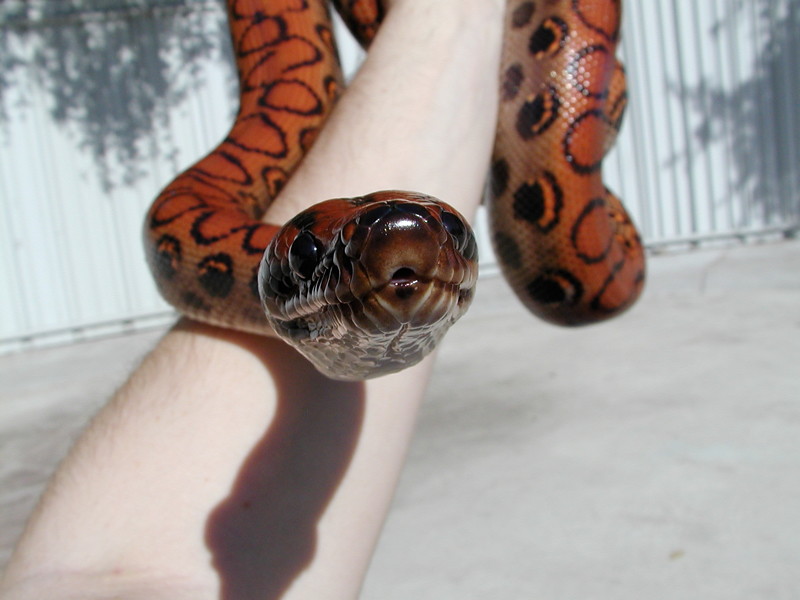 And Alexandrite, a pretty October 2007 female:  Alex was named, as with all Living Gems females, for a pretty gemstone. She is alive and well. Hills was named for the legendary New Zealand mountaineer Sir Edmund Hillary (1919-2008), in honor of this snake’s love of climbing: Hills would always break for my head the first chance he got, and end up wrapped around the top of it. He unfortunately passed away in August of last year, just before the litter was born, and slightly before we went on a sales hold to resolve the events described in the “Beating a Misdiagnosis” thread. The litter contains nine males and eight females. Initial sexing was done by me, and then confirmed by a local professional. Behavior-wise, this litter is full of personality. We’ve done dozens of handling sessions for each baby, part of our commitment to start acclimating them to humans, and -- as with most baby Brazilians -- they missed no chances in the first few sessions to show their outsized bravery. There’s something both impressive and funny about watching 33 grams of fury trying to tell your hand who is boss. Physically, I’m very happy with the litter. For color, their father Hills definitely left his mark: the entire set is above average, with many well above, and an unusually high percentage of potential stunners. Their dorsal ovals all have a slight “blushing” effect where the color gets slightly darker in the center. For pattern, they all have at least one linked dorsal, where one spot has “joined” with its neighbor to form a longer chain. Their side circles are almost exclusively traditional crescents -- nothing like a clean classic look! -- with from zero to three solid black (“eclipse”) and up to three merged spots per baby. Several babies have no departures at all. On about half of the litter, there are small black markings on the back -- another legacy from their father, almost like an official “trademark” pattern for the line that hints of aberrancy -- and/or some faint “bonus black dots” showing among the side crescents. Health-wise, all have now shed five or six times, eaten at least twenty times, and had multiple “confirmations” their digestion is properly working. They have been growing like little weeds: according to my monthly weigh-ins, their last check showed the average baby had tripled its weight in the seven months since their birth, and is running about a month ahead of the average growth rate for baby Brazilians…all of which proves that a small, high-quality collection focused on top care has its benefits for customers. As has been outlined in previous posts, all of these babies come from a disease-tested facility, and Mom’s test results are available upon request. Over the following posts, I will share a description and several pictures of each baby in the litter in order to give you an idea how they act and look, as well as any behavioral or physical quirks. So grab a cup of your favorite brew, sit back, relax, and enjoy! ------ B-01 (Male) This little guy is a calm but highly attentive fellow, who closely follows your every movement when held. He was very placid the last time I handled him for any length, even though he was in shed. Physically, he has several unique traits. On his back, he has three linked chains of two to four spots. He also has a small black dot in his neck area. On his sides, he has a 100% crescent pattern -- a clean, classic look all the way -- and the crescents are thick and distinctive, which should make for an impressive adult. At Birth This shot was taken in mid-September 2011. 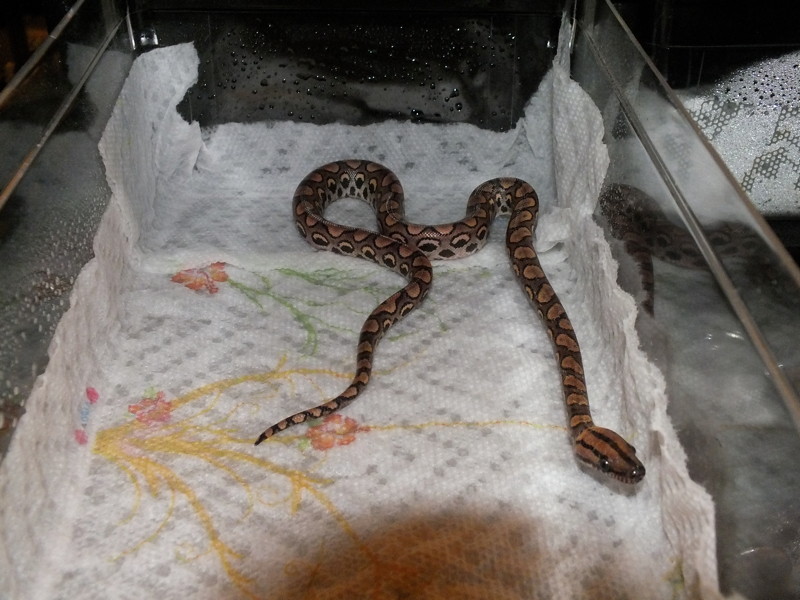 Post Shed This shot was taken in late September 2011. Apologies for the bad lighting; it was taken without formal prep. 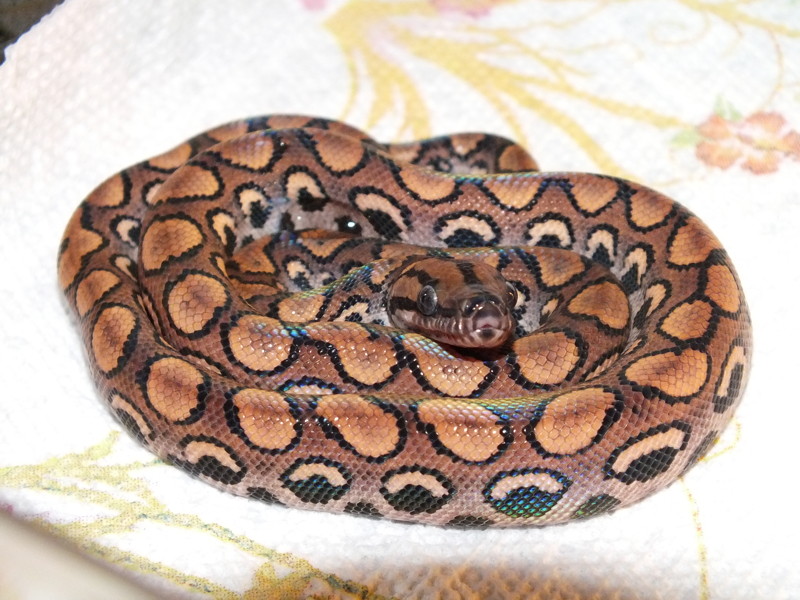 Formal Photo Session This series of shots was taken in early October 2011. Originally, these were to be the sale shots, but circumstances forced a long delay. This mini-set includes a front/side shot, a back/side shot, and a top shot. 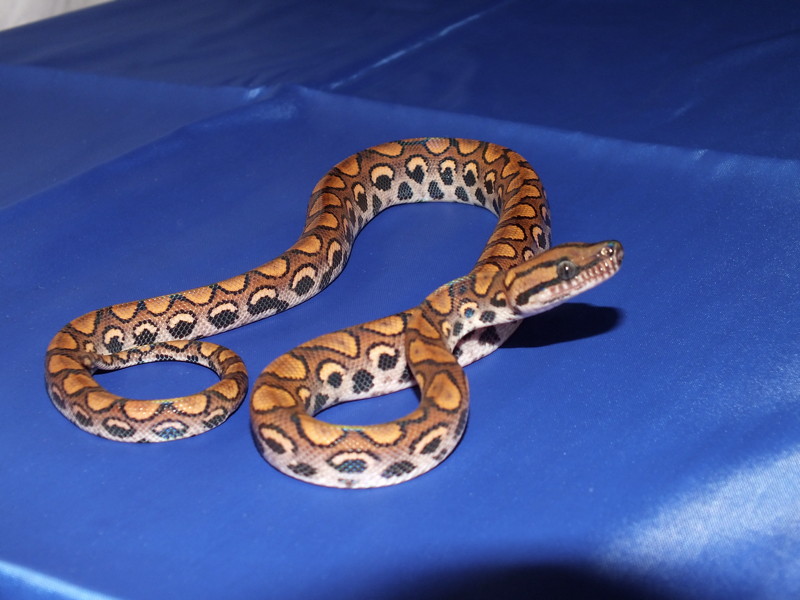 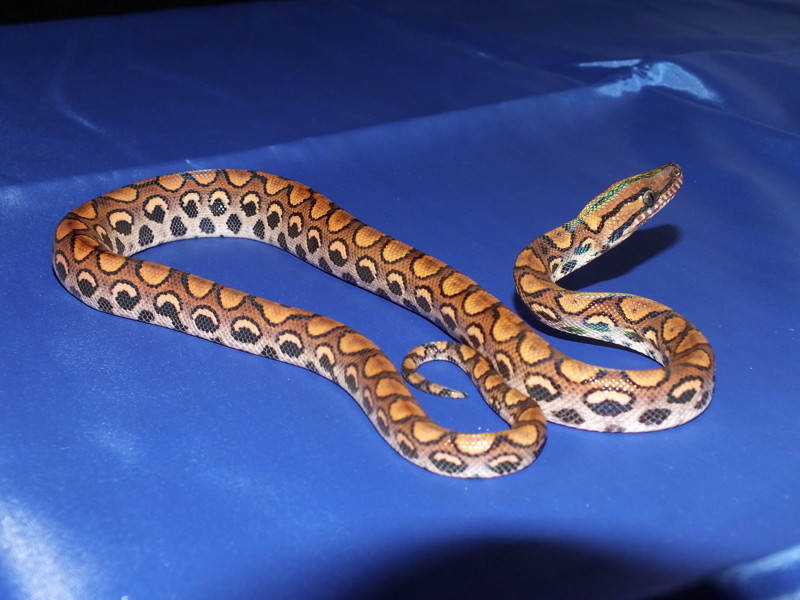 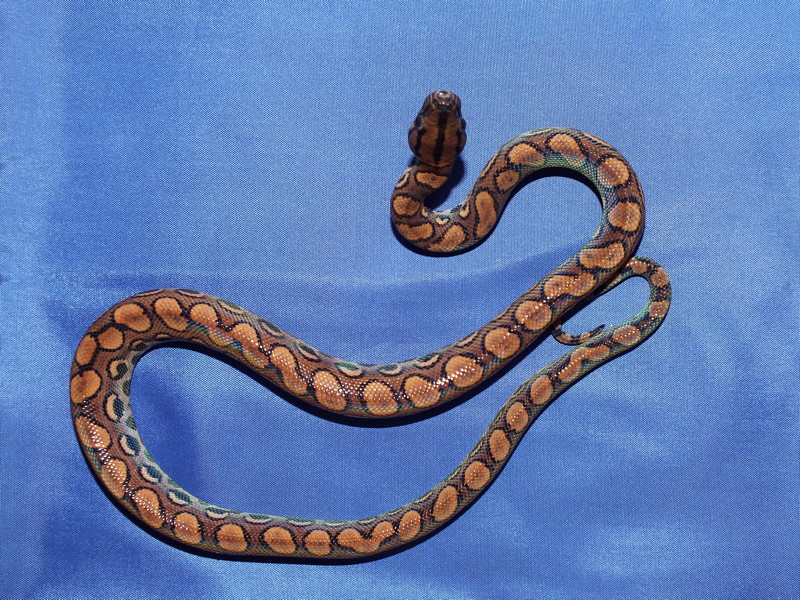 Three-Month Update These shots were taken in late December 2011 to late January 2012, and present an updated view of the baby after the delay. This mini-set includes a side shot and a top shot. 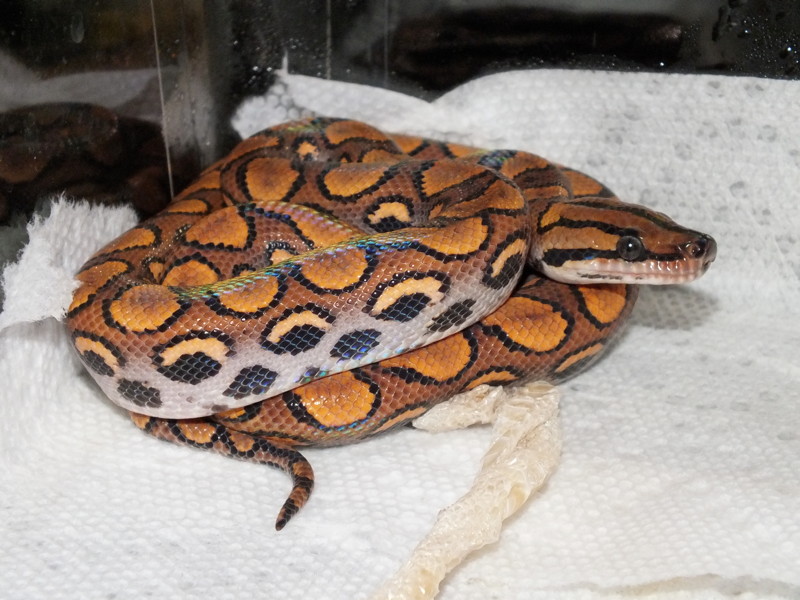 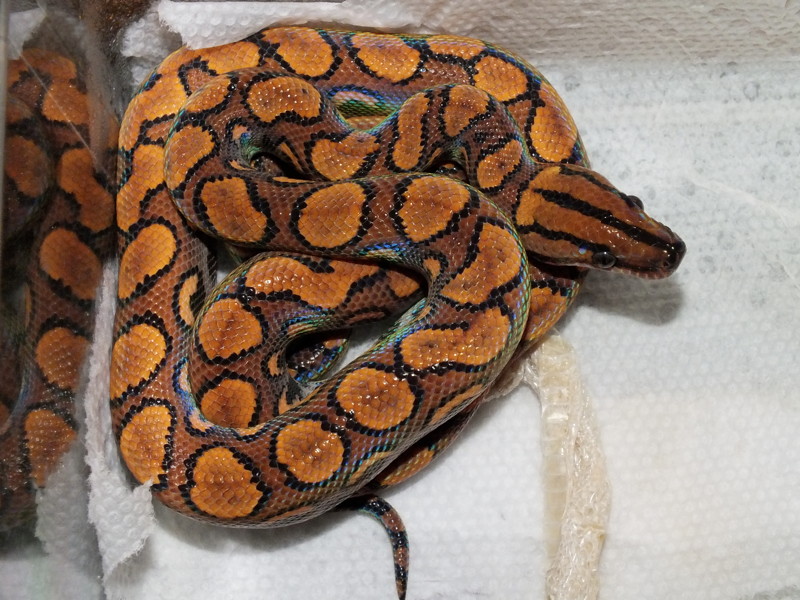 Six-Month Update These shots were taken in March 2012, and present a further updated view of the baby after the delay. This mini-set includes a side shot, a top shot, and a close-up head shot. 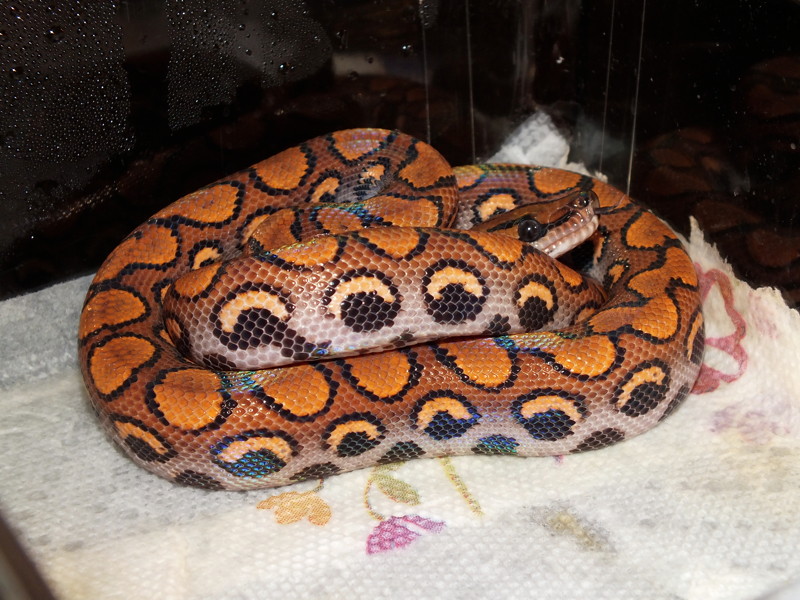 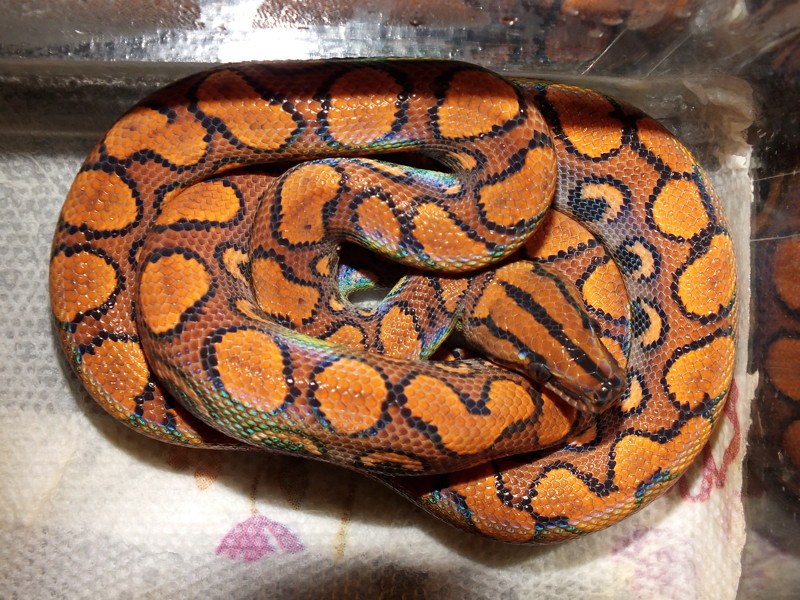 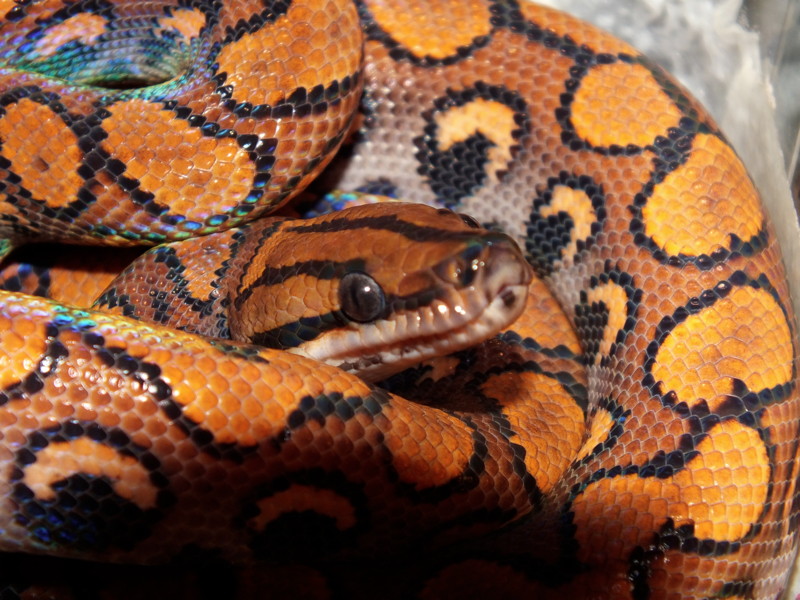 As of March 31, this little one had increased from a birth weight of 34 grams to 99 grams. ------ B-02 (Male) During his final inspection to round out these notes, this little guy was not the model of baby patience: he got very annoyed at me peering at him, and took a baby-defiant swipe or two at me to prove his independence. That said, he’s usually pretty mellow. He may also be a pretty sharp one (for a snake): when I had the local breeder come over to verify gender, B-02 took a swipe at me as I was putting him back in his drawer. I protested to the baby he was targeting the wrong guy, and my friend noted that he yeah, I was just the guy who had hired the guy who examined his junk. Like I said…this little one may be sharper than we think. Physically, he has several unique traits. On his back, he has one linked chain of two spots, and one longer set that should be breedable into a chain: four of his dorsals are closely touching but still have thin borders separating them. On his right side, he has two departures from an otherwise solid crescent pattern: one eclipse and one merged dot. On his left side, he has four departures: three eclipses and one merged dot. At Birth This shot was taken in mid-September 2011. 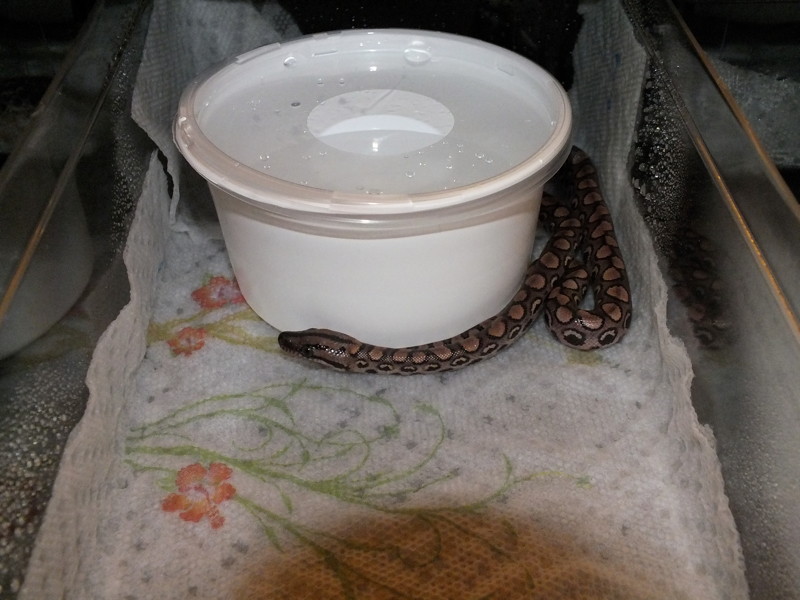 Post Shed This shot was taken in late September 2011. Apologies for the bad lighting; it was taken without formal prep.  Formal Photo Session This series of shots was taken in early October 2011. Originally, these were to be the sale shots, but circumstances forced a long delay. This mini-set includes a front/side shot, a back/side shot, and a top shot. 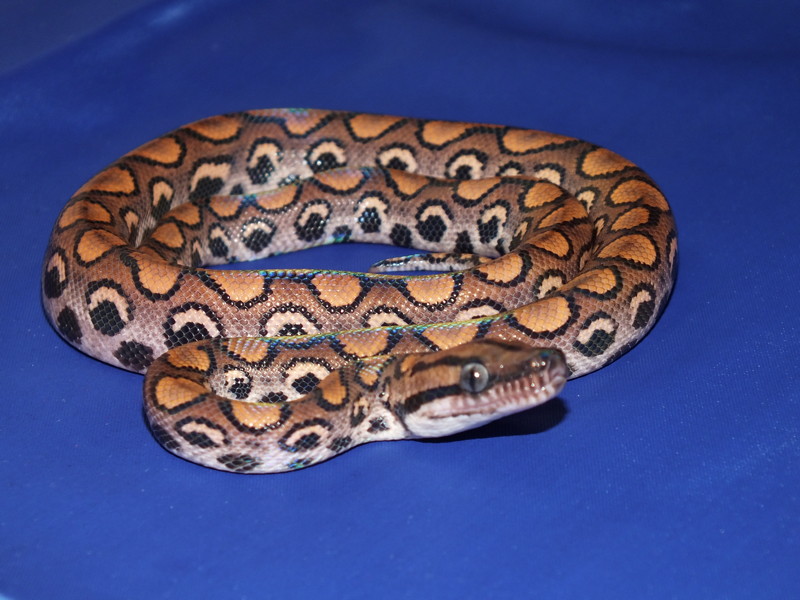 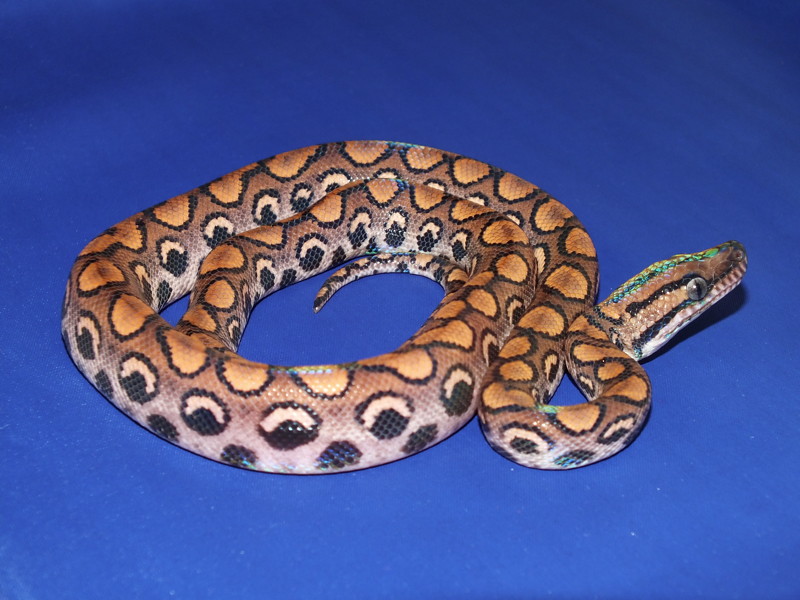 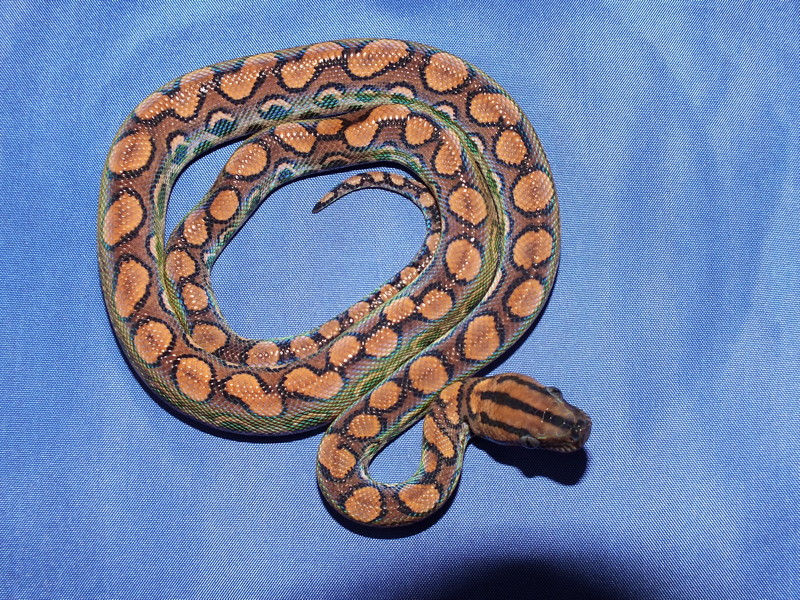 Three-Month Update These shots were taken in late December 2011 to late January 2012, and present an updated view of the baby after the delay. This mini-set includes a front shot and a top shot. 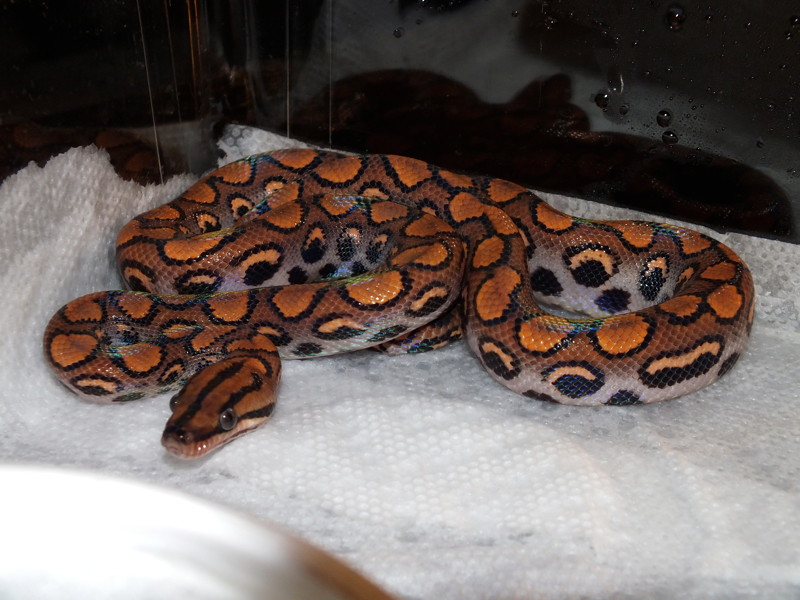  Six-Month Update These shots were taken in March 2012, and present a further updated view of the baby after the delay. This mini-set includes a side shot, a top shot, and a close-up head shot. 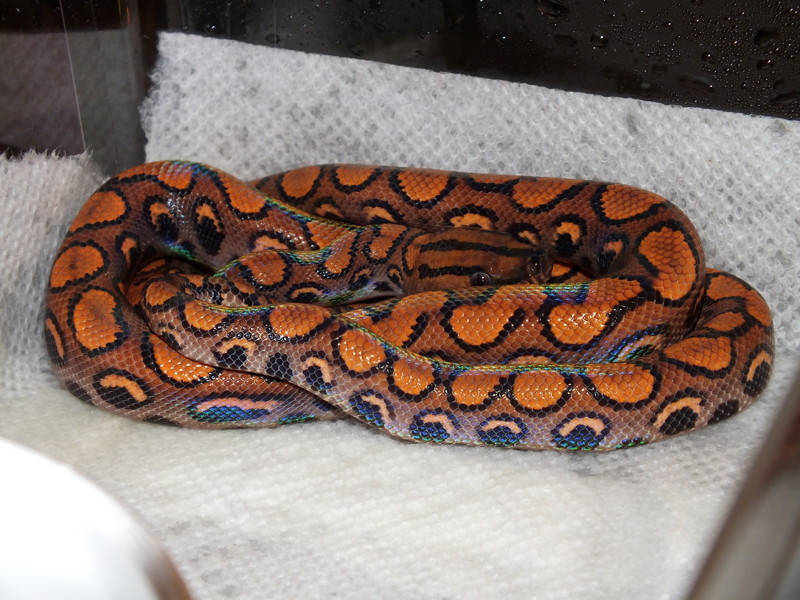 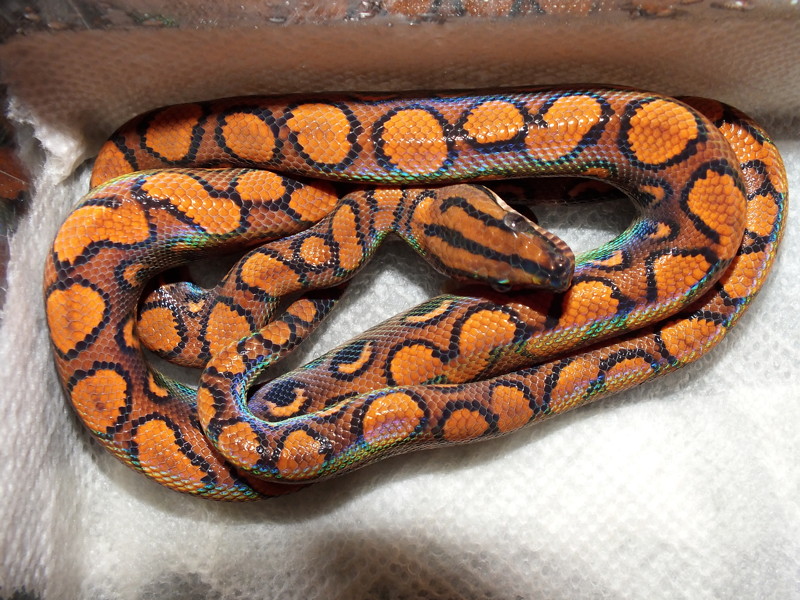 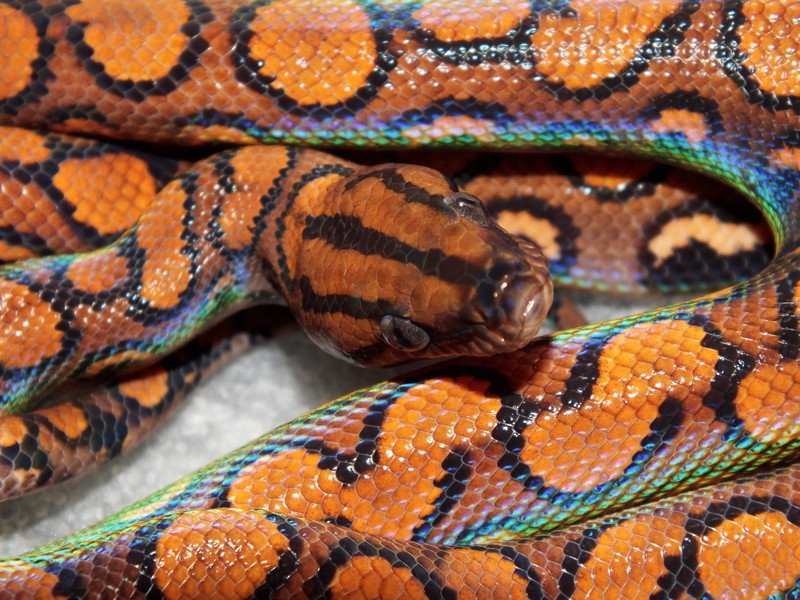 As of March 31, this little one had increased from a birth weight of 32 grams to 90 grams. ------ B-03 (Female) This little lady tried to make the litter’s first escape attempt the day she was born, worming out the top center of the door from her Mom’s hide right as I was closing it, and nearly getting herself clipped in the process (my hands were full with two other babies at the time). She had an almost “raisiney” appearance before her first shed, which cleared right up when she cast off her old skin. During the handling session where I mapped out her patterns, she was very on guard and wary of this unusual inspection, but held her peace the entire time. She can be a bit nervous as well; during the December weigh-in she was very clingy. This little girl has several unique traits. On her back, she has two linked chains of two spots. On her left side, she has a 100% crescent pattern. On her right side, she has two departures from an otherwise solid crescent pattern: one eclipse and one merged dot. Finally, she has a small distinctive black “bar” towards her tail along her center line. At Birth This shot was taken in mid-September 2011. 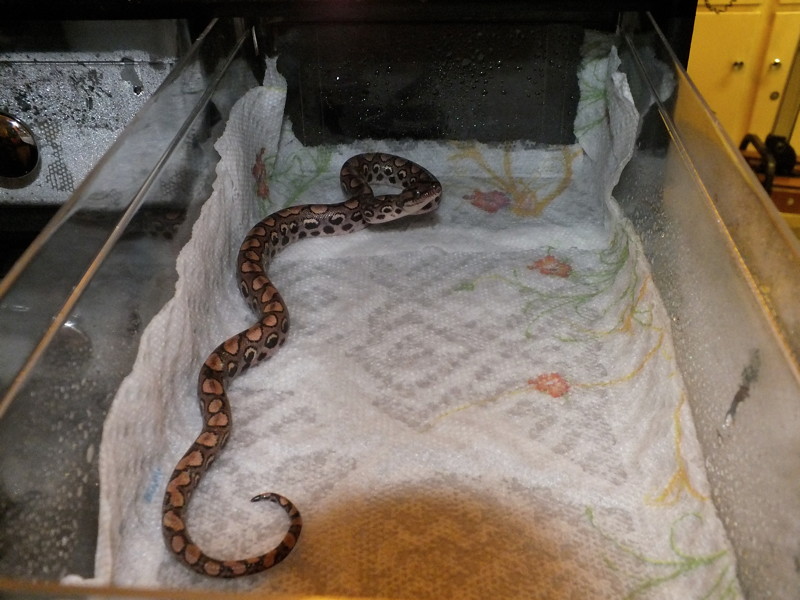 Post Shed This shot was taken in late September 2011. Apologies for the bad lighting; it was taken without formal prep. 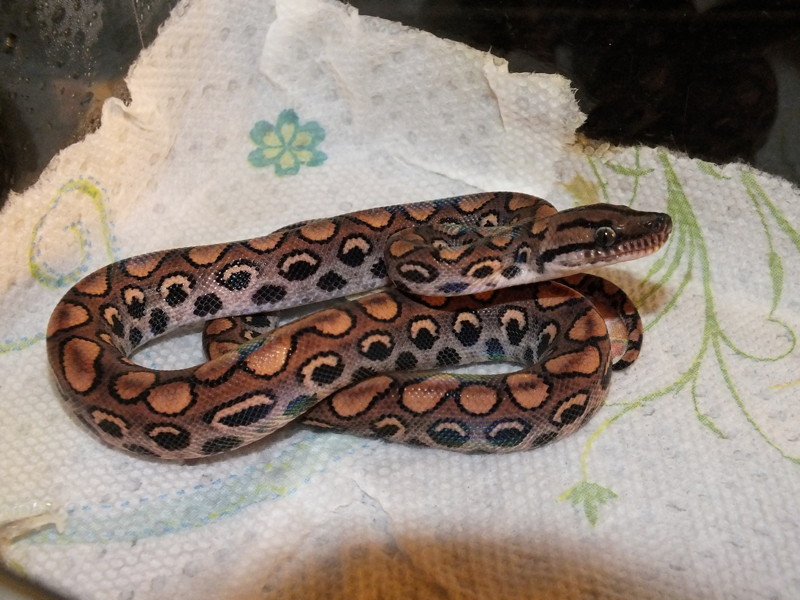 Formal Photo Session This series of shots was taken in early October 2011. Originally, these were to be the sale shots, but circumstances forced a long delay. This mini-set includes a front shot, a side shot, and a top shot.  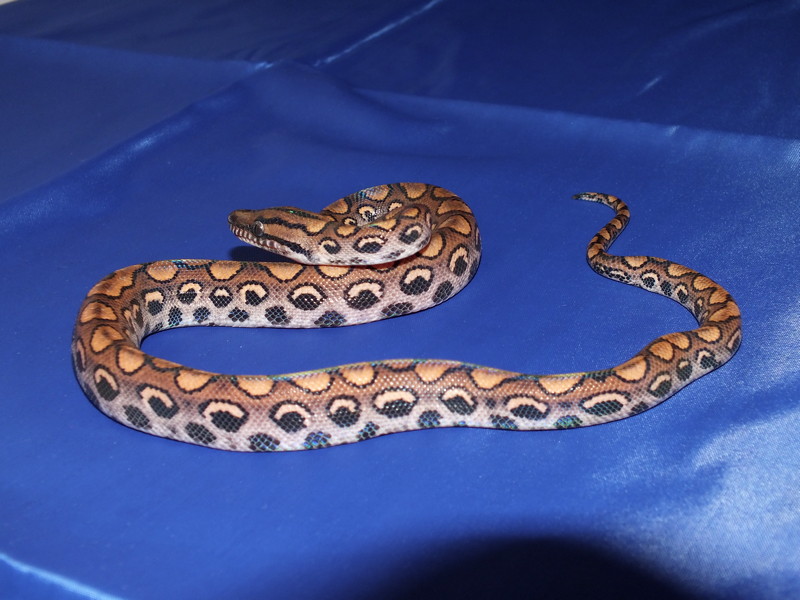  Three-Month Update These shots were taken in late December 2011 to late January 2012, and present an updated view of the baby after the delay. This mini-set includes two top shots, one taken just after she shed, and one a day later (a better photo I thought). 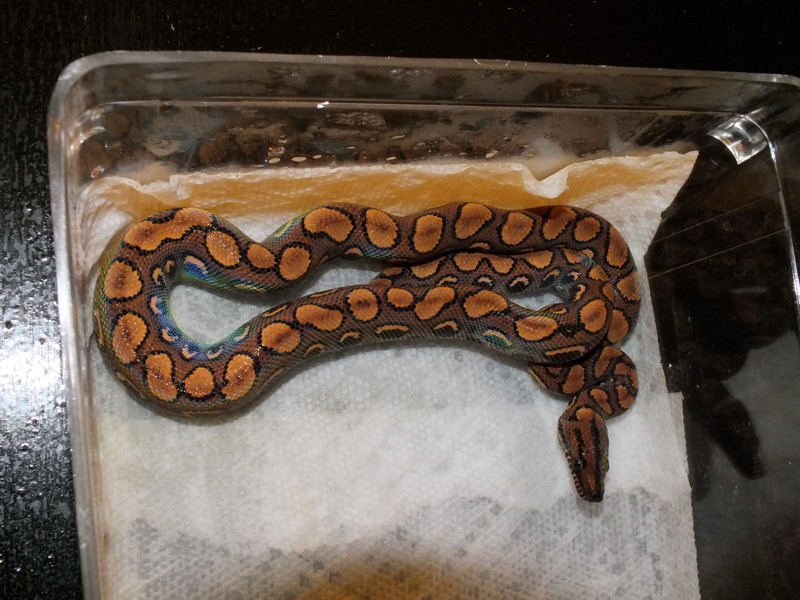 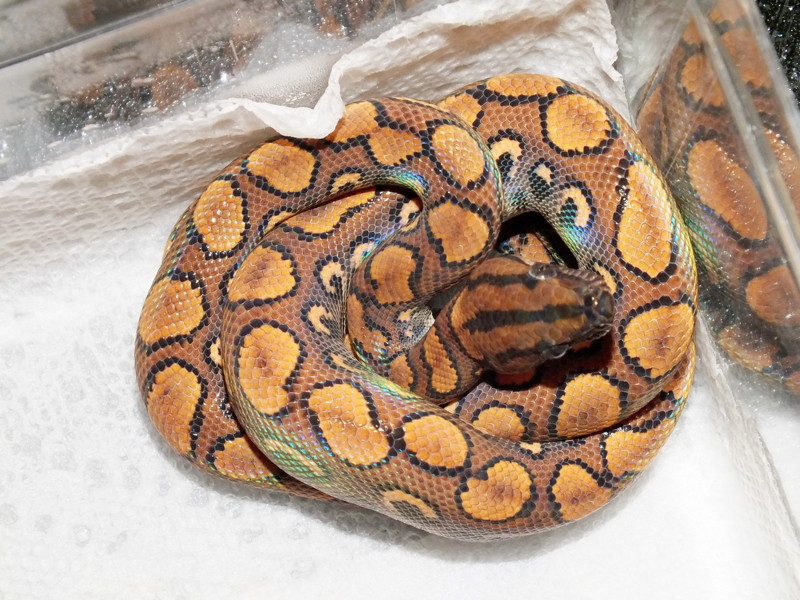 Six-Month Update These shots were taken in March 2012, and present a further updated view of the baby after the delay. This mini-set includes a front/side shot, a top shot, and a close-up head shot. 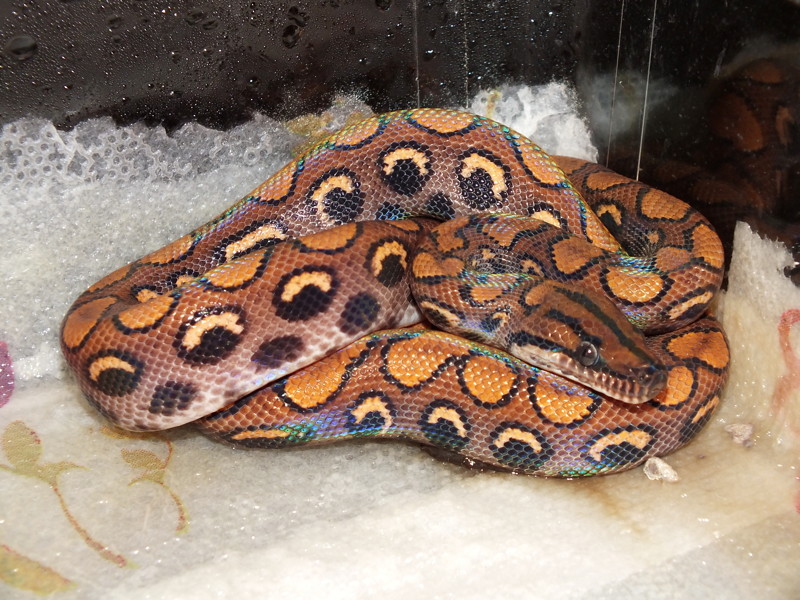 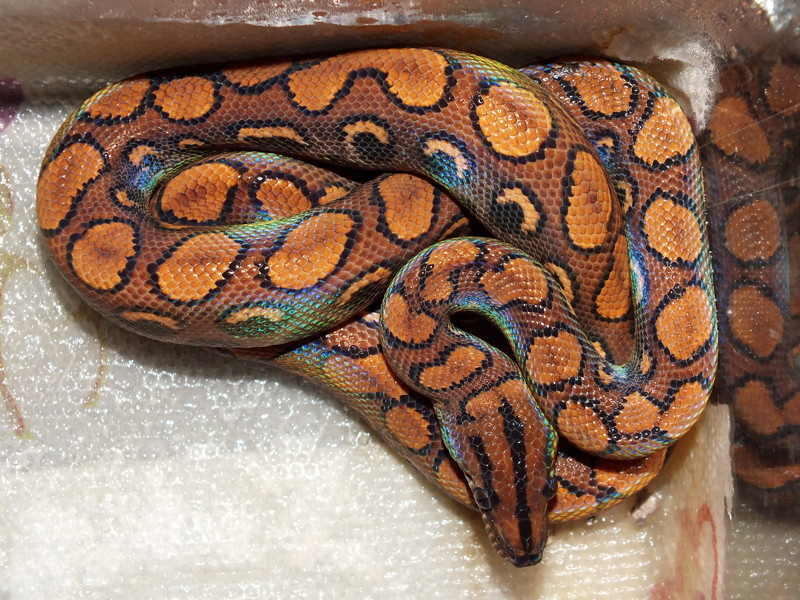  As of March 31, this little one had increased from a birth weight of 34 grams to 85 grams. ------ B-04 (Male) This little guy was in full spirit during his pattern inspection: he got really annoyed with my physical review, and decided to let my thumb know exactly how he felt about it (which was more cute than damaging -- he didn’t even break the skin). While he eats with clockwork reliability, he does tend to like his meal abandoned in his drawer with him before he’ll deign to eat it. Either that, or he thinks my “cooking” stinks. Physically, he has several unique traits. On his back, he has an impressive five linked chains, one of three spots and four of two. On his left side, he has a 100% crescent pattern. On his right side, he has only one or two departures from an otherwise solid crescent pattern, both eclipses. At Birth These shots were taken in mid-September 2011. The first shot was taken shortly after birth, while he was still with Mom. Not surprisingly, he looked a little rough around the edges. 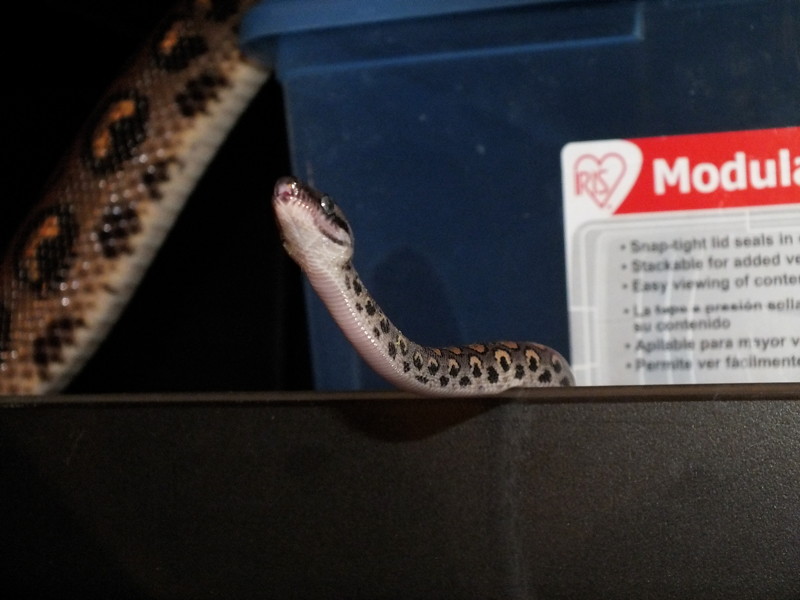 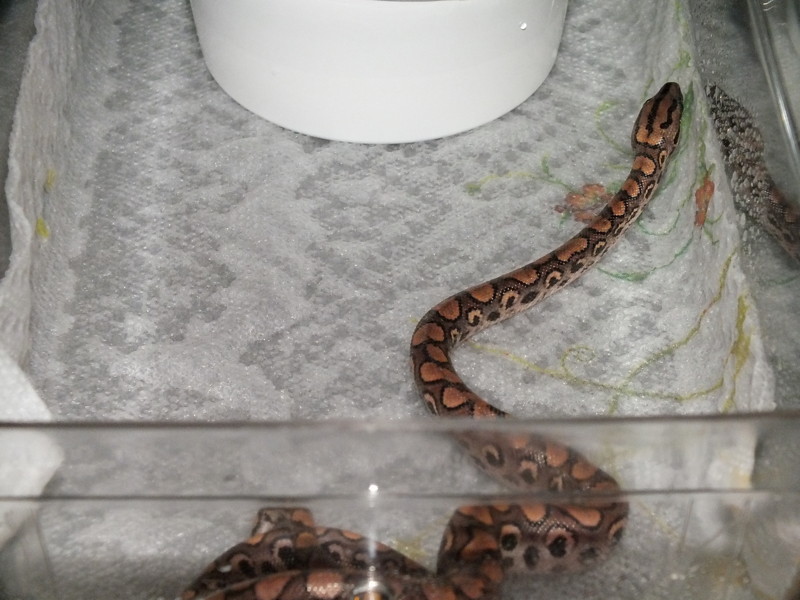 Post Shed This shot was taken in late September 2011. Apologies for the bad lighting; it was taken without formal prep. 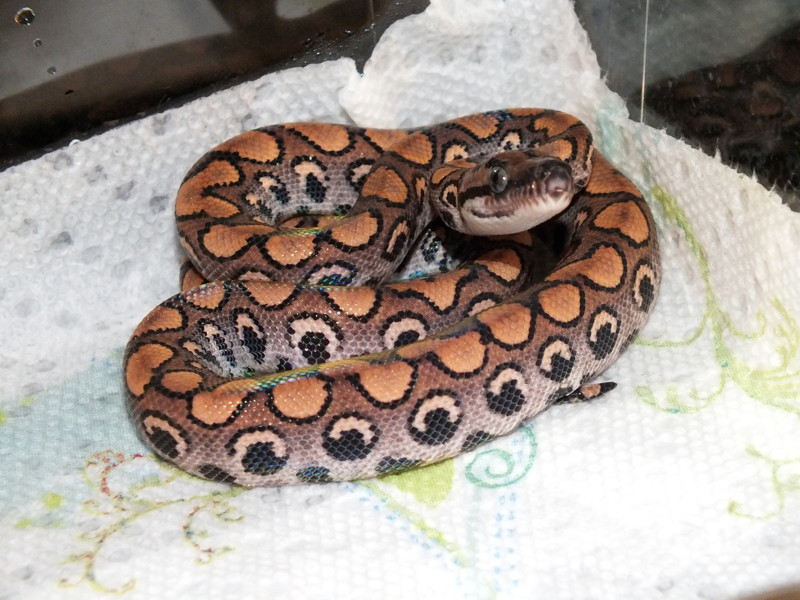 Formal Photo Session This series of shots was taken in early October 2011. Originally, these were to be the sale shots, but circumstances forced a long delay. This mini-set includes a front/side shot, a back/side shot, and a top shot.  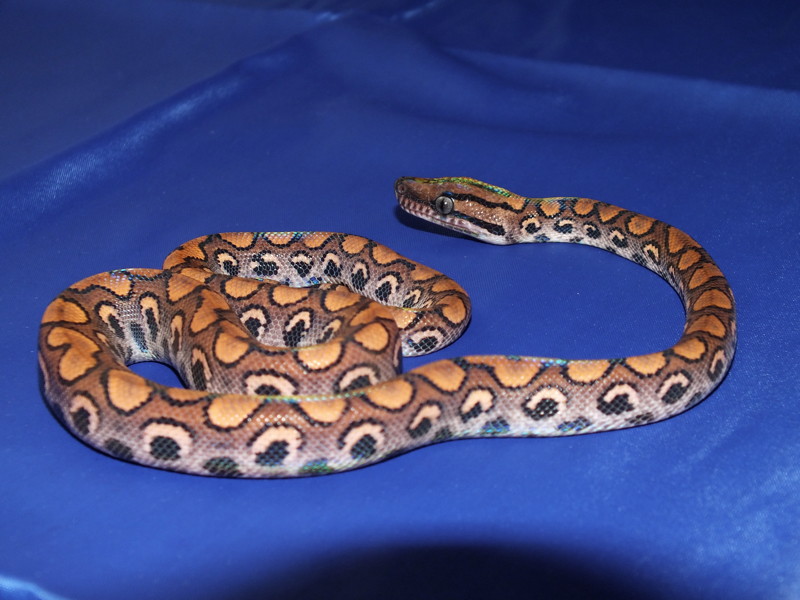 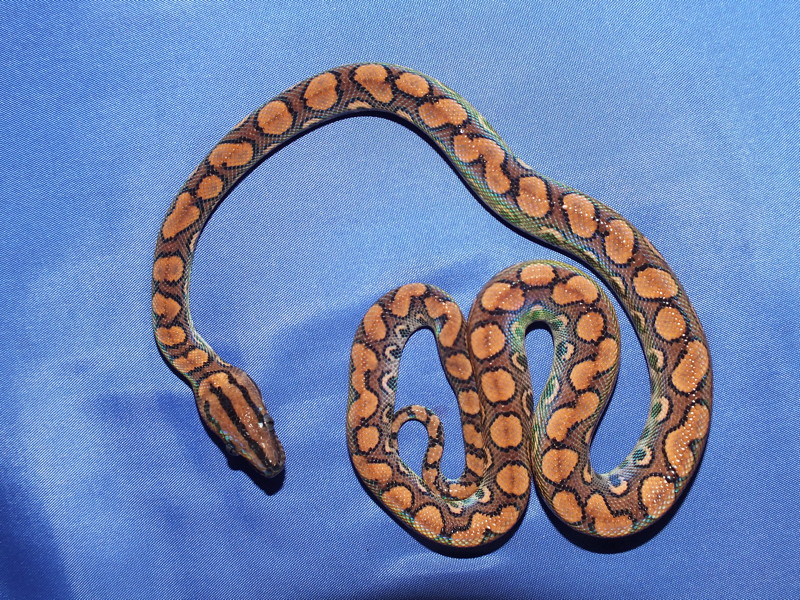 Three-Month Update These shots were taken in late December 2011 to late January 2012, and present an updated view of the baby after the delay. This mini-set includes a side shot and a top shot. 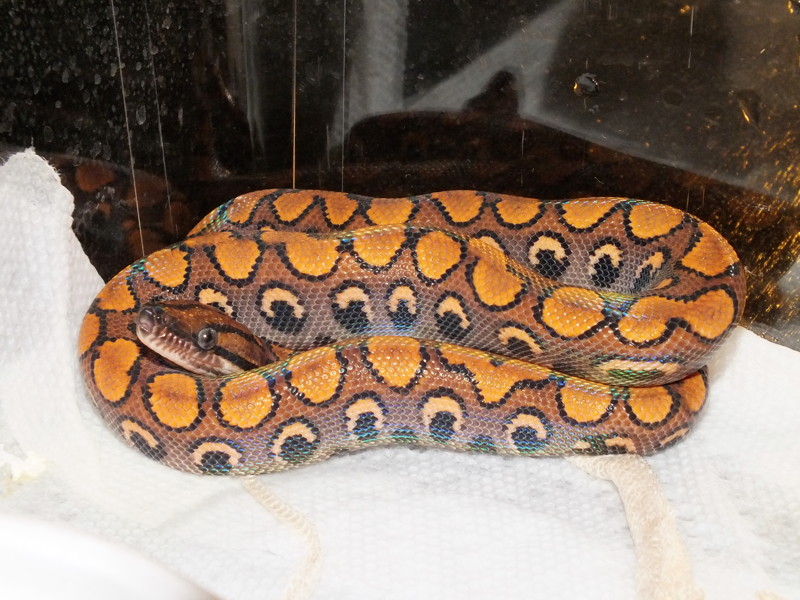 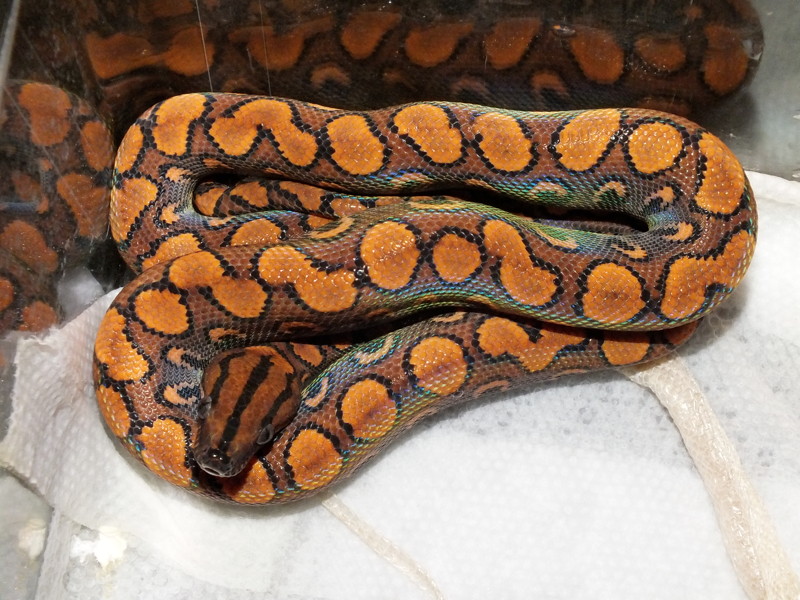 Six-Month Update These shots were taken in March 2012, and present a further updated view of the baby after the delay. This mini-set includes a front/side shot, a top shot, and a close-up head shot. 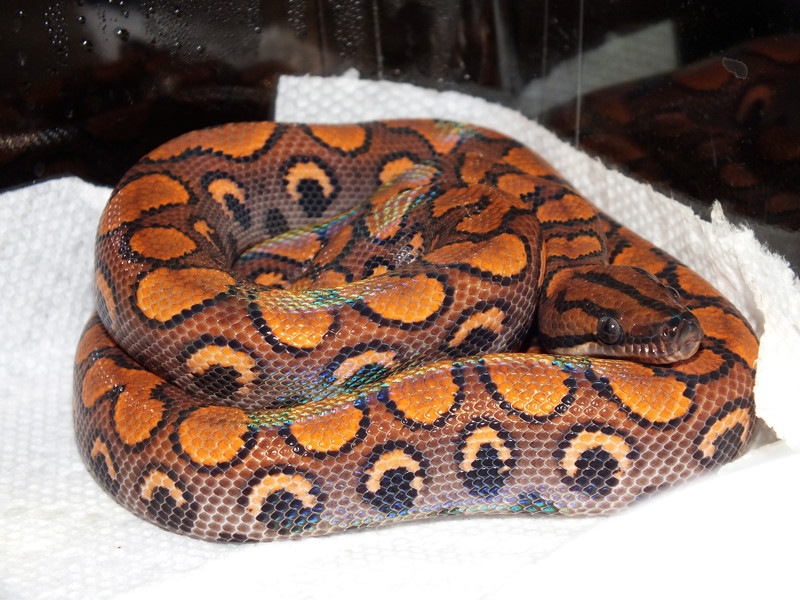 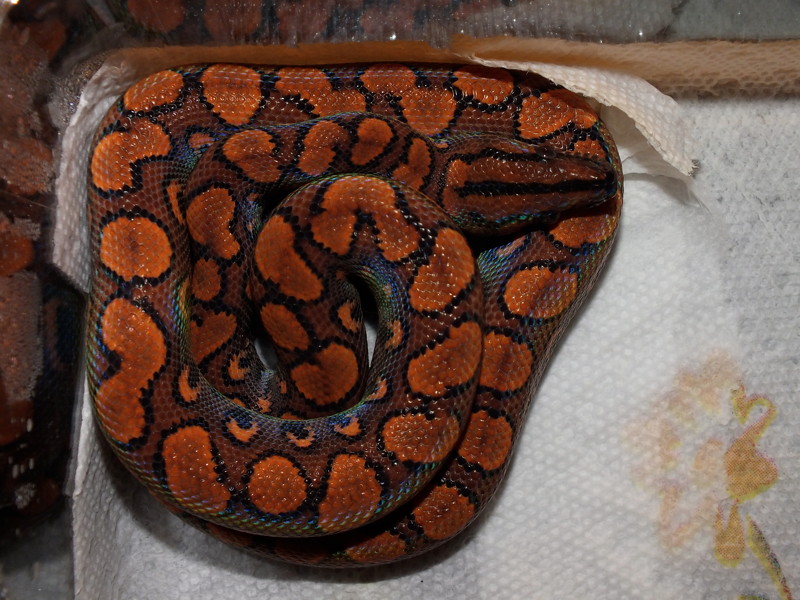 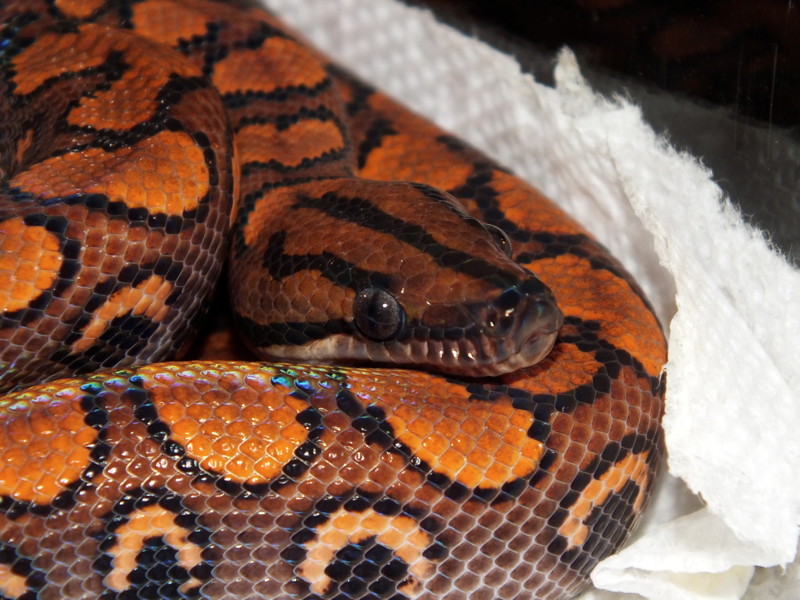 As of March 31, this little one had increased from a birth weight of 32 grams to 101 grams. ------ B-05 (Female) This little gem is my lead female holdback candidate. She’s fairly placid now, but early on in our “friendship” she was so eager to get at me she actually bit herself in her rush to connect! During a recent handling session, she was very calm but highly energetic, exploring my arm as we worked and finally wrapping herself around left wrist like a small colorful bracelet. Coolest of all, out of all the litter, she is one that inherited her sire’s love of climbing -- she heads right for my glasses and the top of my head like a human jungle gym every chance she gets. Physically, she has several unique traits. On her back, she has two linked chains of two spots, and another long row of seven touching dots that could be moldable into a chain with breeding. On her right side, she has a 100% crescent pattern. On her left side, she has one departure from an otherwise solid crescent pattern, a merged spot. Finally, she an interesting little black “eight” pattern on her back. At Birth This shot was taken in mid-September 2011. 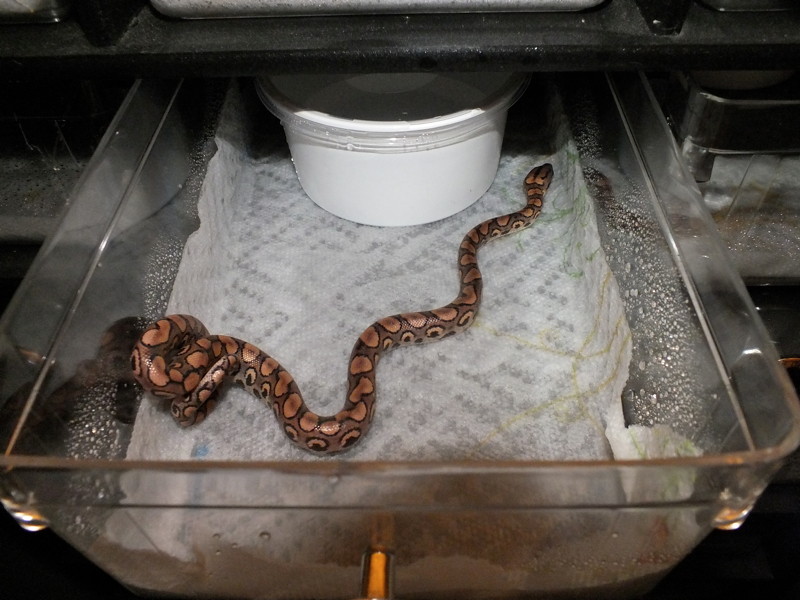 Post Shed This shot was taken in late September 2011. Apologies for the bad lighting; it was taken without formal prep. 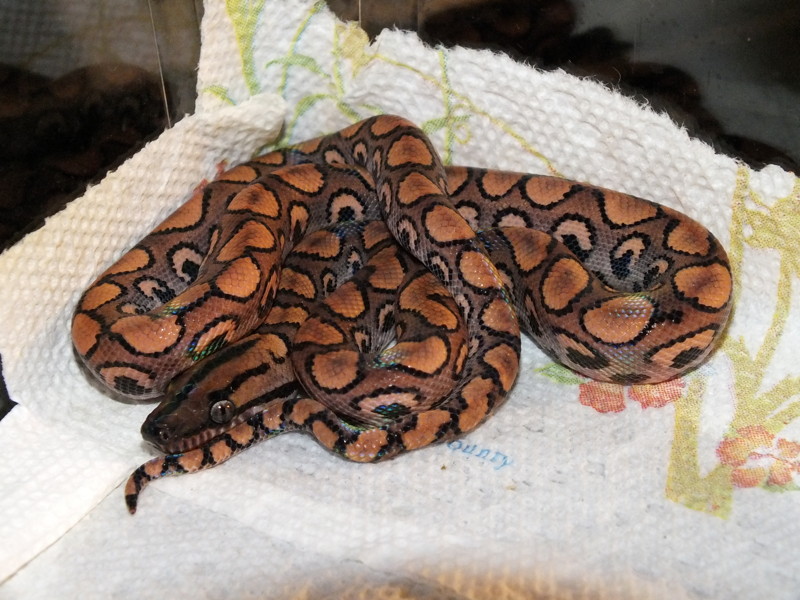 Formal Photo Session This series of shots was taken in early October 2011. Originally, these were to be the sale shots, but circumstances forced a long delay. This mini-set includes a front/right shot, a front/left shot, and a top shot. 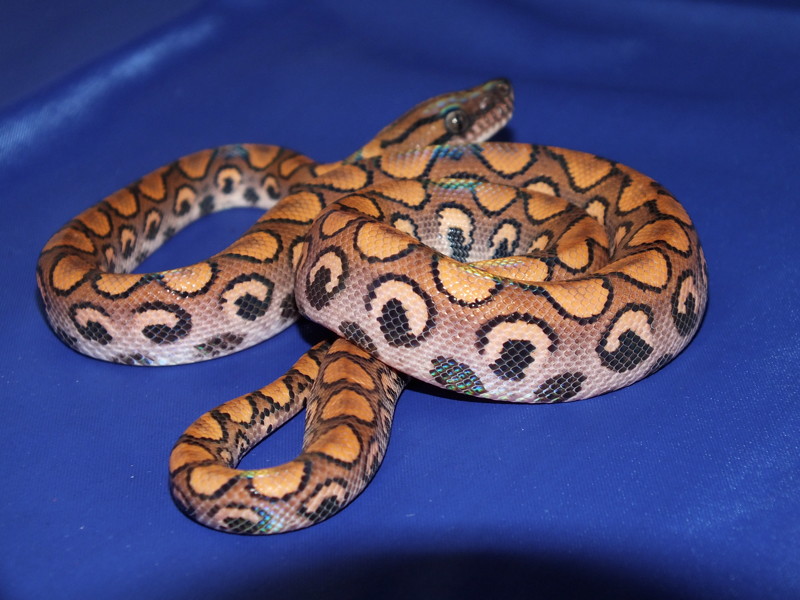 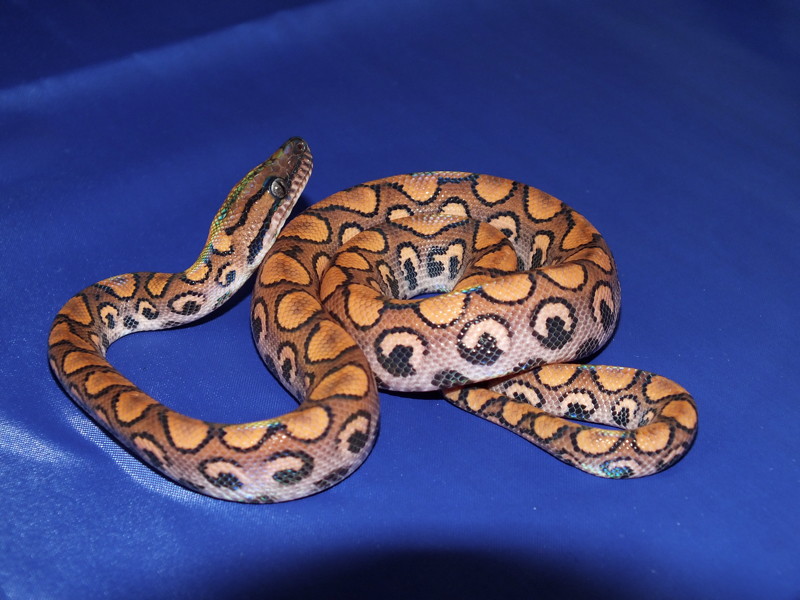 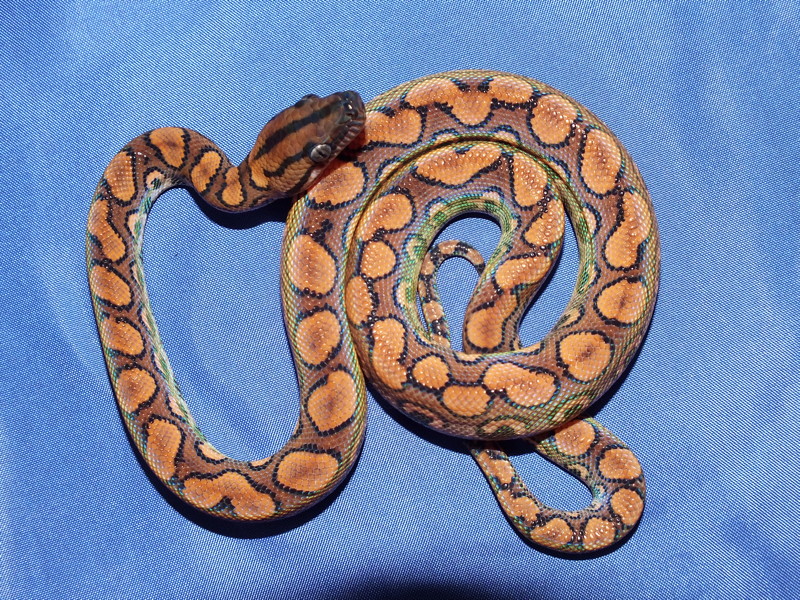 Three-Month Update These shots were taken in late December 2011 to late January 2012, and present an updated view of the baby after the delay. This mini-set includes a front/side shot and a top shot.  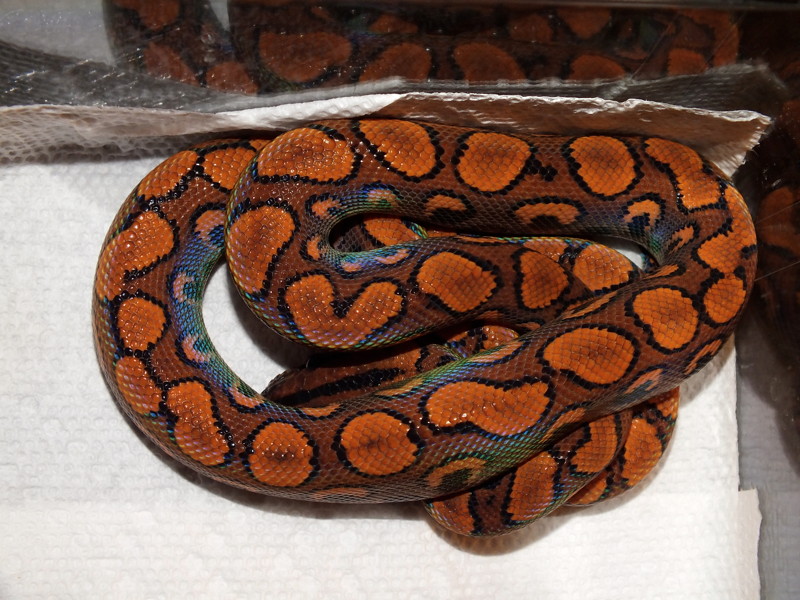 Six-Month Update These shots were taken in March 2012, and present a further updated view of the baby after the delay. This mini-set includes a front shot and a top shot. 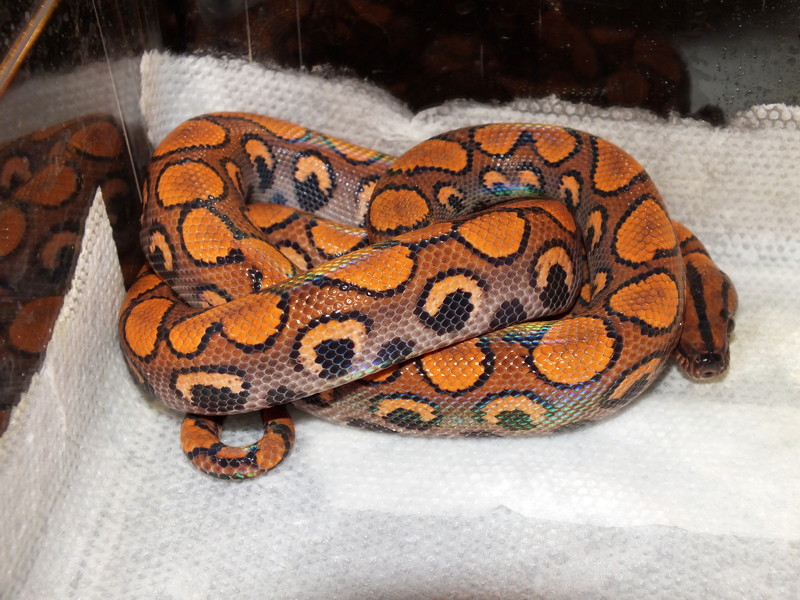 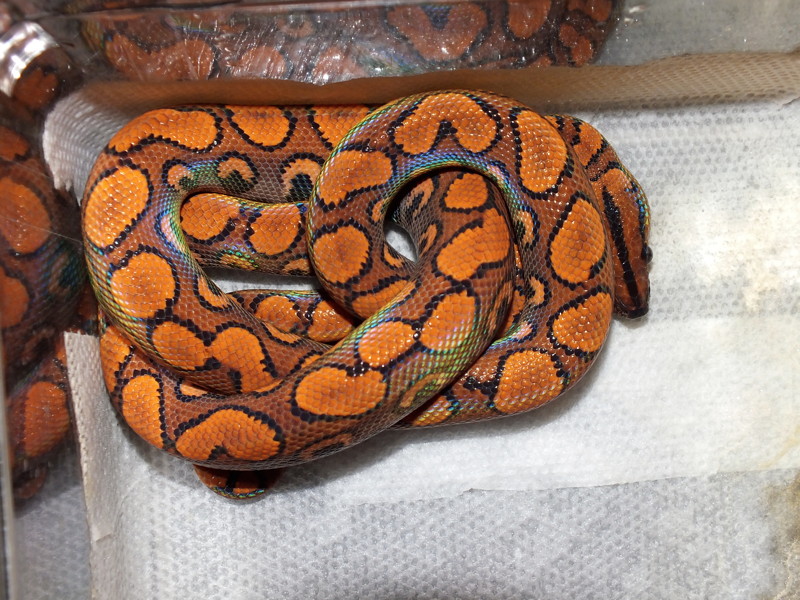 As of March 31, this little one had increased from a birth weight of 33 grams to 105 grams. ------ B-06 (Male) This fellow was one of the more placid members of his litter…right up until sexing day, the idea of which thrilled him not at all. Let’s just say he made up for lost time that evening. Sine then he’s settled back into his usual placid little self. Physically, he has several unique traits. On his back, he has two linked chains of two spots. On his right side, he has two departures from an otherwise solid crescent pattern, one eclipse and one merged dot, both in his neck area. On his left side, he also has two departures, one eclipse near his neck and one merged dot farther back. Finally, he has an interesting light patch on his lower right head, and a small black dot on his neck. At Birth This shot was taken in mid-September 2011. 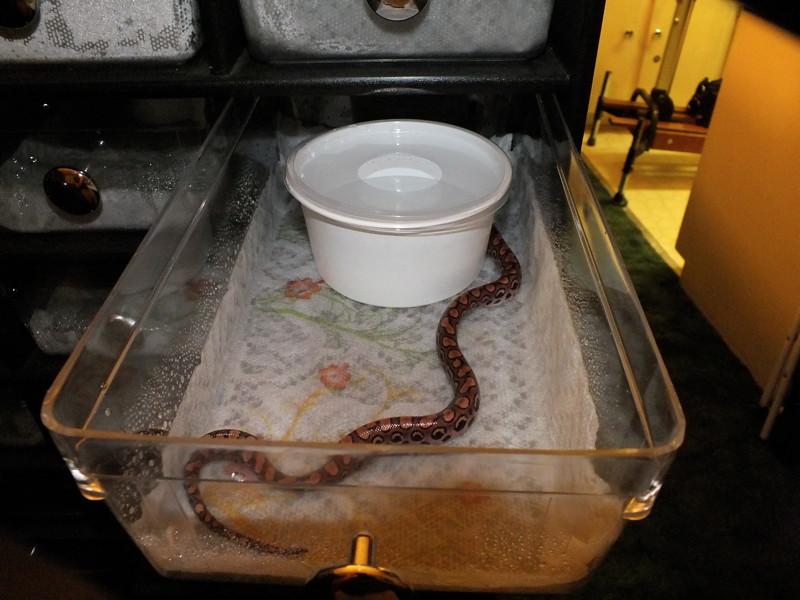 Post Shed This shot was taken in late September 2011. Apologies for the bad lighting; it was taken without formal prep. 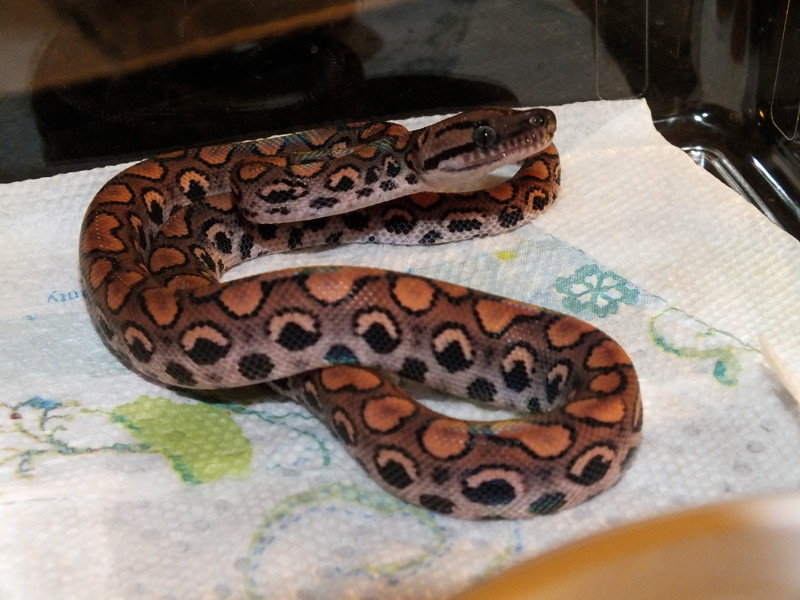 Formal Photo Session This series of shots was taken in early October 2011. Originally, these were to be the sale shots, but circumstances forced a long delay. This mini-set includes a front/right shot, a front/left shot, and a top shot.  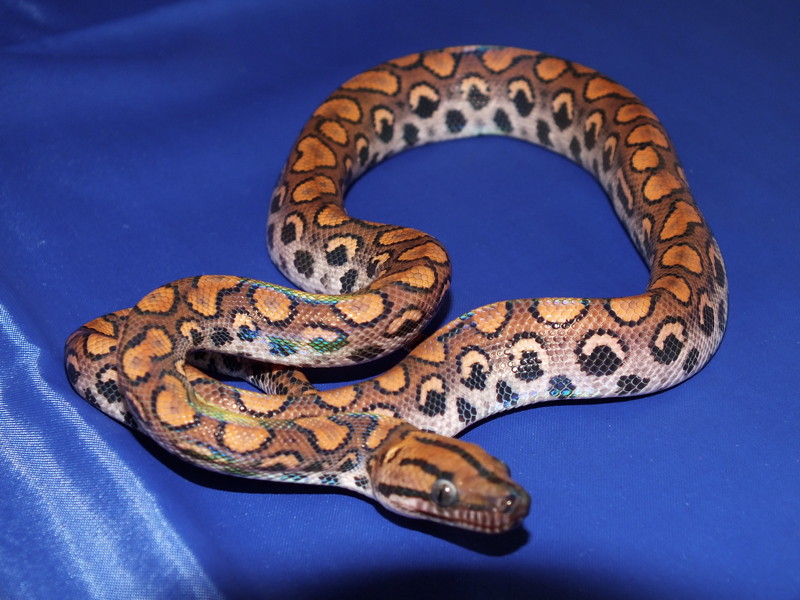  Three-Month Update This shot was taken in late December 2011 to late January 2012, and presents an updated view of the baby after the delay.  Six-Month Update These shots were taken in March 2012, and present a further updated view of the baby after the delay. This mini-set includes a front shot, a top shot, and a close-up head shot. 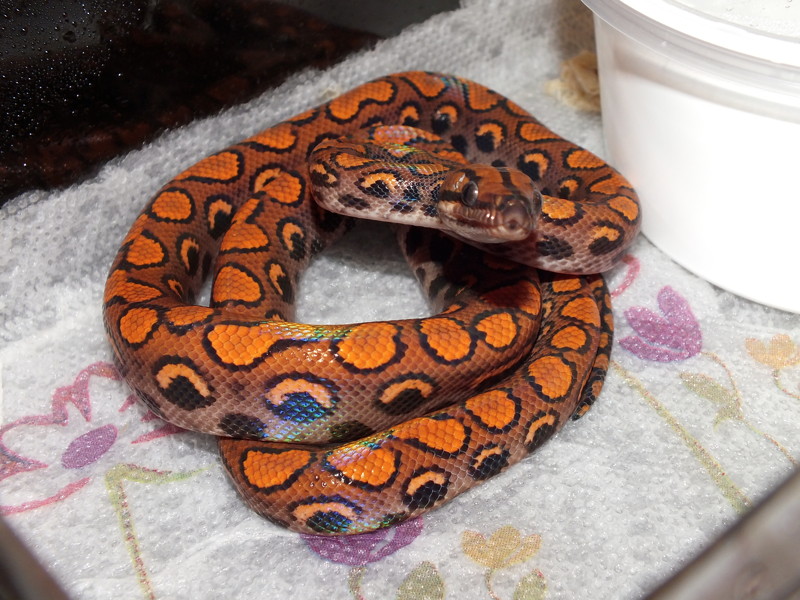 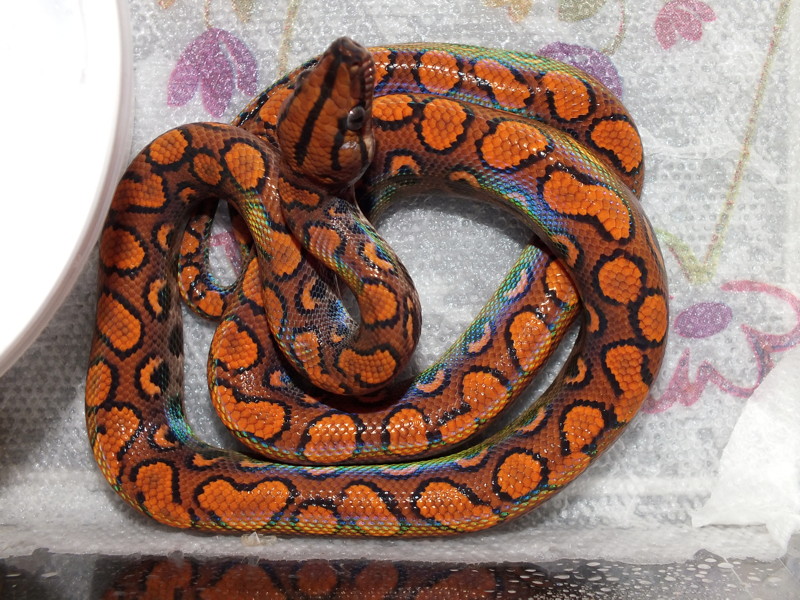 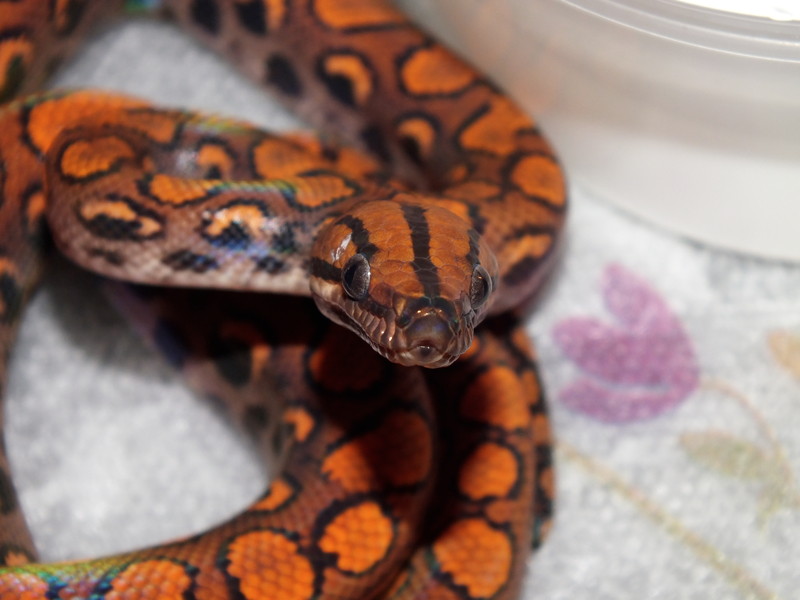 As of March 31, this little one had increased from a birth weight of 33 grams to 85 grams. ------ B-07 (Female) A perfectly normal, curious little female, this little lady has not revealed any personality quirks so far…though I’m sure she, as all baby Brazilians, has some just waiting to be discovered! Physically, she has several unique traits. On her back, she has two linked chains of three and two spots, respectively. On her left side, she has a 100% crescent pattern. On her right side, she has two departures from an otherwise solid crescent pattern: one merged dot and a series of three “bonus” black dots. Finally, she has an intriguing small black patch on her center line. At Birth This shot was taken in mid-September 2011. 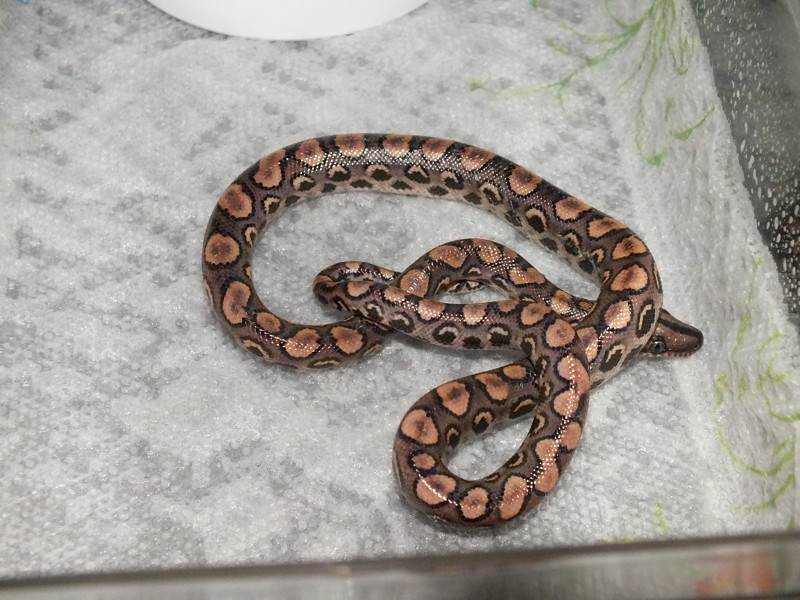 Post Shed This shot was taken in late September 2011. Apologies for the bad lighting; it was taken without formal prep. 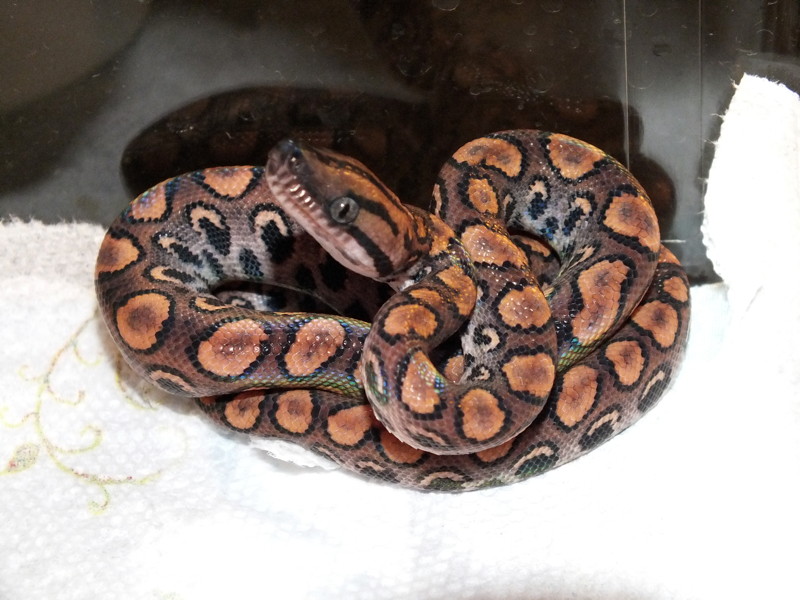 Formal Photo Session This series of shots was taken in early October 2011. Originally, these were to be the sale shots, but circumstances forced a long delay. This mini-set includes a front shot, a side shot, and a top shot. 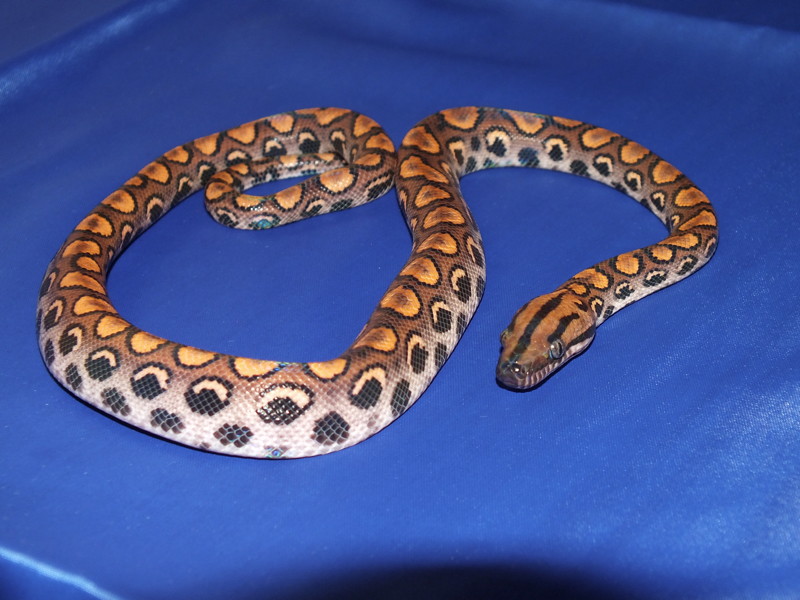 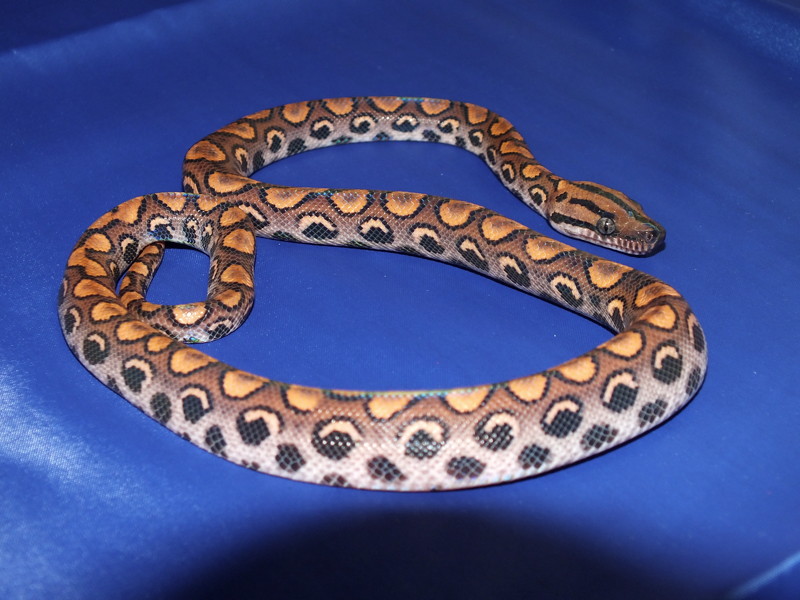  Three-Month Update These shots were taken in late December 2011 to late January 2012, and present an updated view of the baby after the delay. This mini-set includes a front shot and a top shot. 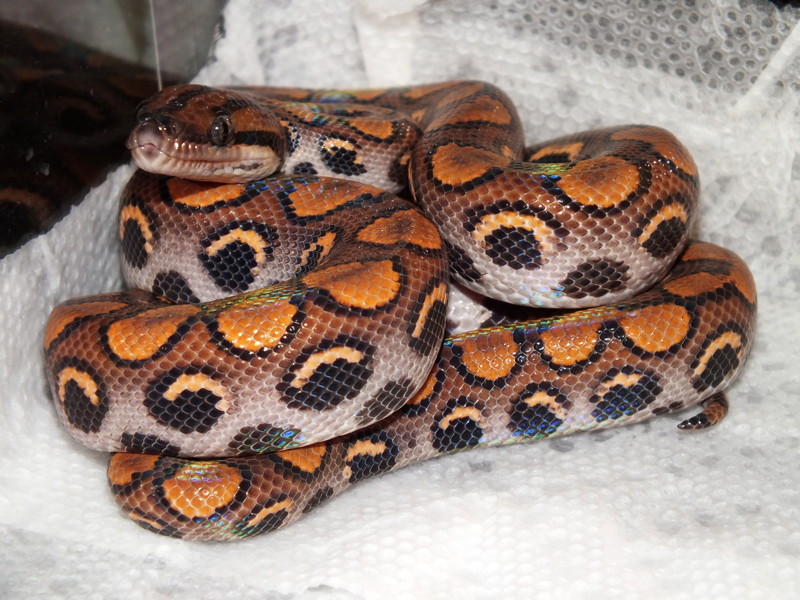 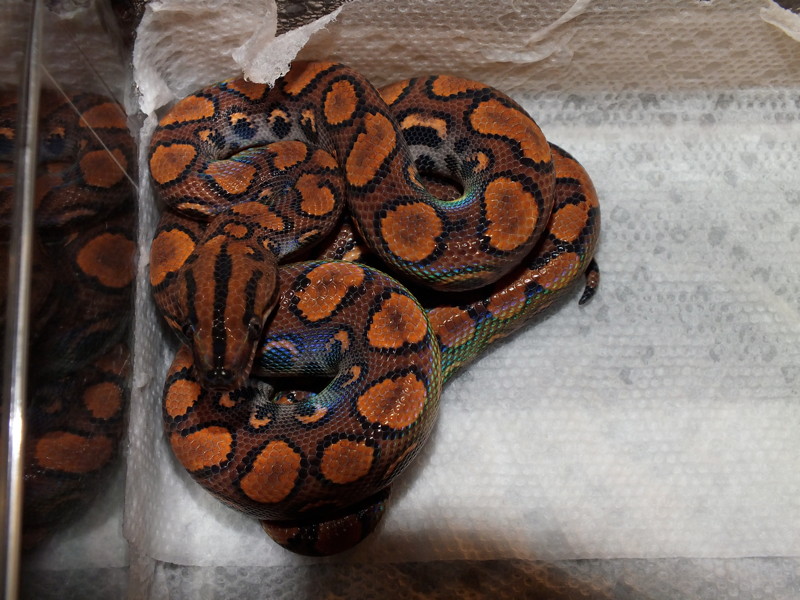 Six-Month Update These shots were taken in March 2012, and present a further updated view of the baby after the delay. This mini-set includes a side shot and a top shot.  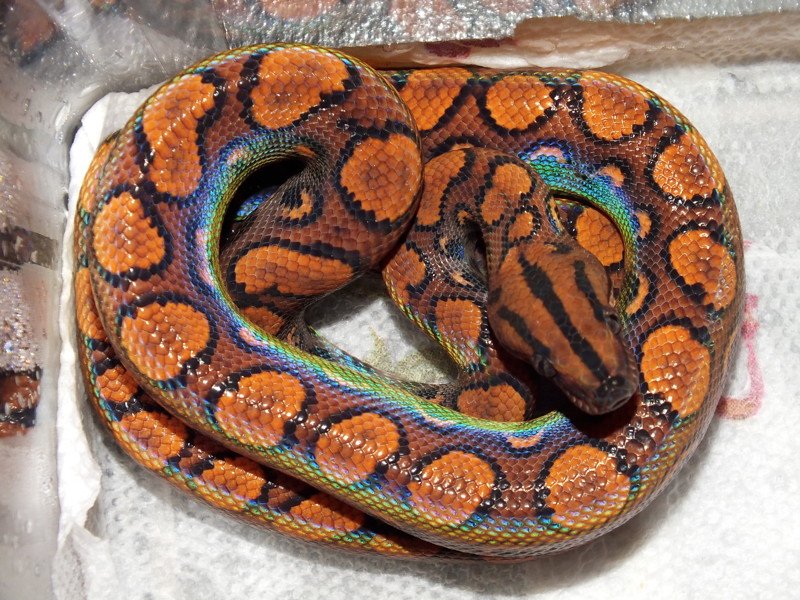 As of March 31, this little one had increased from a birth weight of 31 grams to 87 grams. ------ B-08 (Male) This little fellow is my lead male holdback candidate. He is one of the most calm and inquisitive babies in the litter. He was one of the first to move from “discovering” his meal to figuring out striking is good, and is now always front and center on feeding day! Physically, he has several unique traits. On his back, he has mad linking going on: one chain of three spots, five chains of two spots, and a massive line of touching spots that should merge with breeding. On his sides, he has a 100% crescent pattern -- a clean, classic look all the way -- with the single exception of a small Nike-ish “swoosh” on his right side. (Hmm, marketing deal?) At Birth This shot was taken in mid-September 2011. 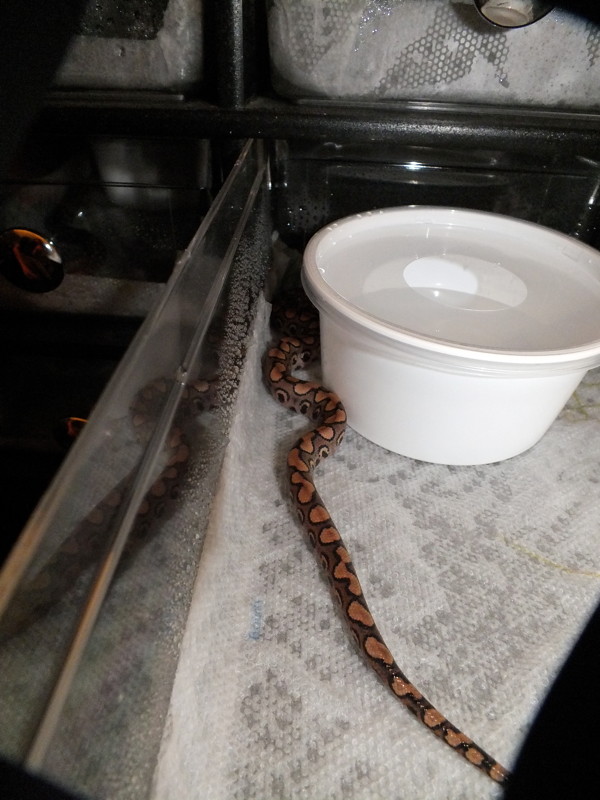 Post Shed This shot was taken in late September 2011. Apologies for the bad lighting; it was taken without formal prep.  Formal Photo Session This series of shots was taken in early October 2011. Originally, these were to be the sale shots, but circumstances forced a long delay. This mini-set includes a front shot, a side shot, and a top shot. 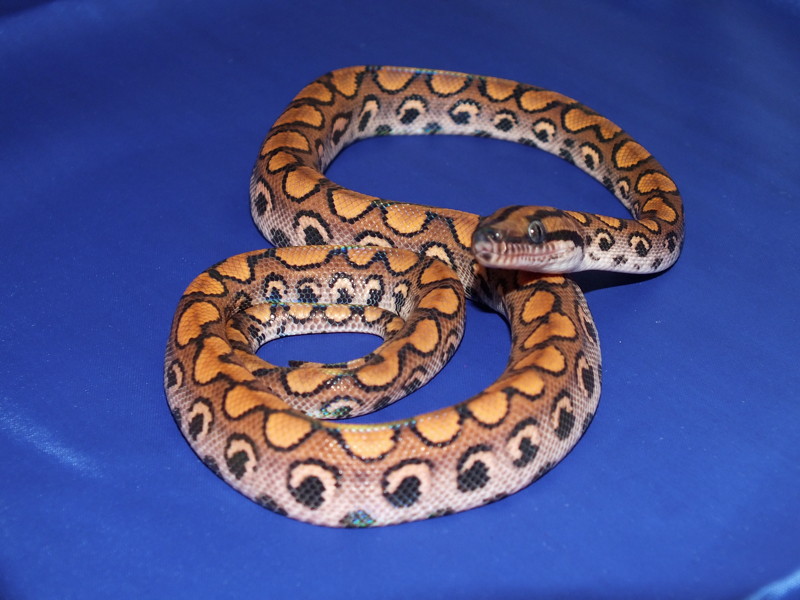   Three-Month Update These shots were taken in late December 2011 to late January 2012, and present an updated view of the baby after the delay. This mini-set includes a side shot and a top shot.  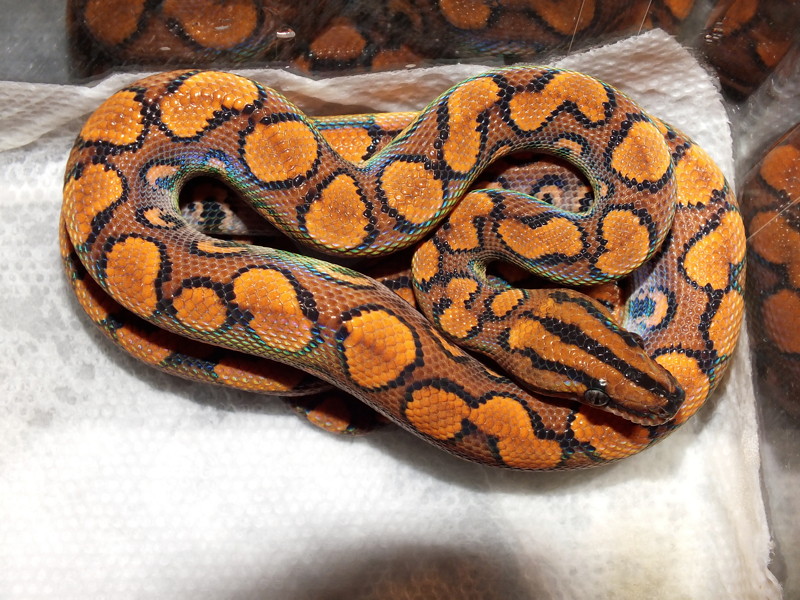 Six-Month Update These shots were taken in March 2012, and present a further updated view of the baby after the delay. This mini-set includes a side shot and a top shot. 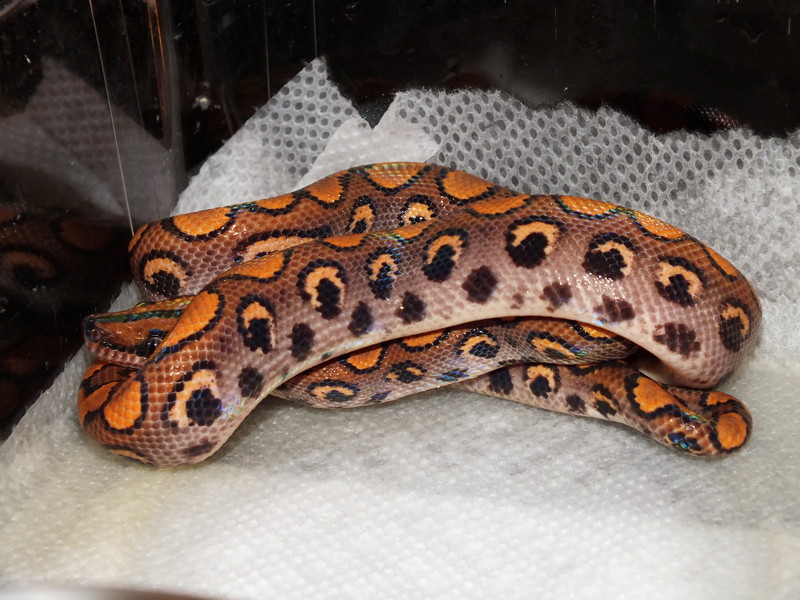 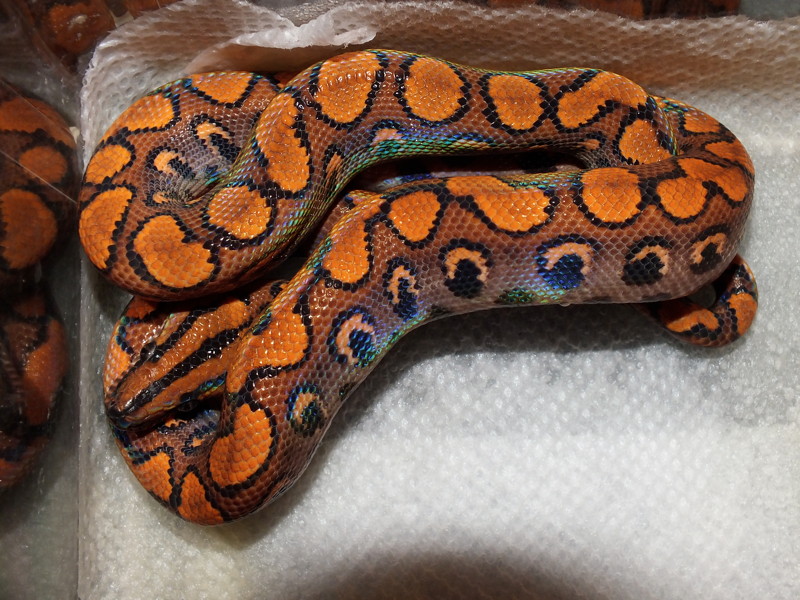 As of March 31, this little one had increased from a birth weight of 34 grams to 92 grams. ------ B-09 (Female) Like her brother #08, this little one is both calm and inquisitive. She was also one of the first to move from “discovering” her meal to figuring out striking is good! Physically, this little one has several unique traits. On her back, she has five linked chains of two spots, and eight or nine touching dots that could be moldable into a chain with breeding. On her left side, she has a 100% crescent pattern. On her right side, she has three departures from an otherwise solid crescent pattern, all merged dots. Finally, she has a small black dot on her neck. At Birth This shot was taken in mid-September 2011.  Post Shed This shot was taken in late September 2011. Apologies for the bad lighting; it was taken without formal prep. 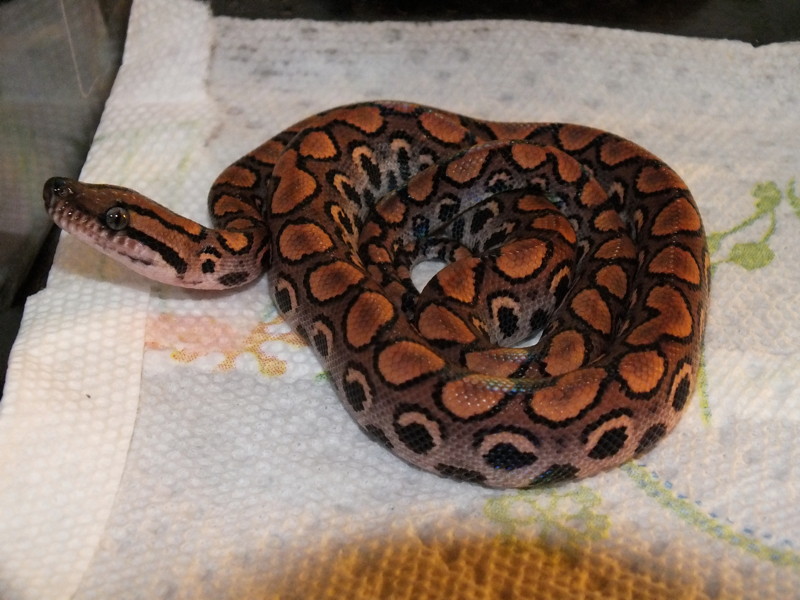 Formal Photo Session This series of shots was taken in early October 2011. Originally, these were to be the sale shots, but circumstances forced a long delay. This mini-set includes a front shot, a side shot, a top shot, and a close-up head shot.  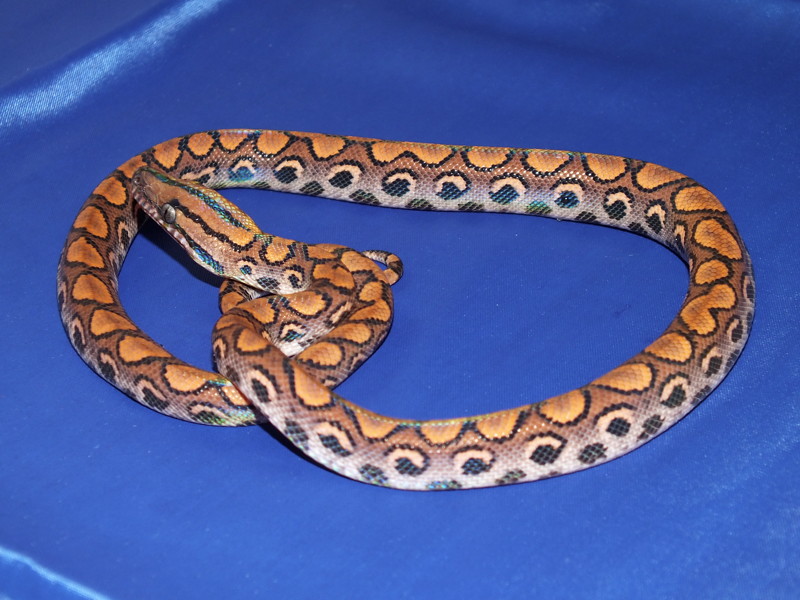 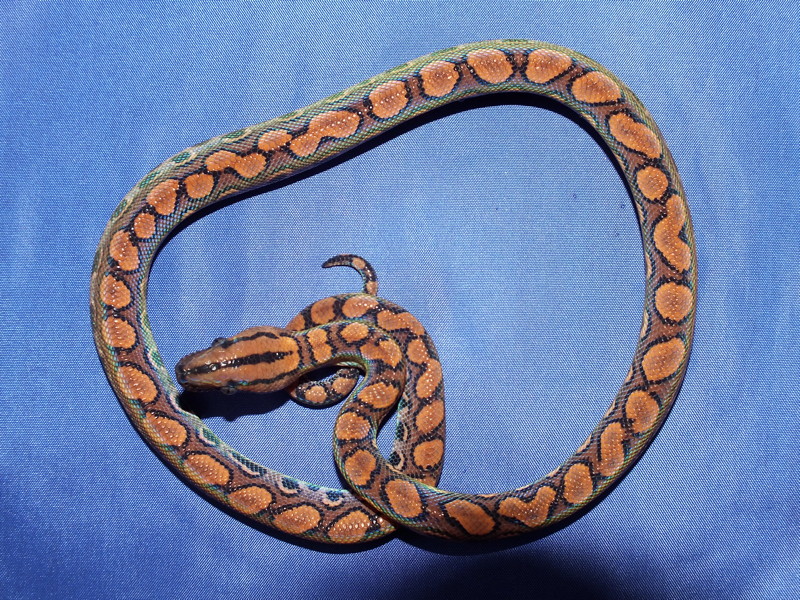  Three-Month Update These shots were taken in late December 2011 to late January 2012, and present an updated view of the baby after the delay. This mini-set, taken in the scale because she was being squirmy, includes a top shot and paired head/body shots.  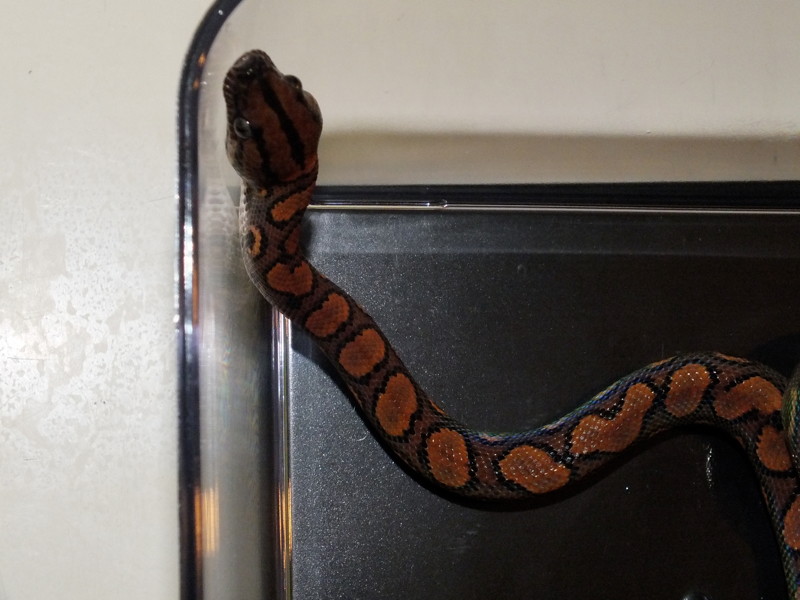 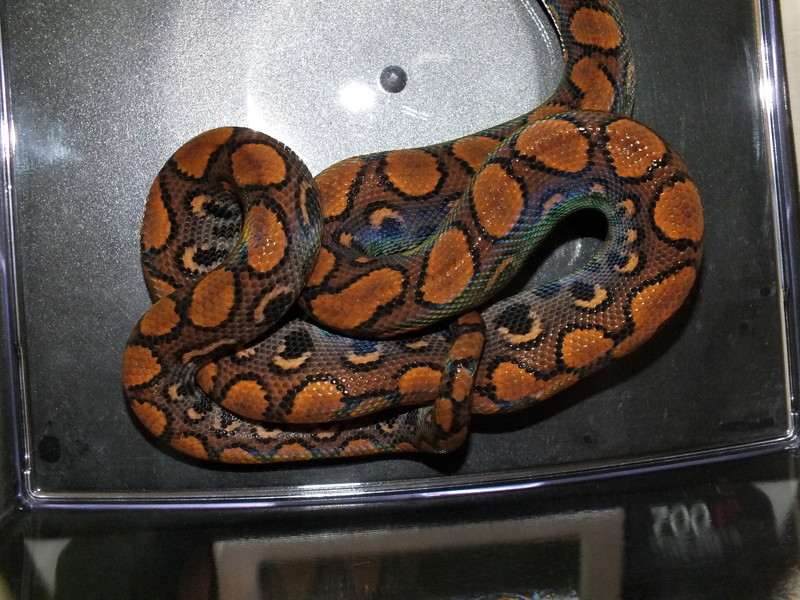 Six-Month Update These shots were taken in March 2012, and present a further updated view of the baby after the delay. This mini-set includes a front shot, a top shot, and a head/upper body shot. Note the first shot came out oddly dark. 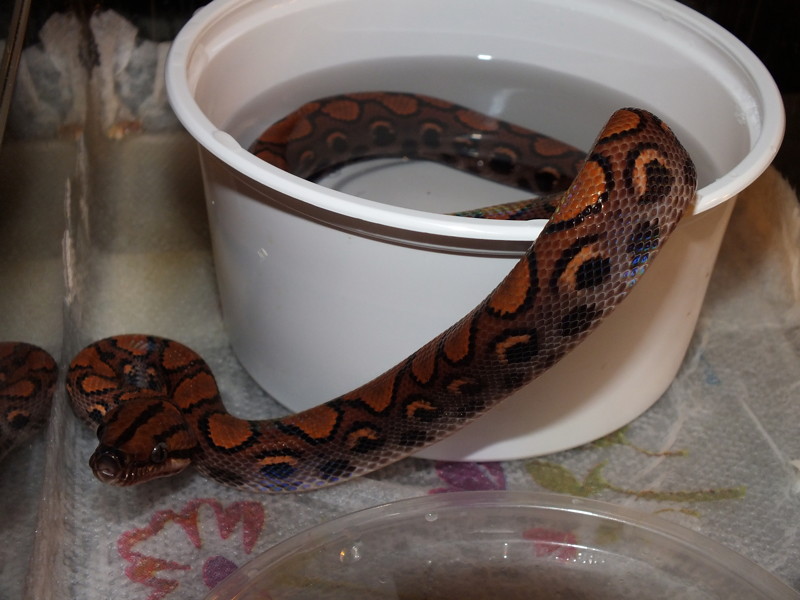 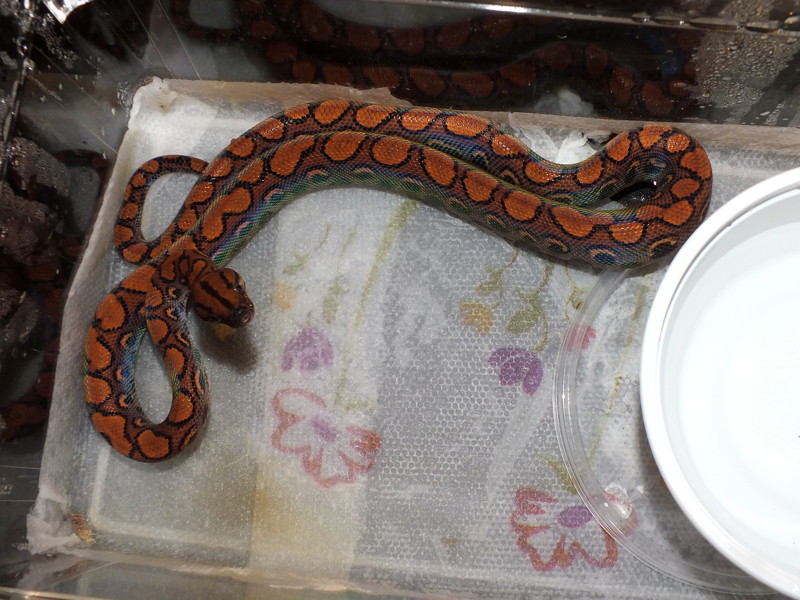  As of March 31, this little one had increased from a birth weight of 33 grams to 87 grams. ------ B-10 (Female) This little girl was both amazingly calm and amazingly active during the pattern inspection -- constantly curious and on the move while I looked her over. She also holds the “bathroom mess” award of her litter, once managing to sully her entire drawer within 24 hours of its being cleaned. Physically, she has several unique traits. Her dorsal borders lines are rather broken and irregular, especially in her neck area, which make counting difficult. Nevertheless, she has two linked chains of three and two spots, respectively. On her left side, she has a 100% crescent pattern, and the black portion of one of these travels down to fuse with the nearby bottom half-spot. On her right side, she has one departure from an otherwise solid crescent pattern, a merged dot. Finally, she has a medium black triangle on her lower back, a mark taken straight from her sire. At Birth These shots were taken in mid-September 2011. The first shot was taken shortly after birth, and captured her practicing her gymnastics skills. 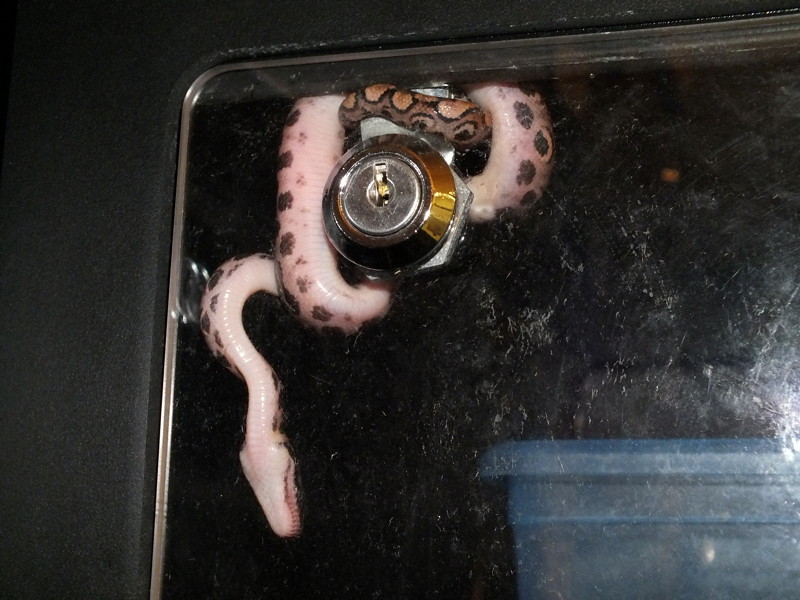 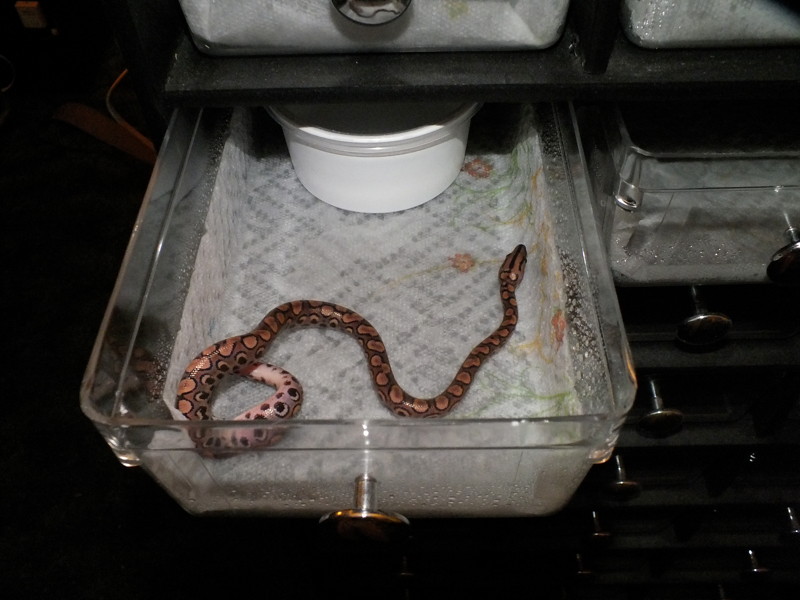 Post Shed This shot was taken in late September 2011. Apologies for the bad lighting; it was taken without formal prep. 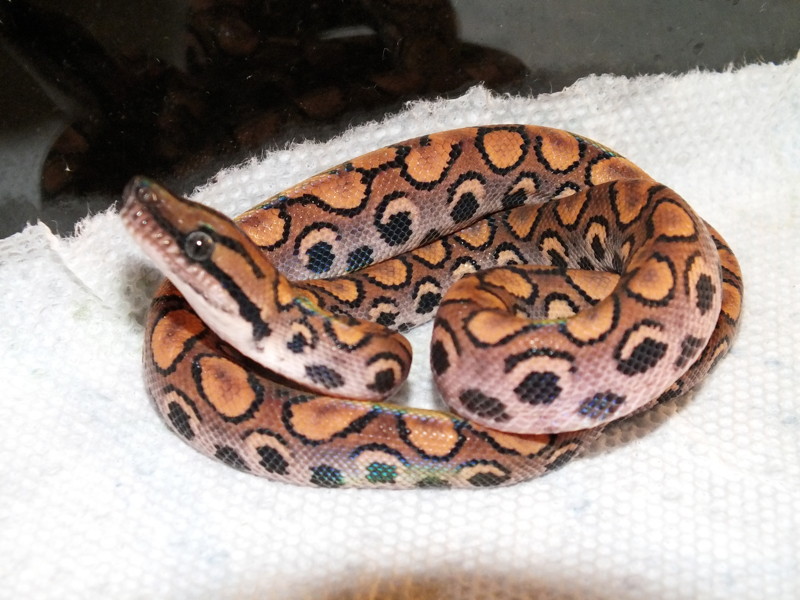 Formal Photo Session This series of shots was taken in early October 2011. Originally, these were to be the sale shots, but circumstances forced a long delay. This mini-set includes a side shot, a back shot, a top shot, and a close-up head shot. 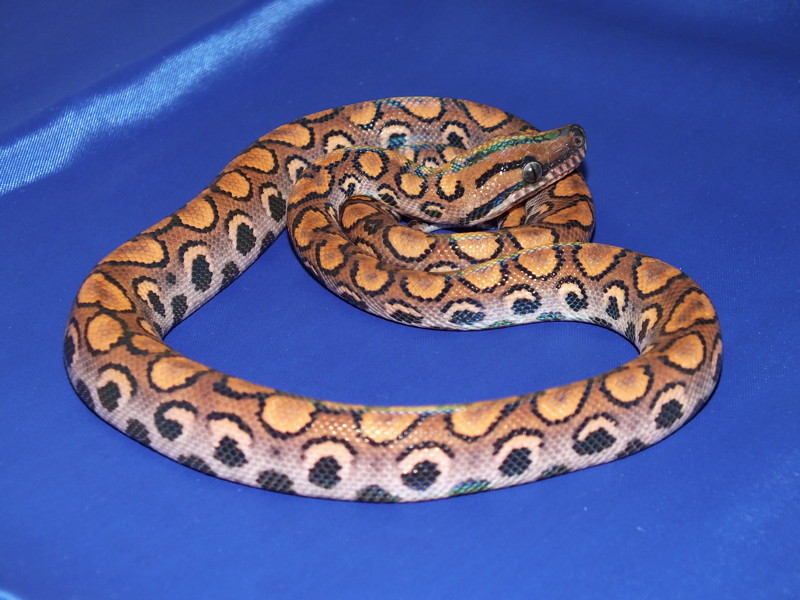 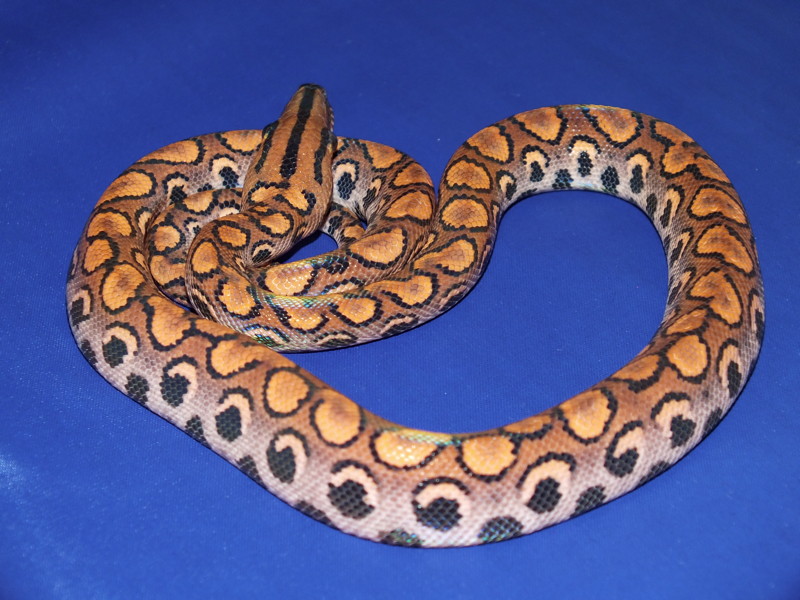  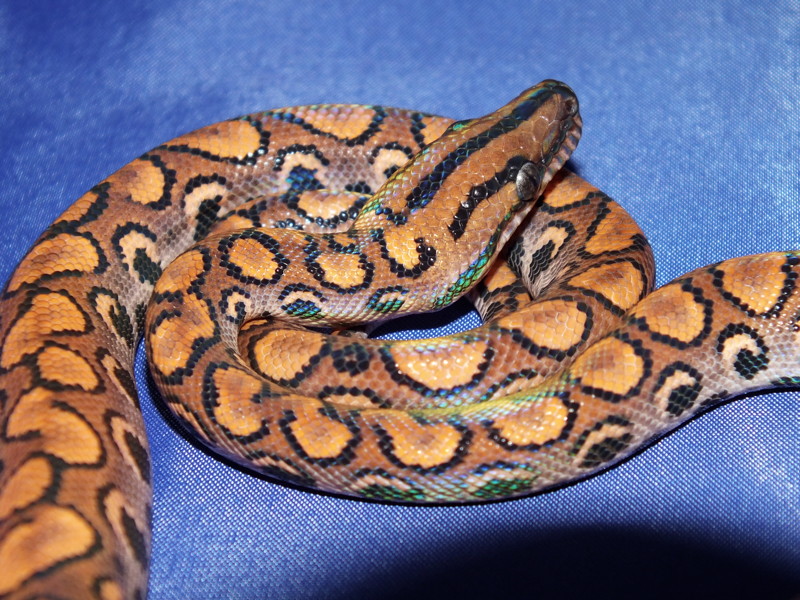 Four-Month Update These shots were taken in late December 2011 to late January 2012, and present an updated view of the baby after the delay. This mini-set includes a side shot and a top shot.  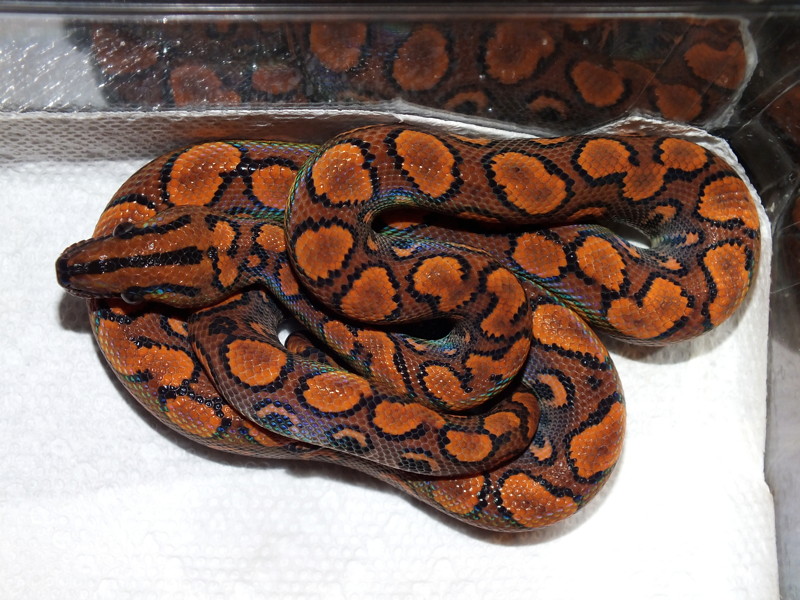 Six-Month Update These shots were taken in March 2012, and present a further updated view of the baby after the delay. This mini-set includes a front shot, a top shot, and a close-up head shot. 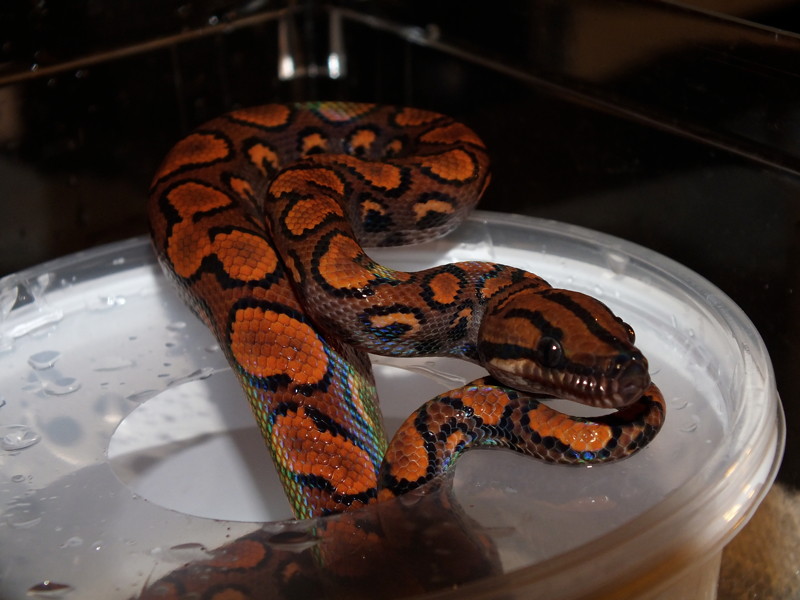 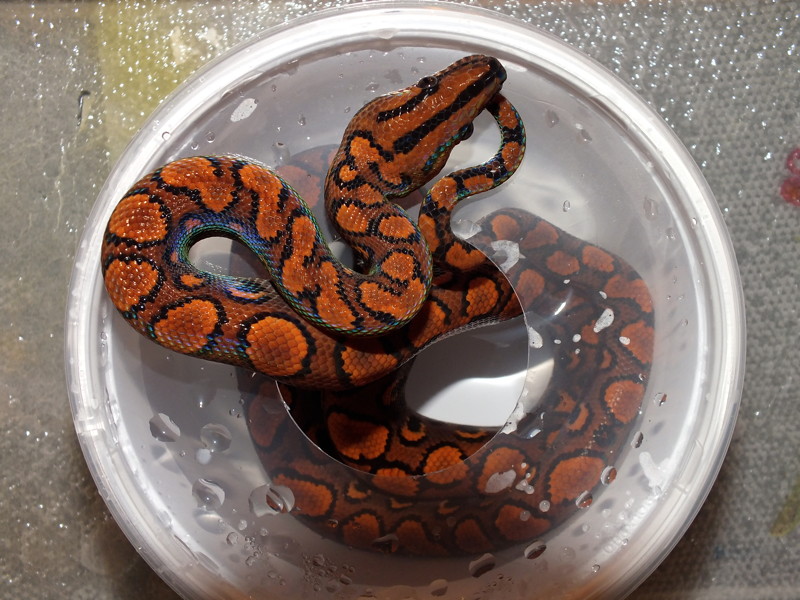 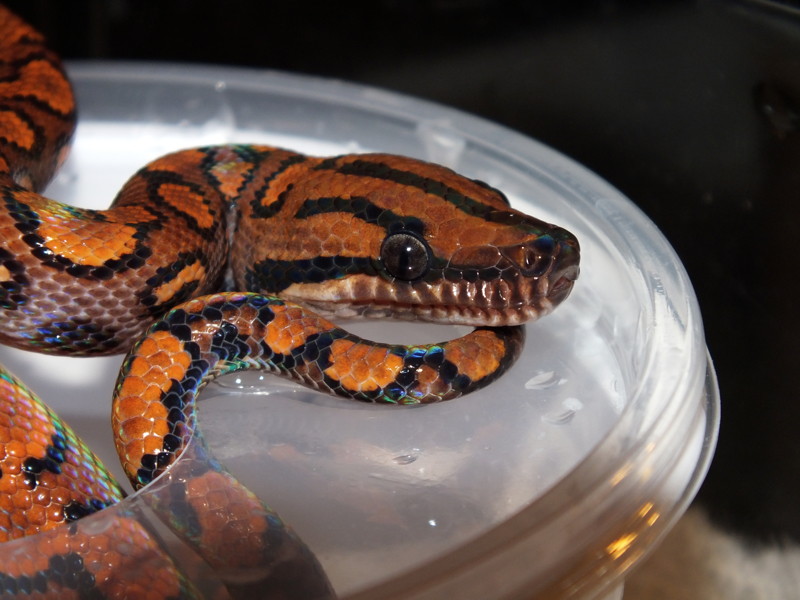 As of March 31, this little one had increased from a birth weight of 33 grams to 87 grams. ------ B-11 (Male) This little guy is another of the calm but active ones, who would not sit still during the pattern inspection, or many cleaning sessions. Physically, he has several unique traits. He has a lighter-colored head, which can be an indicator of good things to come On his back, he has a whopping five linked chains of four spots (once), three spots (once), and two spots (thrice), respectively. On his right side, he has a 100% crescent pattern (though three of them arguably lean eclipse). On his left side, he has three departures from an otherwise solid crescent pattern, all eclipses. At Birth These shots were taken in mid-September 2011. The first shot was taken shortly after birth, and captured him practicing even more impressive gymnastics skills than his sister. 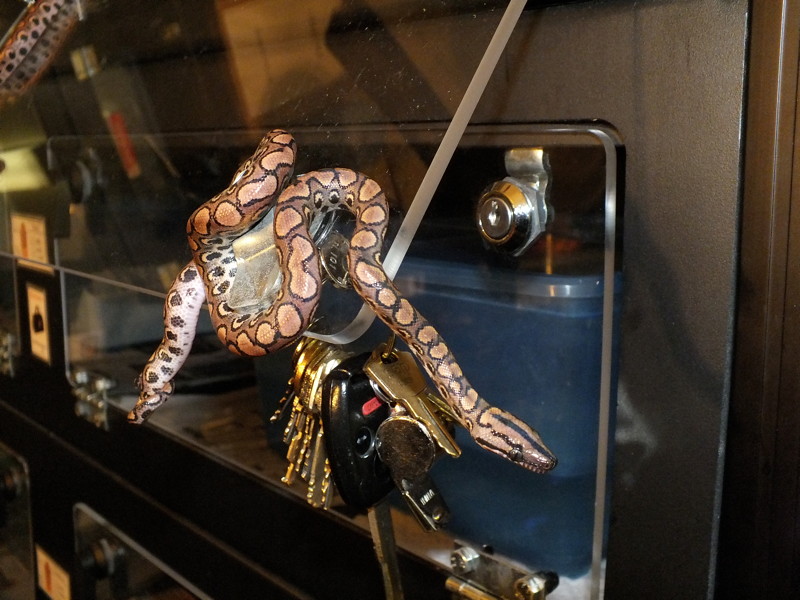 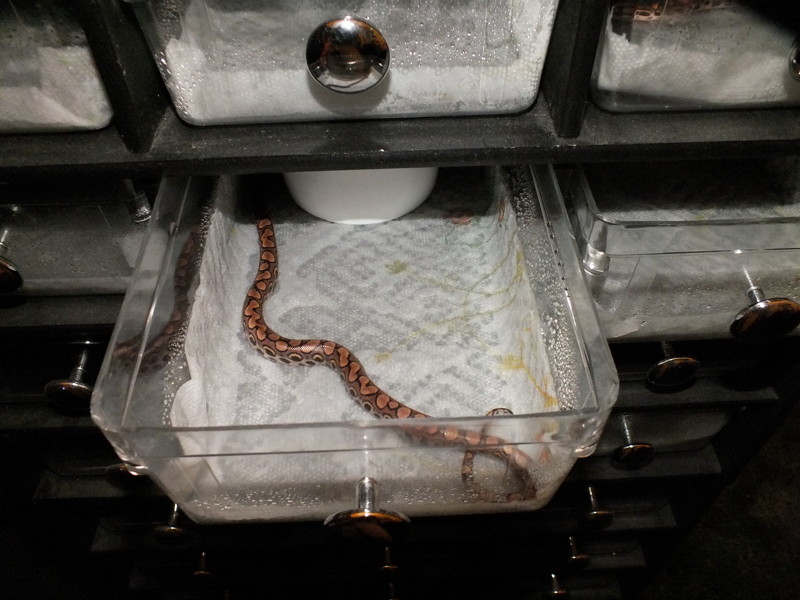 Post Shed This shot was taken in late September 2011. Apologies for the bad lighting; it was taken without formal prep. 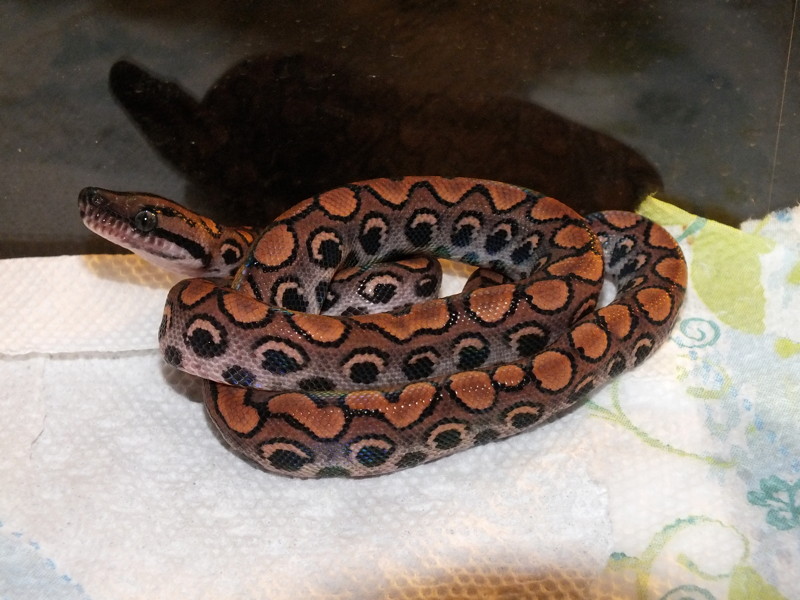 Formal Photo Session This series of shots was taken in early October 2011. Originally, these were to be the sale shots, but circumstances forced a long delay. This mini-set includes a front shot, a side shot, a top shot, and a close-up head shot. 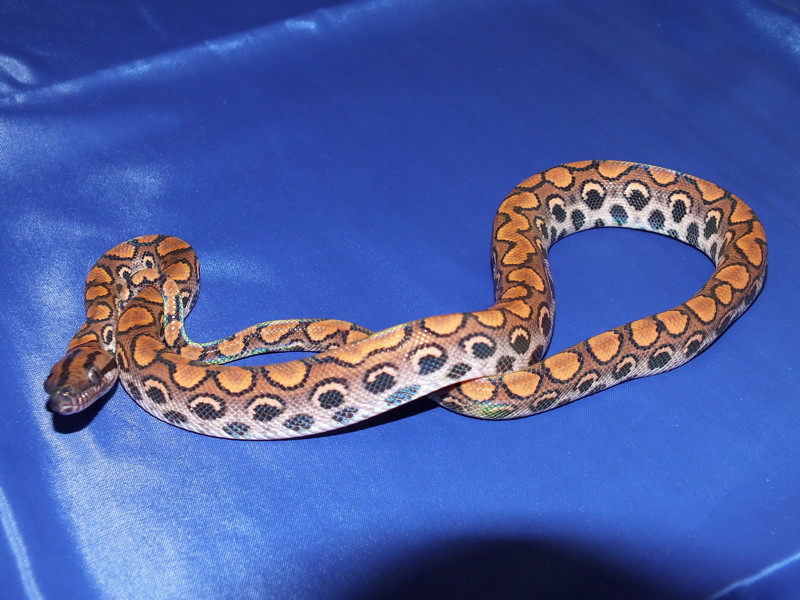 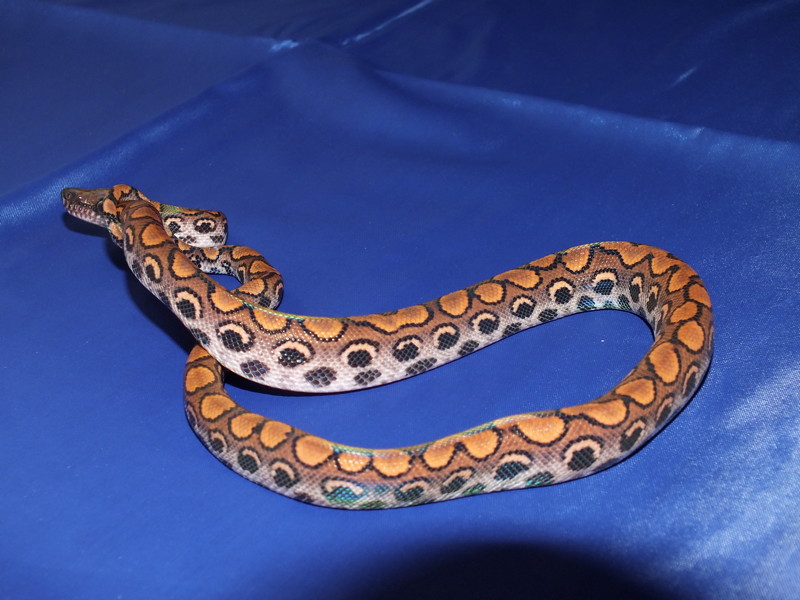 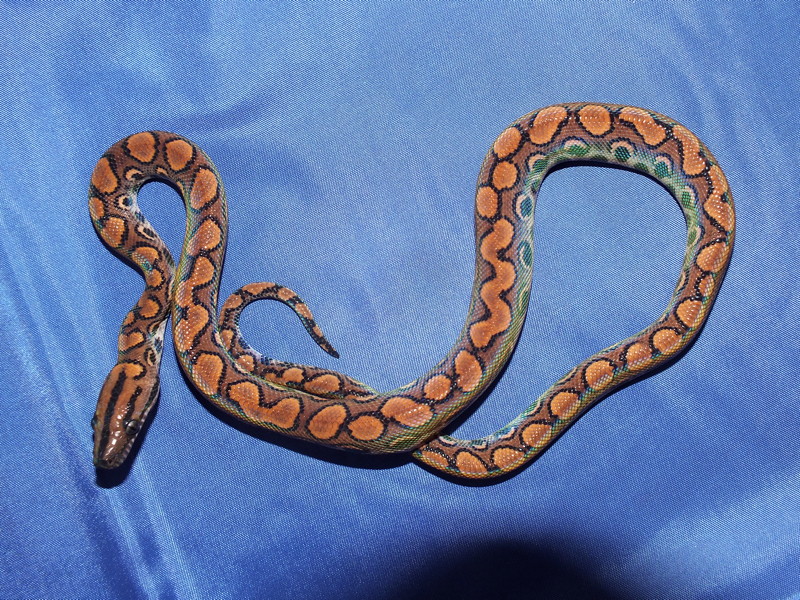 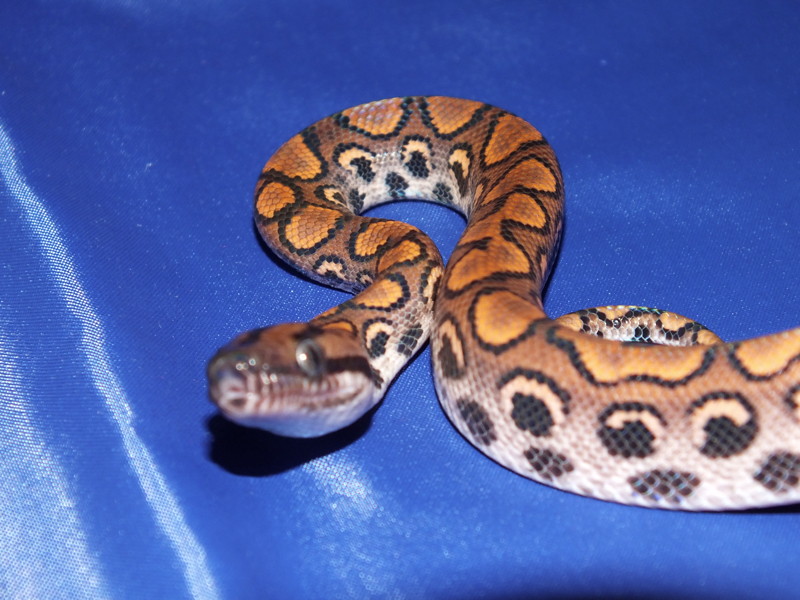 Four-Month Update These shots were taken in late December 2011 to late January 2012, and present an updated view of the baby after the delay. This mini-set includes a front/side shot and a top shot. 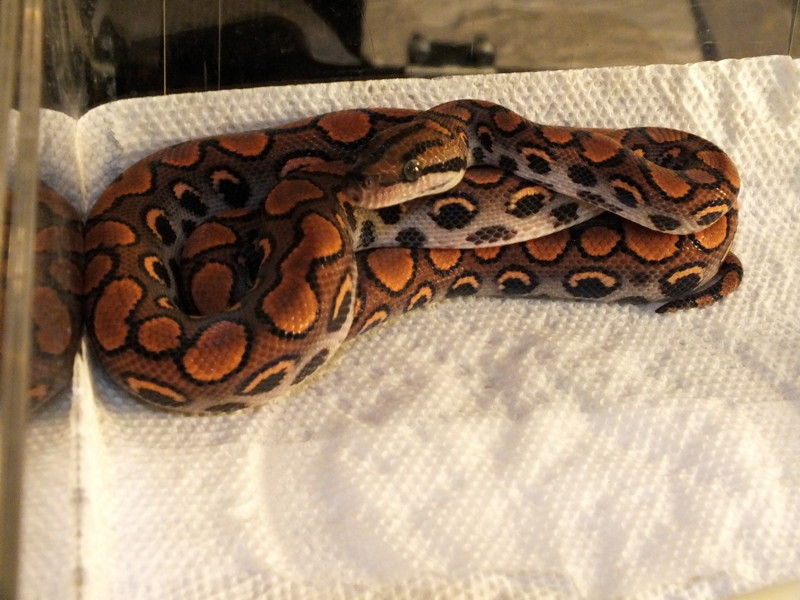 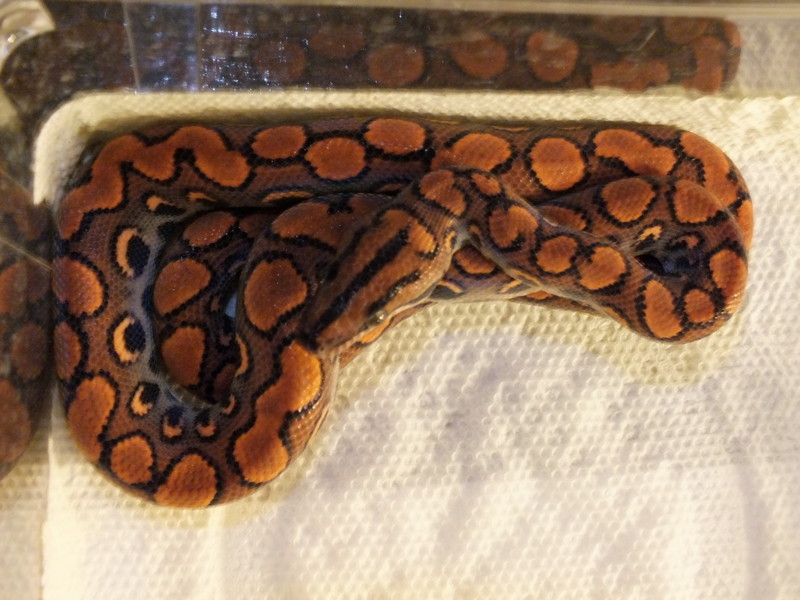 Six-Month Update These shots were taken in March 2012, and present a further updated view of the baby after the delay. This mini-set includes a front/side shot, a top shot, and a close-up head shot.   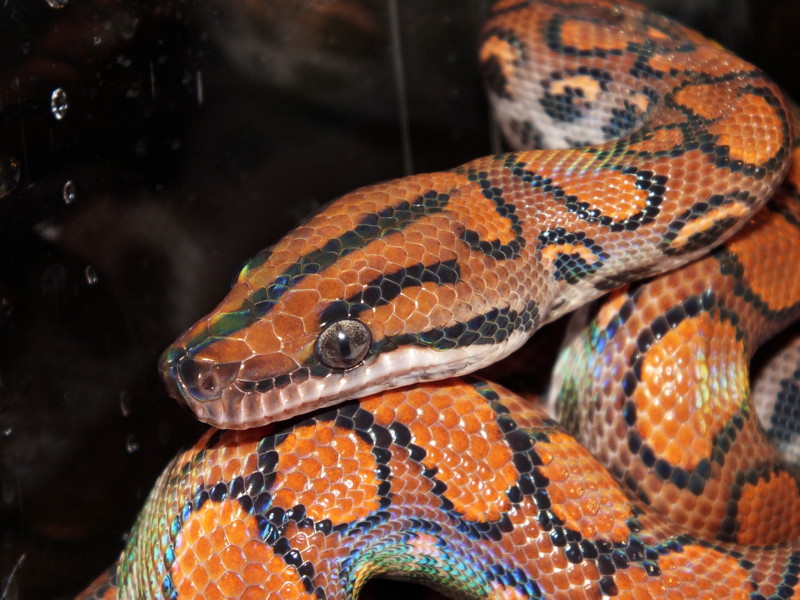 As of March 31, this little one had increased from a birth weight of 34 grams to 90 grams. ------ B-12 (Female) This little lady was one of the spunkiest of her litter for a long time, all wriggle and teeth. With time and care, however, she has calmed down nicely. She is also the pickiest feeder of her litter. Since we started the litter on rats at birth, rats are what she has decided she will eat: I can leave a mouse in there all day, and she will turn her nose up at it; but if I switch it for a rat, the meal is in her belly right away! She will also pass on meals due to impending shed -- perfectly normal, but the only one in her litter to regularly do so. (She has happily accepted “proper” makeup meals in most of these cases, meaning if I follow her very specific “instructions” on prey type.) Physically, she has several unique traits. On her back, she has three to five linked chains of two spots (two are highly probable, depending on how the viewer judges these things). On her sides, she has a 100% crescent pattern -- a clean, classic look all the way. Finally, she has three small black spots on her back (one small on her neck, one small on her back, and one medium on her back), all derived from her sire’s branch of the family tree. At Birth This shot was taken in mid-September 2011. 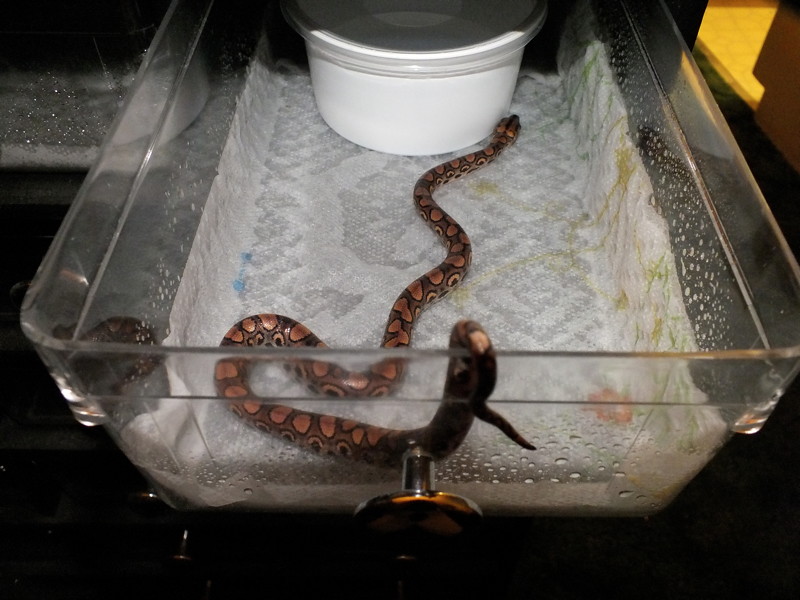 Post Shed This shot was taken in late September 2011. It’s a pretty cute she as she checks out the camera for the first time. Apologies for the bad lighting; it was taken without formal prep. 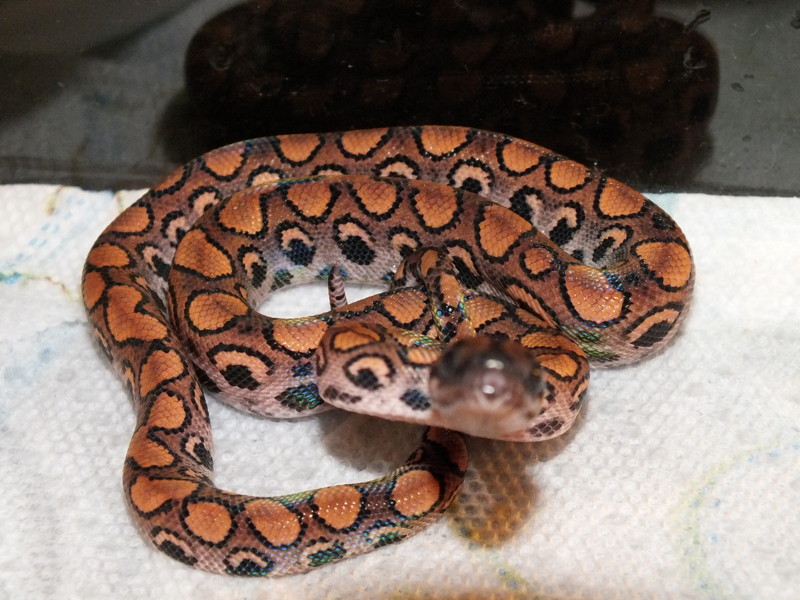 Formal Photo Session This series of shots was taken in early October 2011. Originally, these were to be the sale shots, but circumstances forced a long delay. This mini-set includes a front left shot, a front right shot, a top shot, and a close-up head shot. 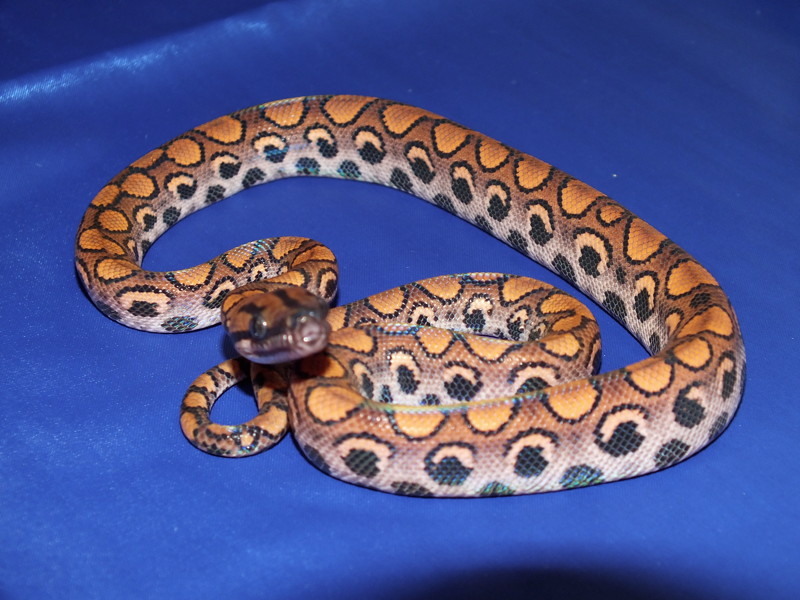 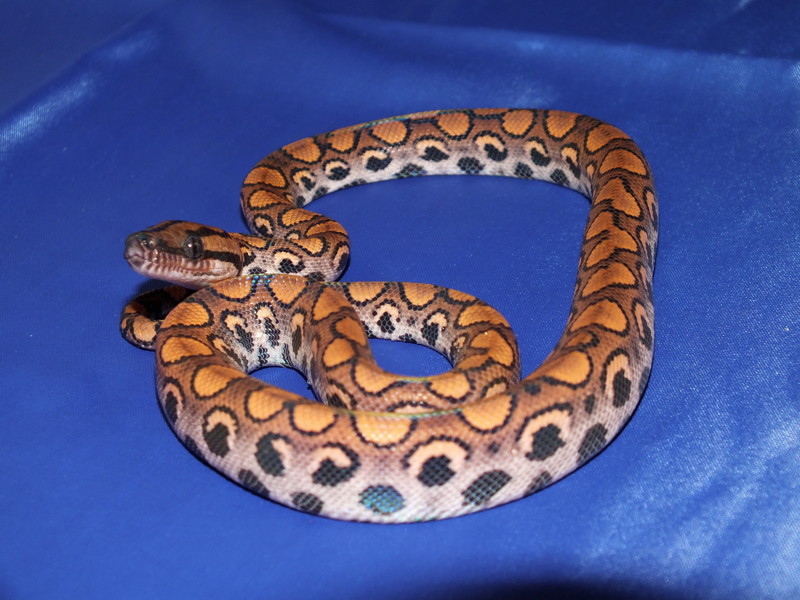   Four-Month Update These shots were taken in late December 2011 to late January 2012, and present an updated view of the baby after the delay. This mini-set includes a front shot and a top shot. 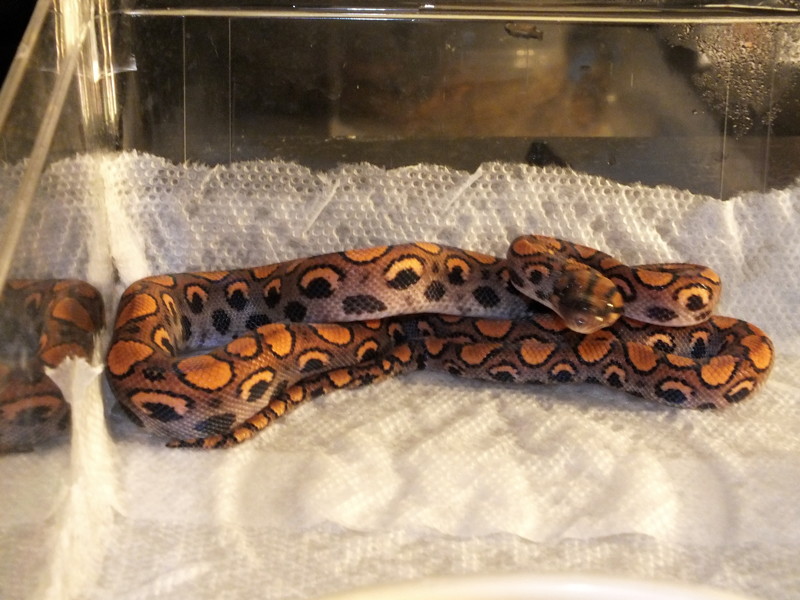 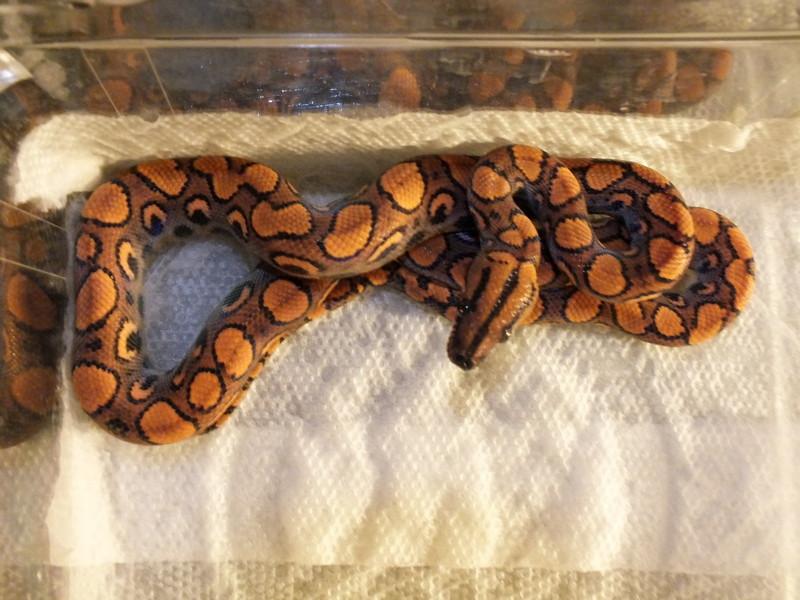 Six-Month Update These shots were taken in March 2012, and present a further updated view of the baby after the delay. This mini-set includes a side shot, a top shot, and a close-up head shot. 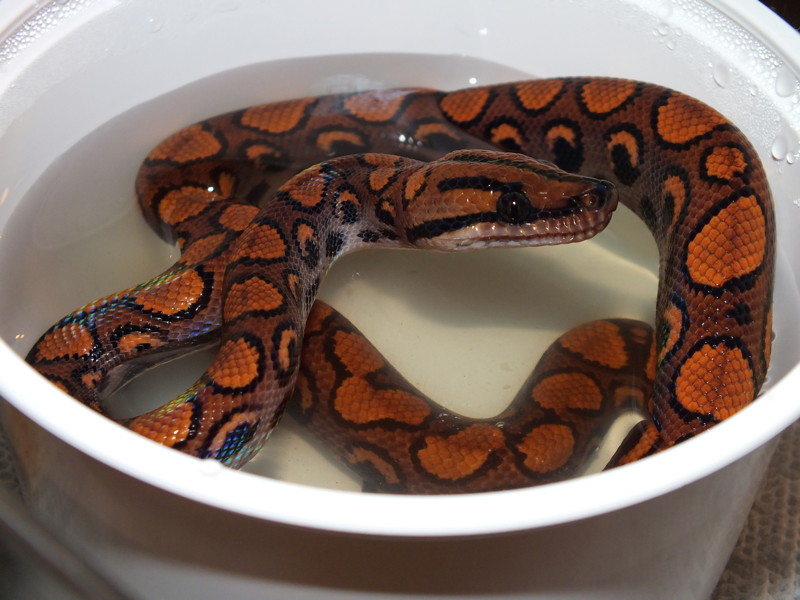 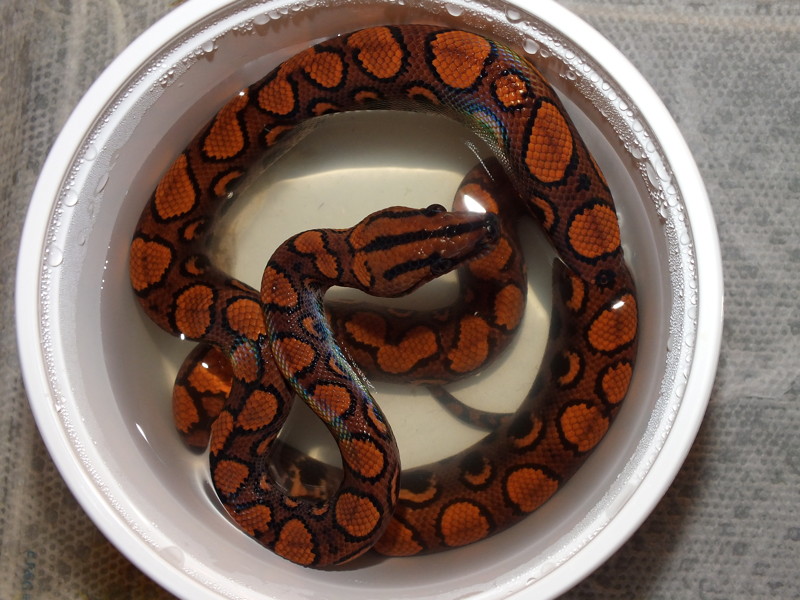 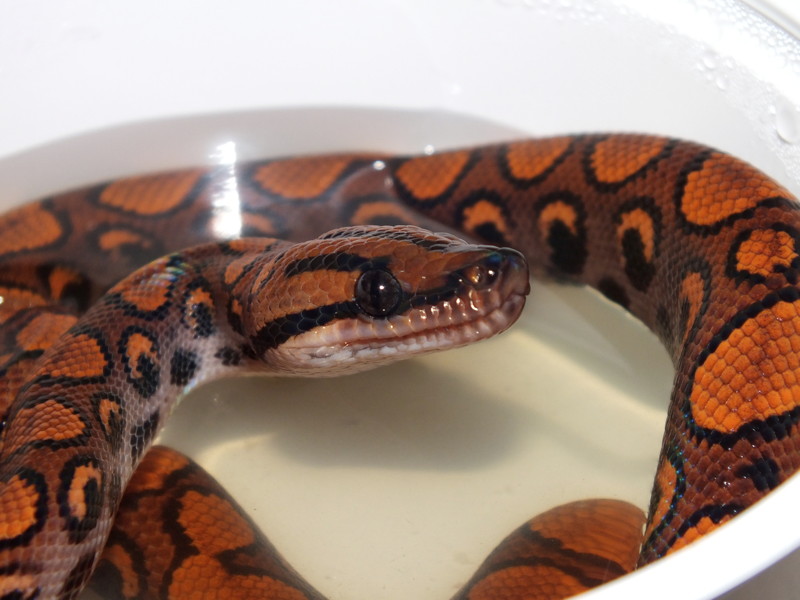 As of March 31, this little one had increased from a birth weight of 31 grams to 78 grams. ------ B-13 (Female) This girl was probably the calmest member of her litter for a long time, not biting me a single time, even on sexing day…right up until the night I typed this sentence. Since then, she has shown more attitude -- she wins the litter’s “most likely to nip when being picked up” award -- but is still a total sweetheart once you do. Physically, she has several unique traits. On her back, she has thick border lines compared to her littermates, and a single linked chain of two (almost three) spots. On her right side, she has one departure from an otherwise solid crescent pattern, an eclipse. On her left side, she has one departure from an otherwise solid crescent pattern, again an eclipse. At Birth These shots were taken in mid-September 2011. The first shot was taken shortly after birth, and captured her exploring the viv with Mom. The second is a (slightly) later shot, after she was placed in her own drawer-home. 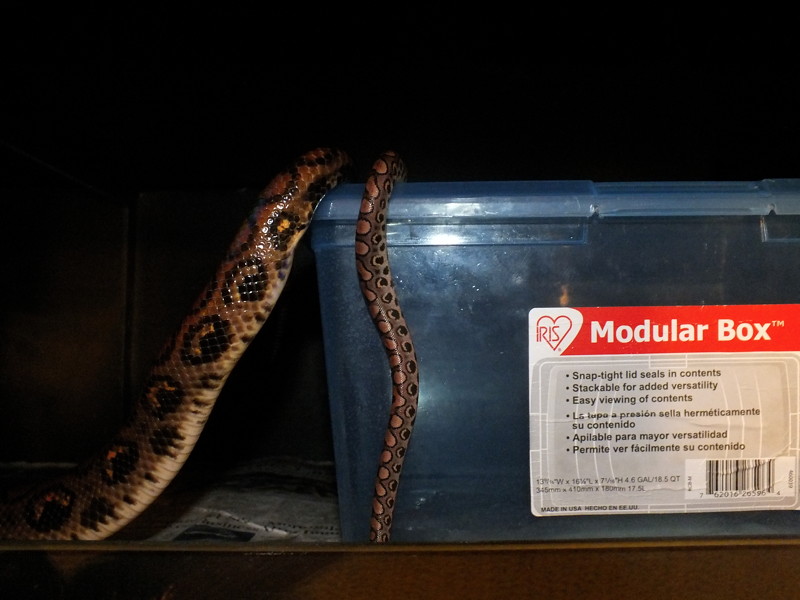 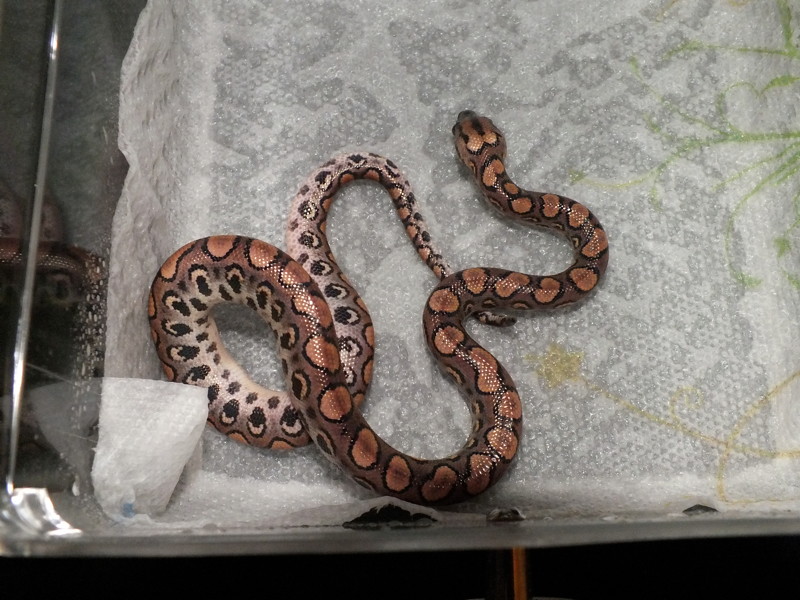 Post Shed This shot was taken in late September 2011. Apologies for the bad lighting; it was taken without formal prep. 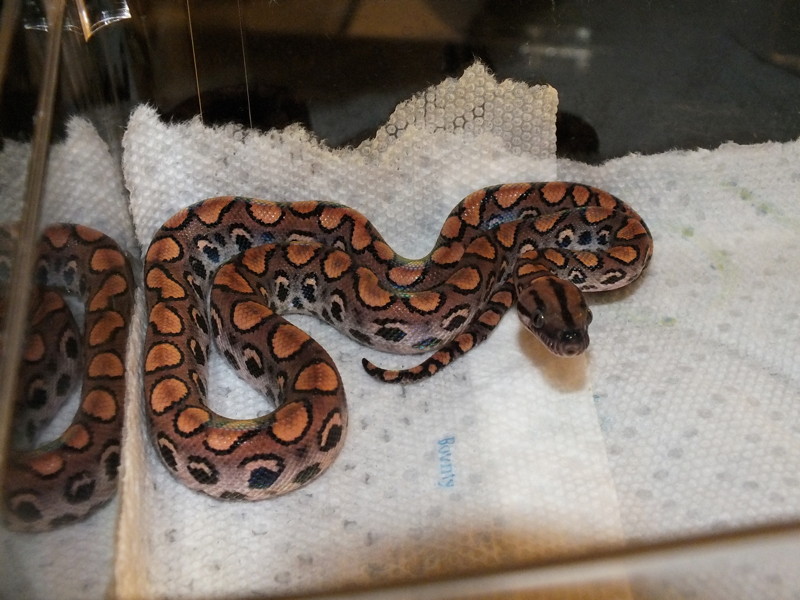 Formal Photo Session This series of shots was taken in early October 2011. Originally, these were to be the sale shots, but circumstances forced a long delay. This mini-set includes a front/side shot, a side/rear shot, a top shot, and a close-up head shot. 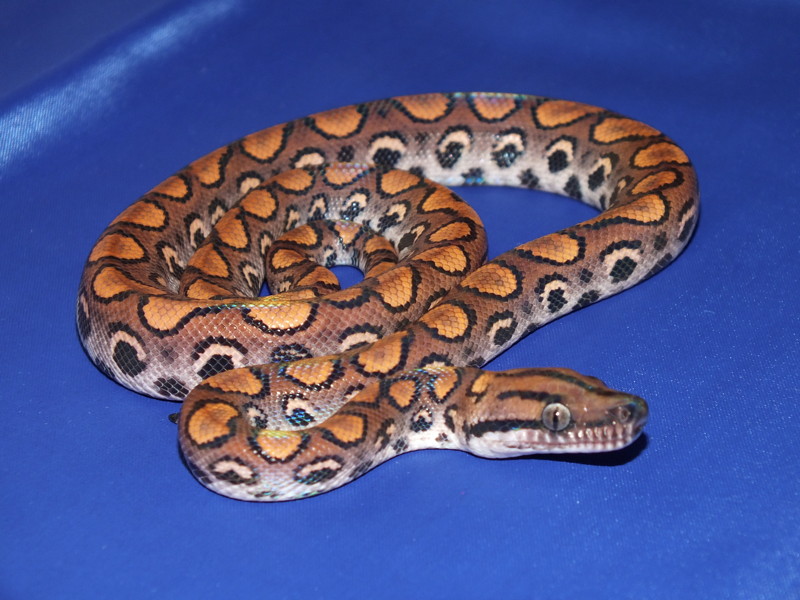 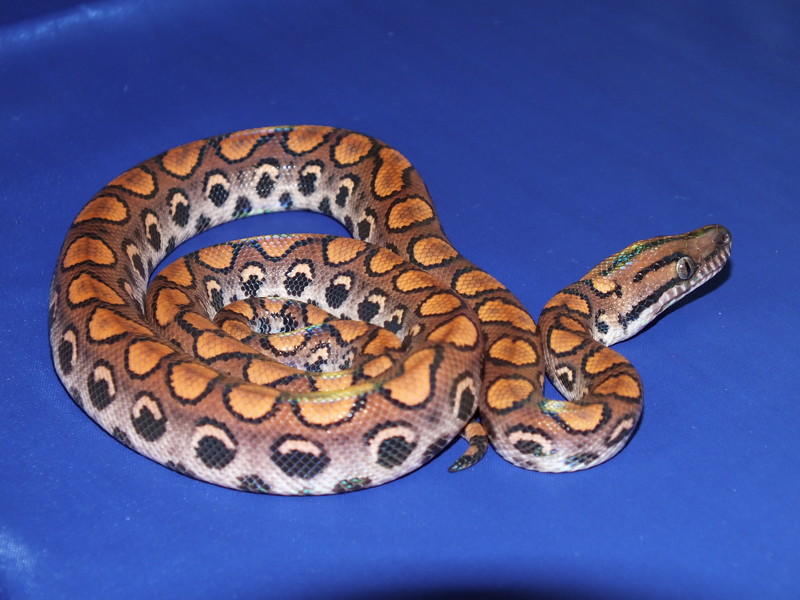 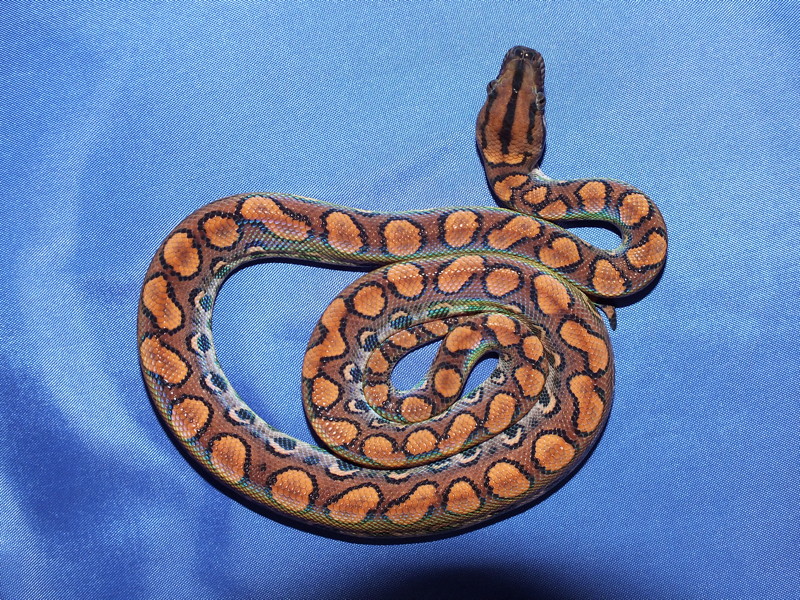 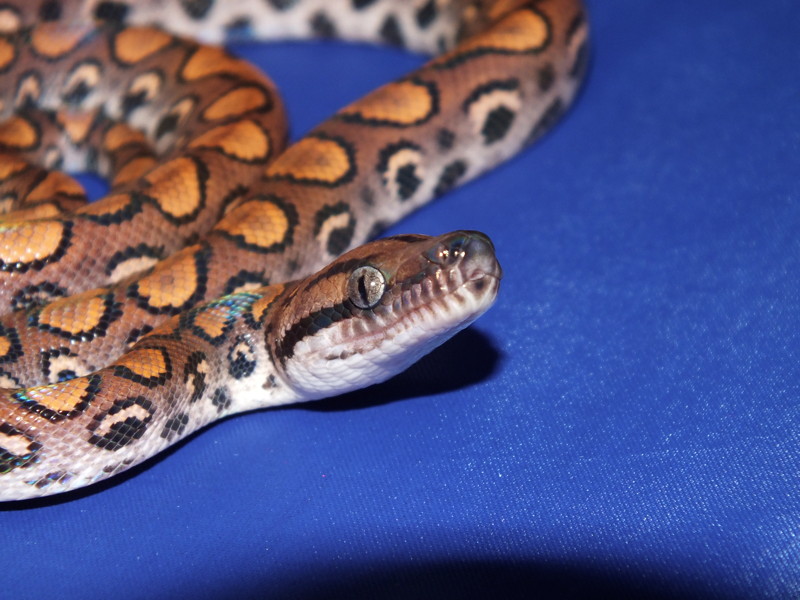 Four-Month Update This shot was taken in late December 2011 to late January 2012, and presents an updated view of the baby after the delay. 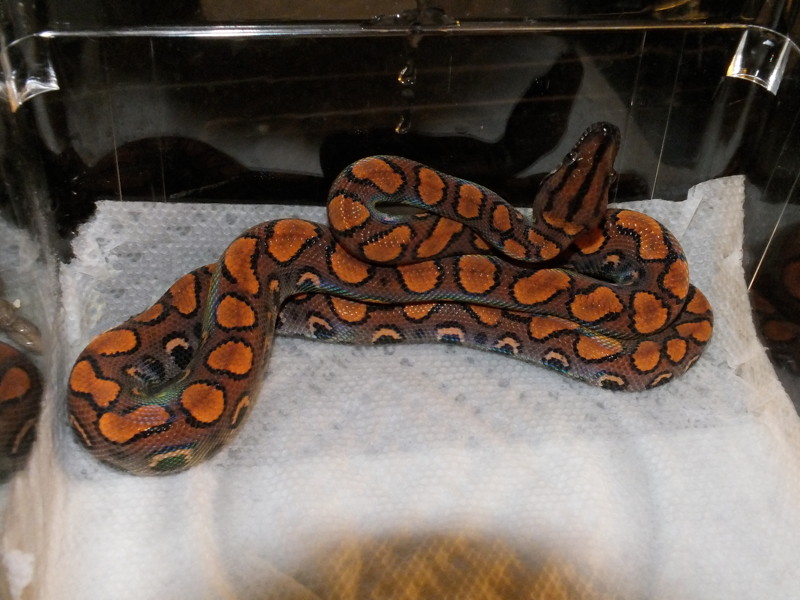 Seven-Month Update These shots were taken in April 2012 (she was the only baby not to shed in March), and present a further updated view of the baby after the delay. This mini-set includes a front/side shot, a top shot, and a close-up head shot. 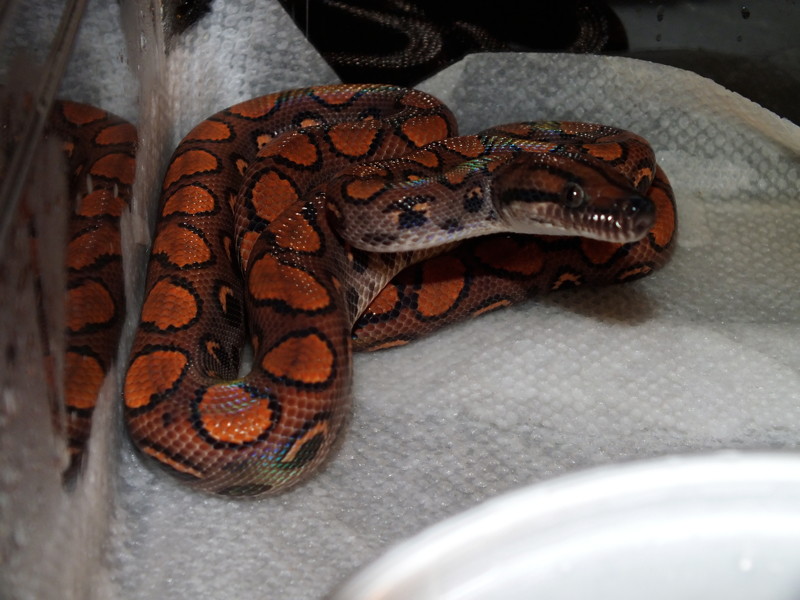 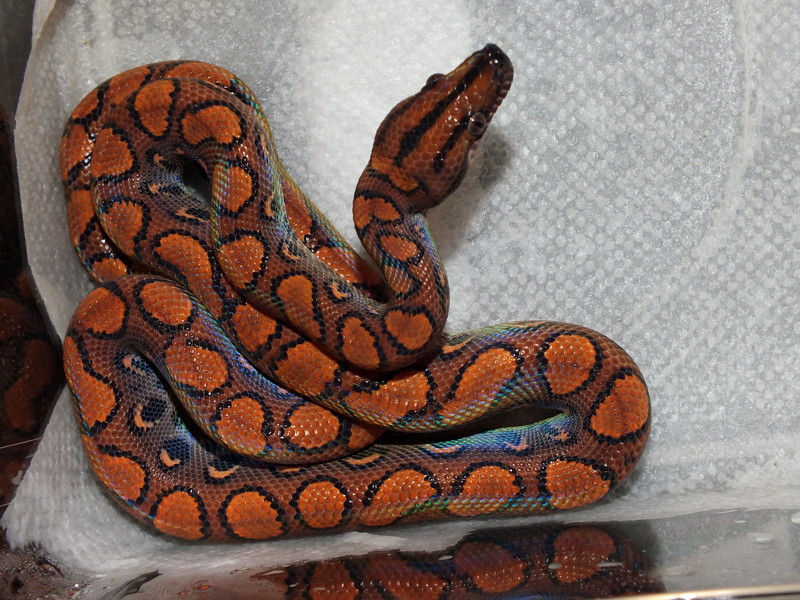 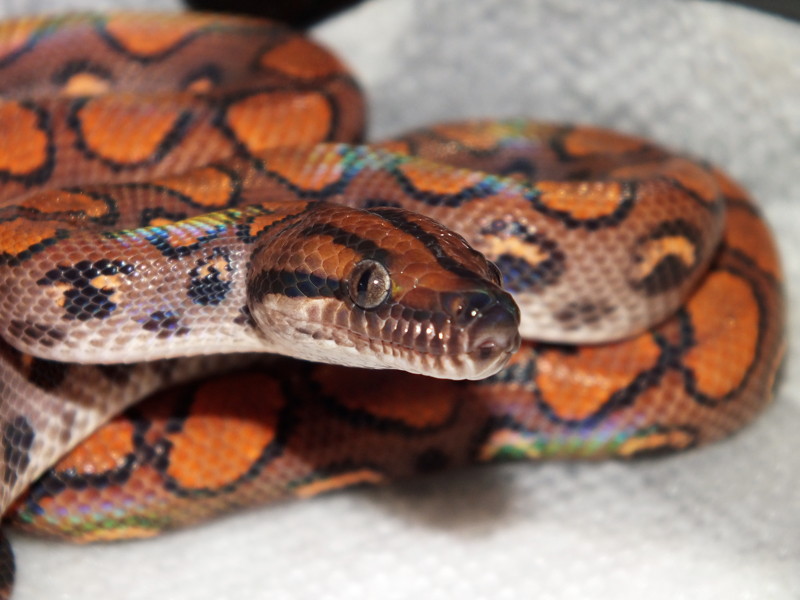 As of March 31, this little one had increased from a birth weight of 33 grams to 90 grams. ------ B-14 (Female) This was one of the last few babies I found. She was coiled off to the side, right on the heat, wedged between the now-empty hide and the wall. She seemed rather surprised when I moved the hide to grab her. (“Wait, you can move that thing?”) Over time, she has shown herself to be a real sweetheart, and is one of the calmest babies in this litter. Physically, she has several unique traits. She has a lighter-colored head, which can be an indicator of good things to come. On her back, she has two linked chains of two spots. On her sides, she has a 100% crescent pattern -- a clean, classic look all the way. Finally, she has a bonus black dot on her right side around mid-body. At Birth These shots were taken in mid-September 2011. The first shot was taken shortly after birth, and was shot just after her Mom's hide was moved away from the wall, thus exposing her chosen hiding place. The second is a (slightly) later shot, after she was placed in her own drawer-home. 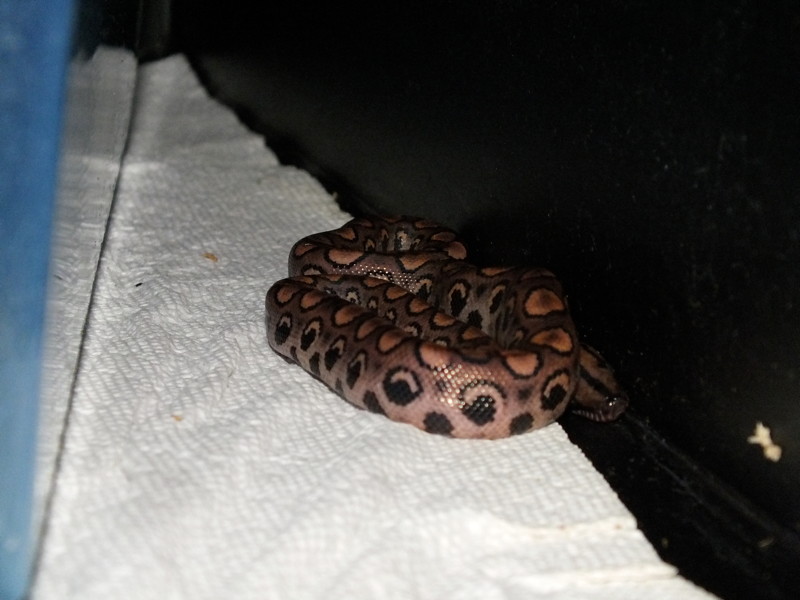 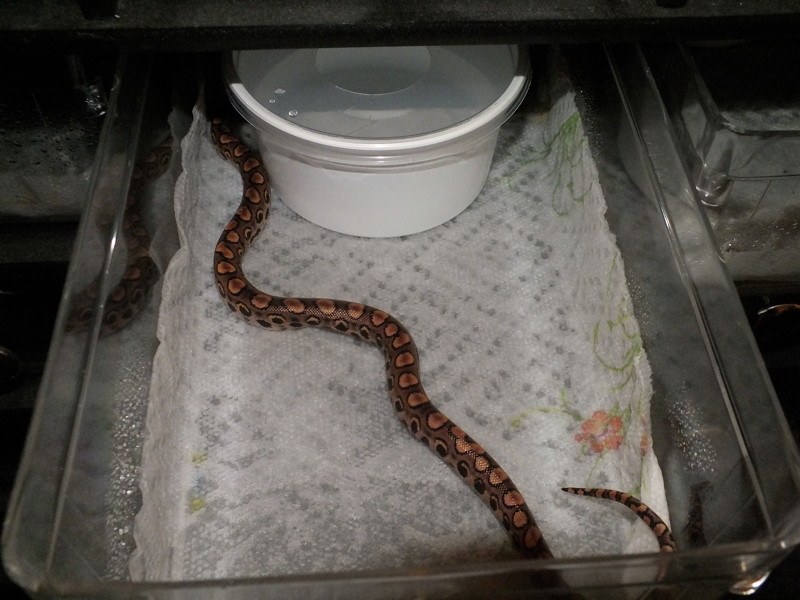 Post Shed This shot was taken in late September 2011. Apologies for the bad lighting; it was taken without formal prep. 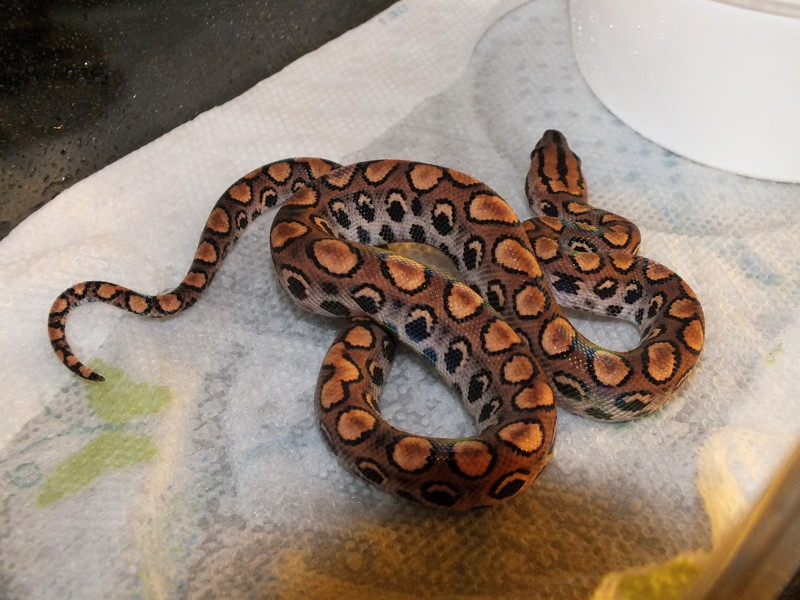 Formal Photo Session This series of shots was taken in early October 2011. Originally, these were to be the sale shots, but circumstances forced a long delay. This mini-set includes a right/rear shot, a left/rear shot, a top shot, and a close-up head shot (after she finally turned around for me). 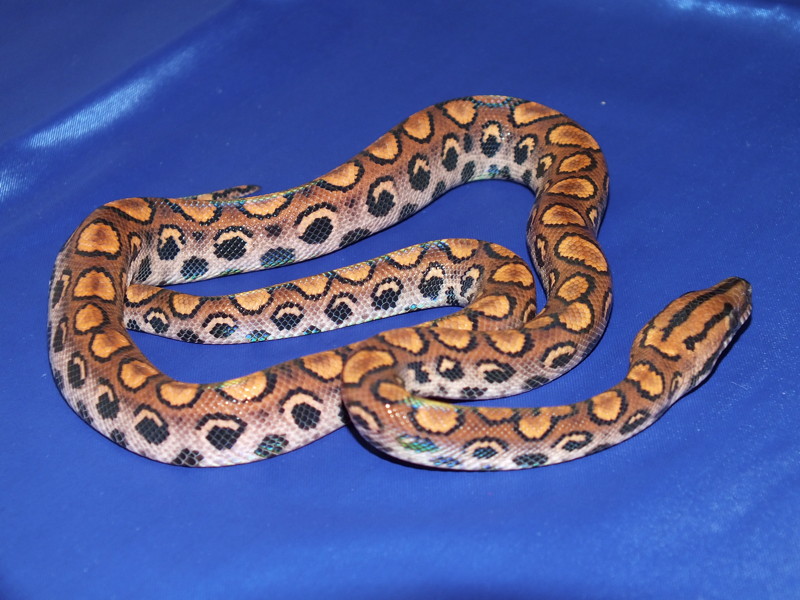  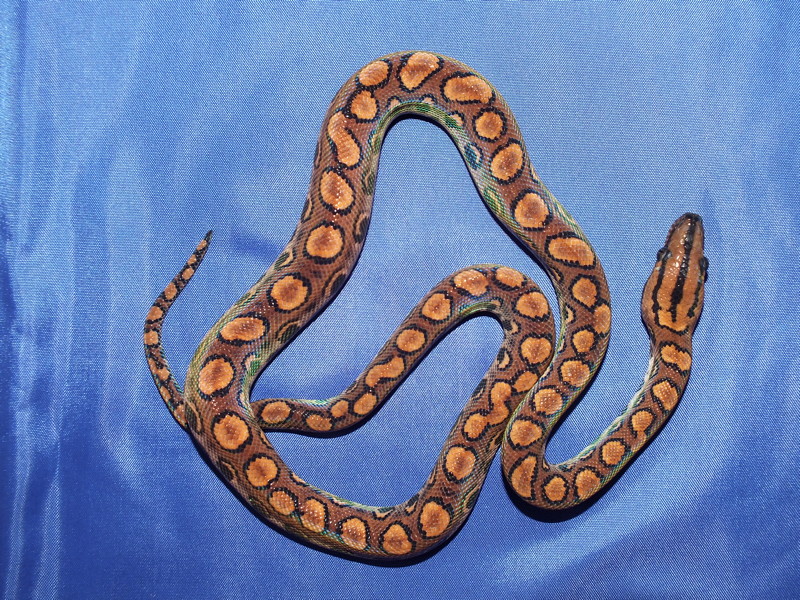 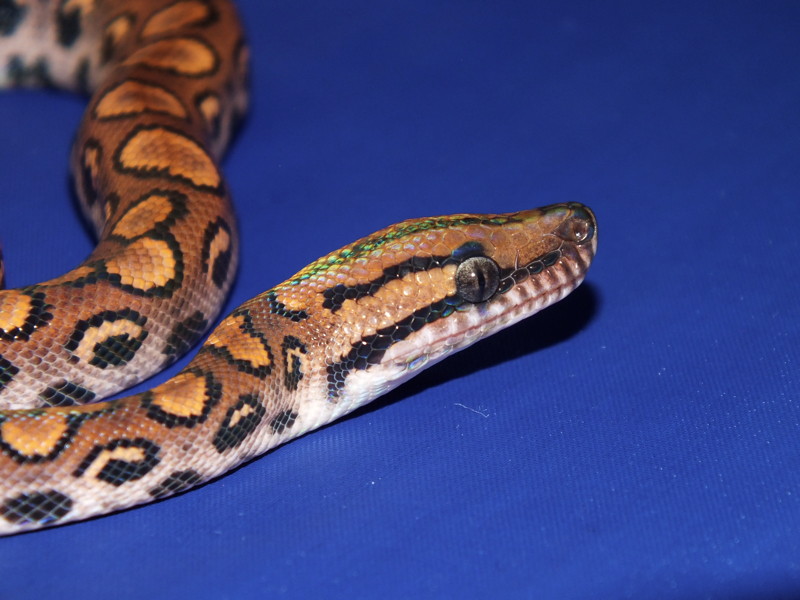 Three-Month Update These shots were taken in late December 2011 to late January 2012, and present an updated view of the baby after the delay. This mini-set includes a front shot and a top shot. 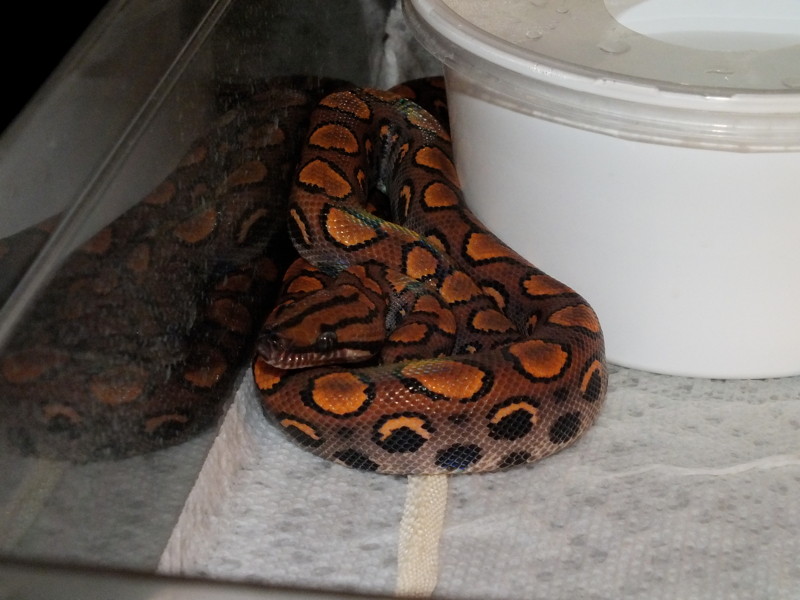  Six-Month Update These shots were taken in March 2012, and present a further updated view of the baby after the delay. This mini-set includes a raised/side shot, a top shot, and a close-up head shot. 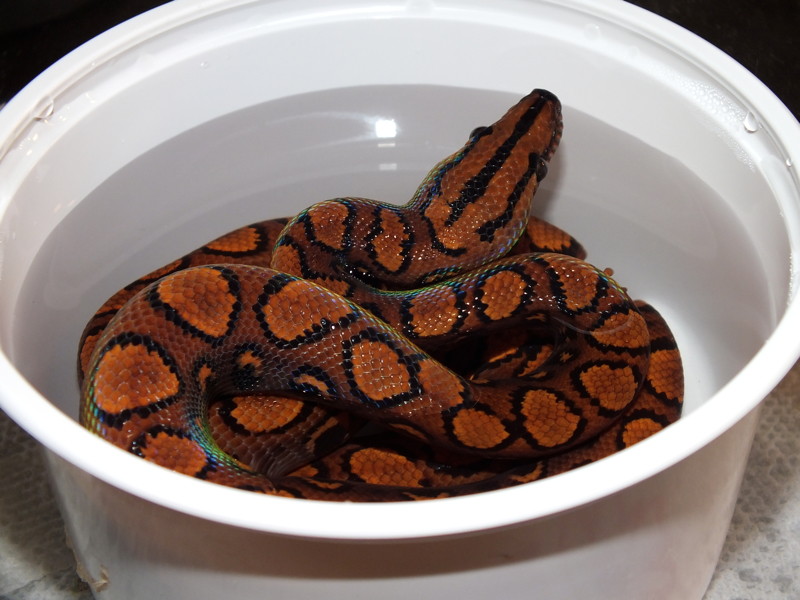 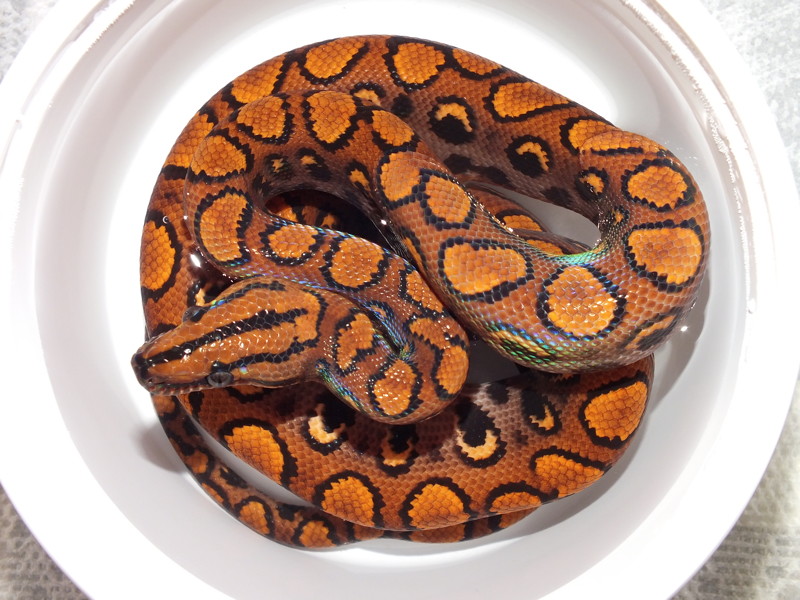 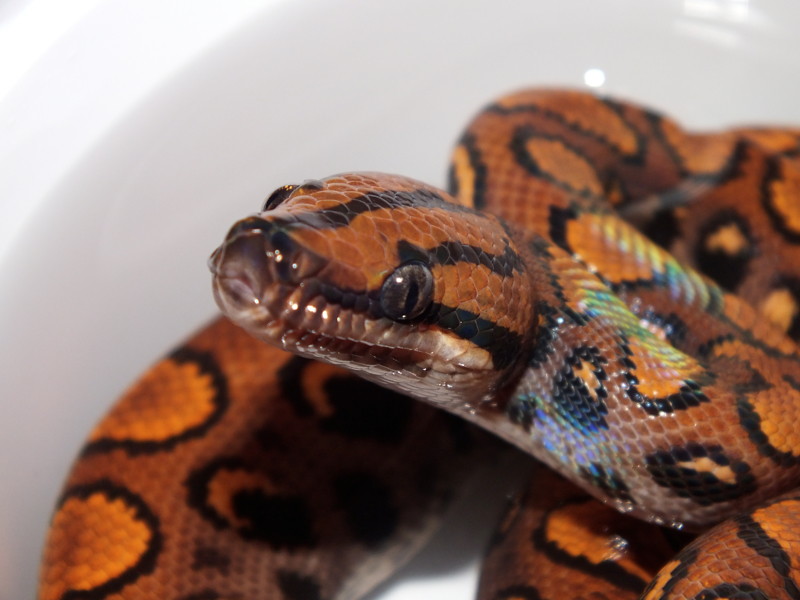 As of March 31, this little one had increased from a birth weight of 34 grams to 86 grams. ------ B-15 (Male) This little dude is the spunkiest member of his litter, and apparently the athlete of the group, too. I found him near the end of initial sorting, swimming merrily away in the almost-empty water bowl long after everyone else had moved on. He rewarded his rescuer by promptly sinking his baby teeth into the nearest finger. He is also the only member who ever successfully “escaped,” by deciding to make a mad dash for freedom -- he boiled up and out of drawer and to the floor three feet below before I could react. (It was the world’s shortest jailbreak.) These days, he is much calmer but still roguish: he tried another dash for freedom the night of the pattern inspection, but got caught en route; during the December weigh-in, he tried a nip, and used his tail to grab the counter-top in another attempt at escape; during several recent cleaning sessions, his baby vision locked in on my quick-moving cleaning fingers, and attempted baby wrath followed. His attitude is very much “why be held when you can explore?” Physically, he has several unique traits. He has a light-colored head, which can be an indicator of good things to come. On his back, he has four linked chains of two spots. On his left side, he has a 100% crescent pattern. On his right side, he has one departure from an otherwise solid crescent pattern, an eclipse. At Birth These shots were taken in mid-September 2011. The first shot was taken shortly after birth, and caught him swimming away in Mom’s water bowl. The second is a (slightly) later shot, after he was placed in his own drawer-home. 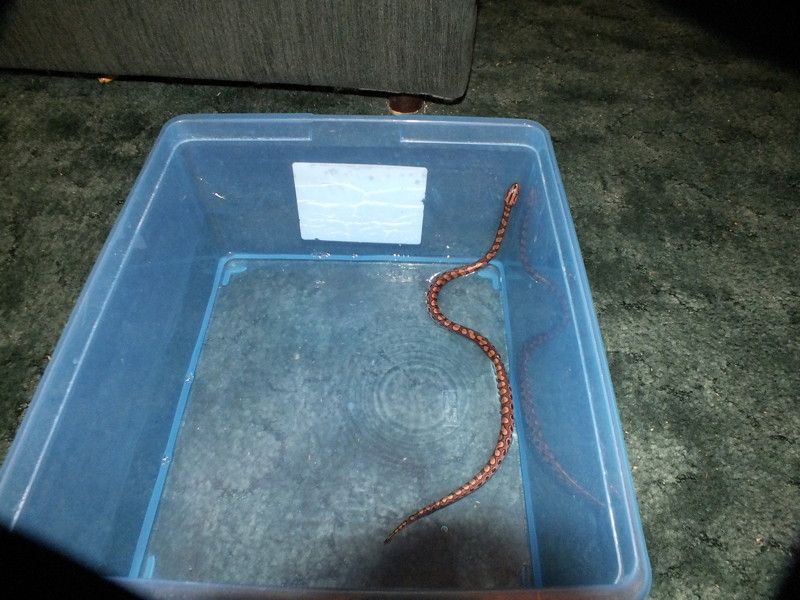 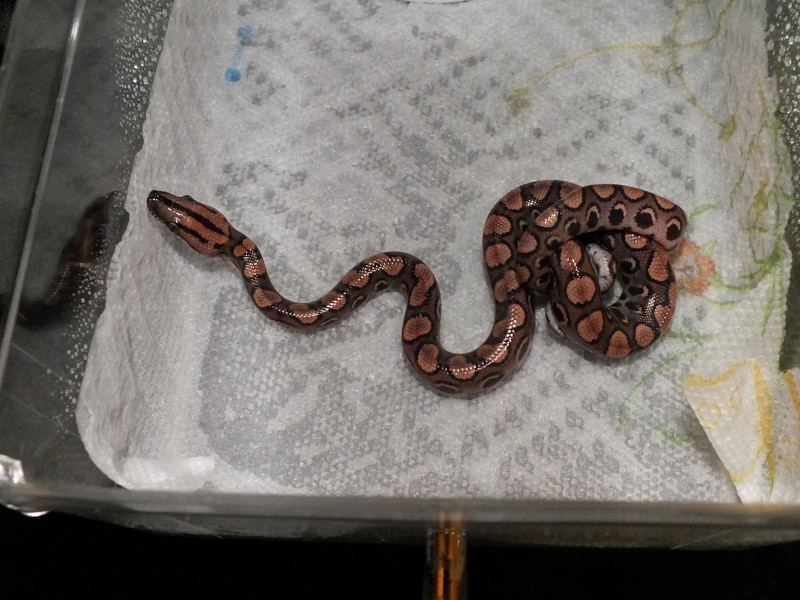 Post Shed This shot was taken in late September 2011. Apologies for the bad lighting; it was taken without formal prep. 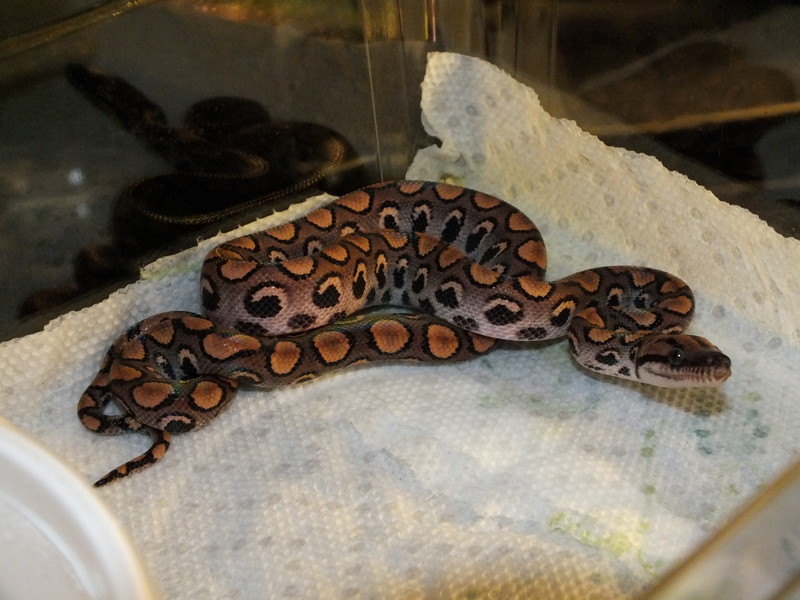 Formal Photo Session This series of shots was taken in early October 2011. Originally, these were to be the sale shots, but circumstances forced a long delay. This mini-set includes a front shot, a side shot, a top shot, and a close-up head shot.  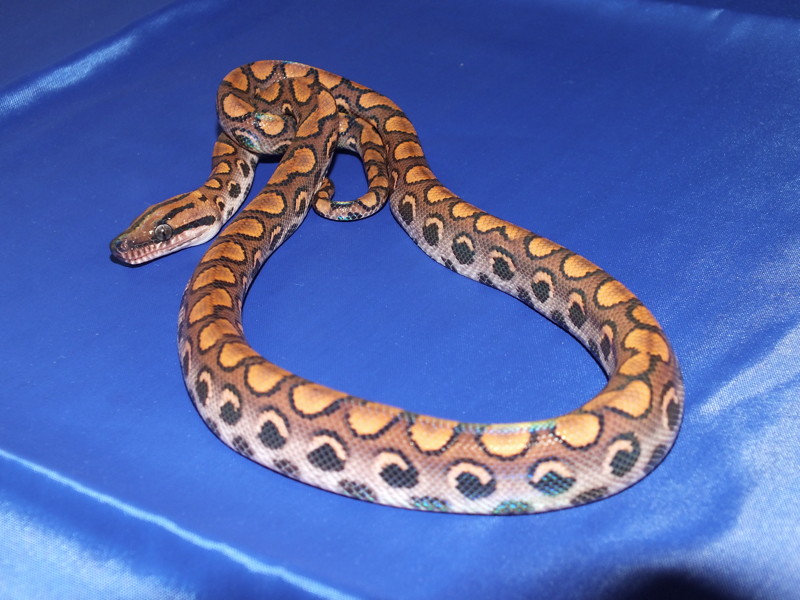 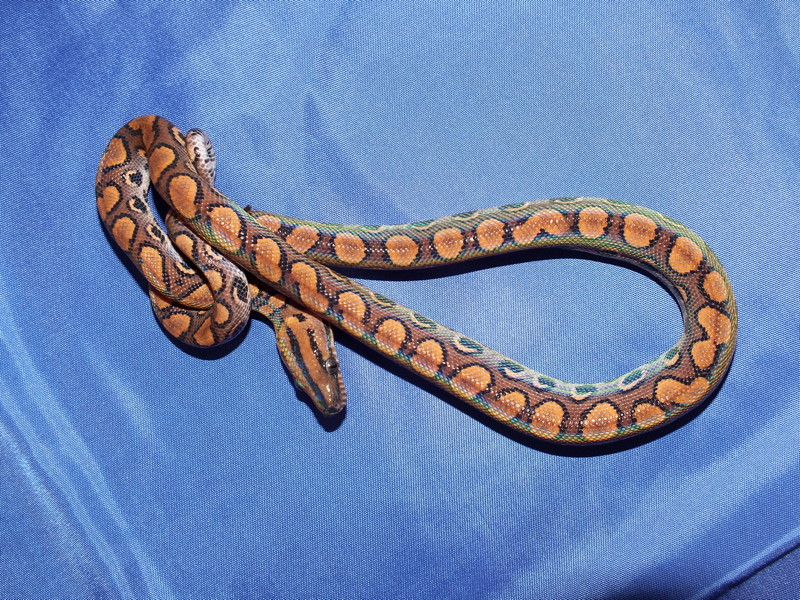 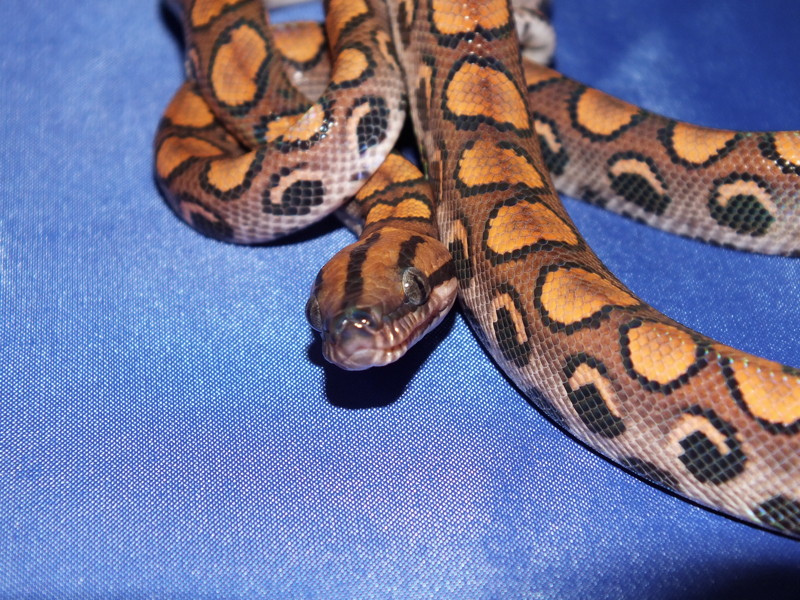 Three-Month Update These shots were taken in late December 2011 to late January 2012, and present an updated view of the baby after the delay. This mini-set includes a front shot and a top shot.  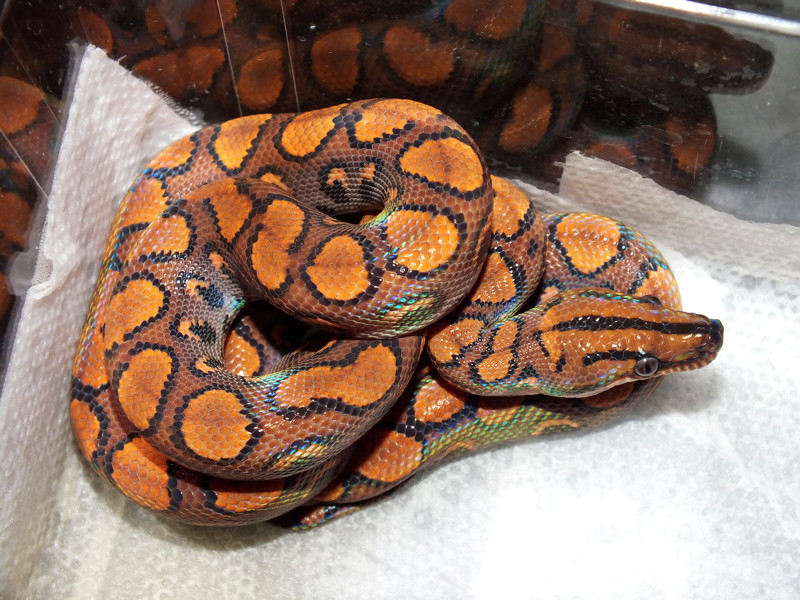 Six-Month Update These shots were taken in March 2012, and present a further updated view of the baby after the delay. This mini-set includes a front shot and a top shot.  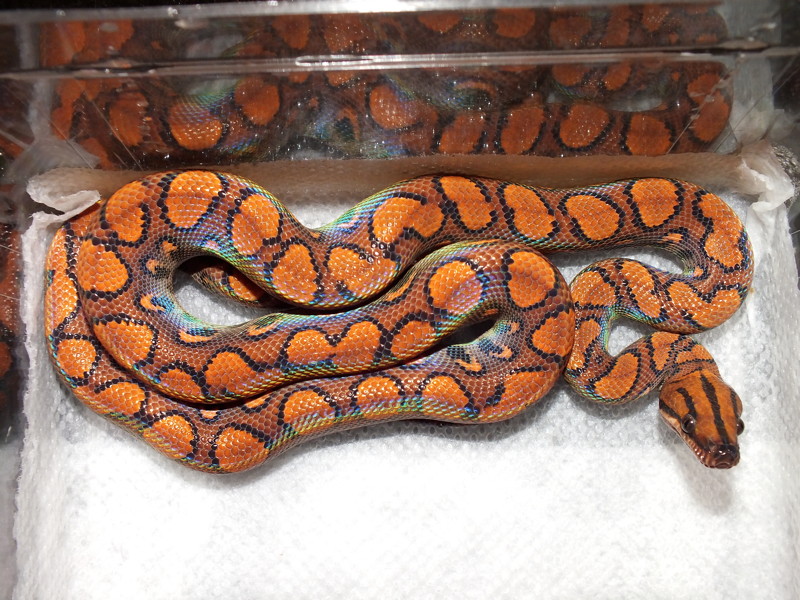 As of March 31, this little one had increased from a birth weight of 33 grams to 96 grams. ------ B-16 (Male) This guy was one of two final babies I found after everyone else was long put away, carefully hiding under the newspaper. He is a very active snake, and would not sit still during the pattern inspection. Physically, this little one has several unique traits. On his back, he has three linked chains: one three spots, one two or three spots (depending how you count), and one two spots. On his left side, he has a 100% crescent pattern. On his right side, he has three departures from an otherwise solid crescent pattern, one merged dot and two tiny bonus pearls (the only ones in the litter). His crescents, I should add, are some of the boldest in the litter. At Birth This shot was taken in mid-September 2011. 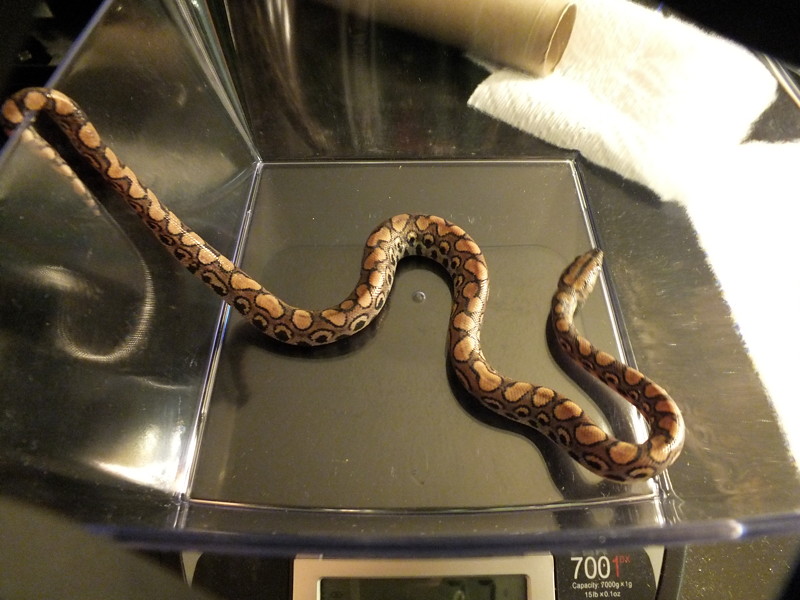 Post Shed This shot was taken in late September 2011. Apologies for the bad lighting; it was taken without formal prep. 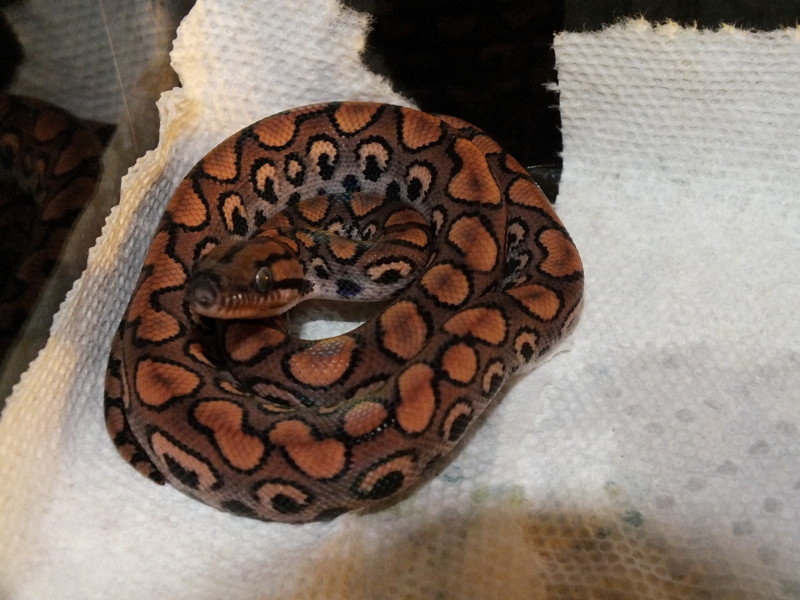 Formal Photo Session This series of shots was taken in early October 2011. Originally, these were to be the sale shots, but circumstances forced a long delay. This mini-set includes a front shot, a side shot, a top shot, and a close-up head shot. 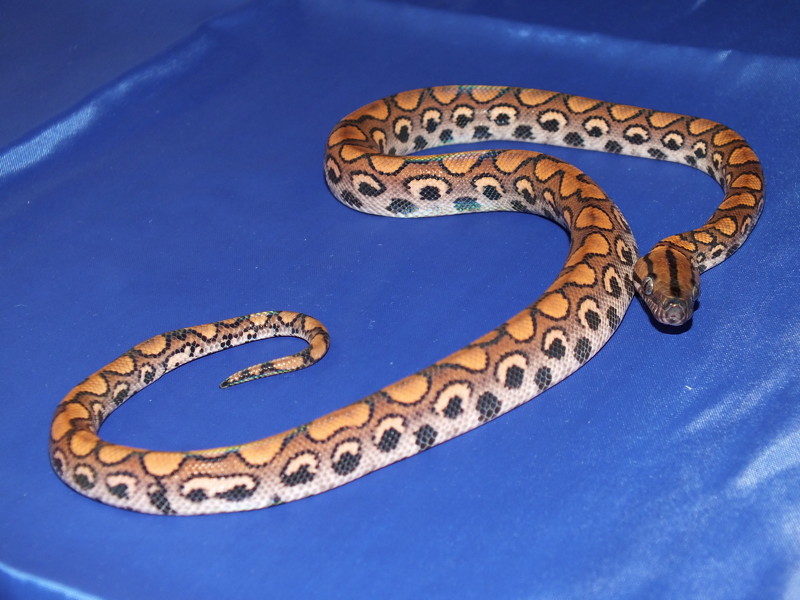 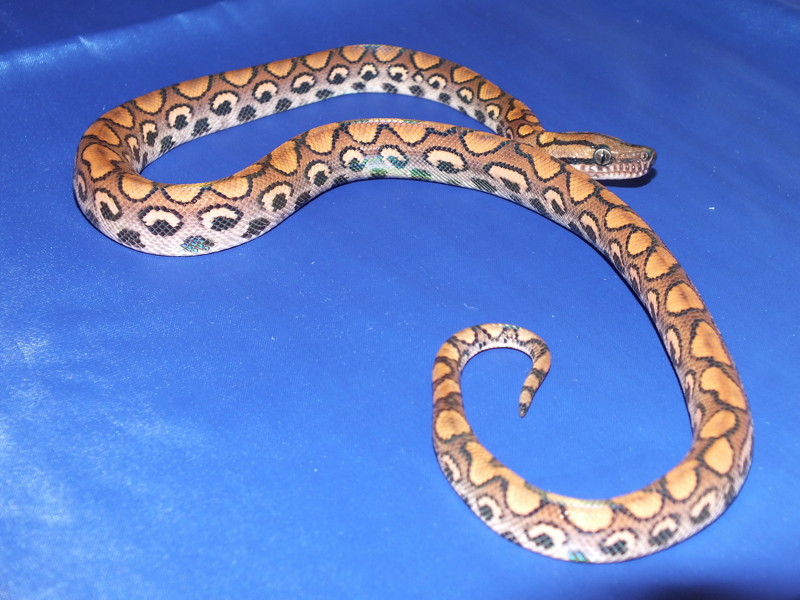 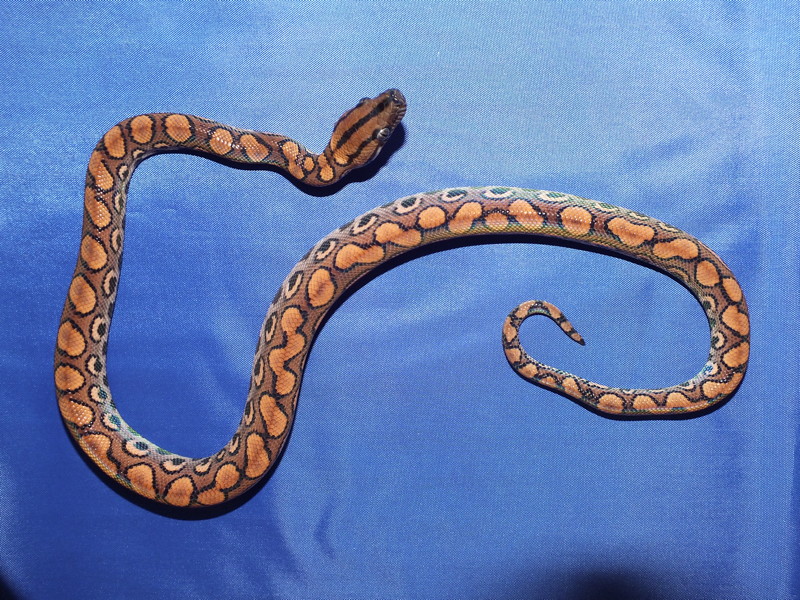 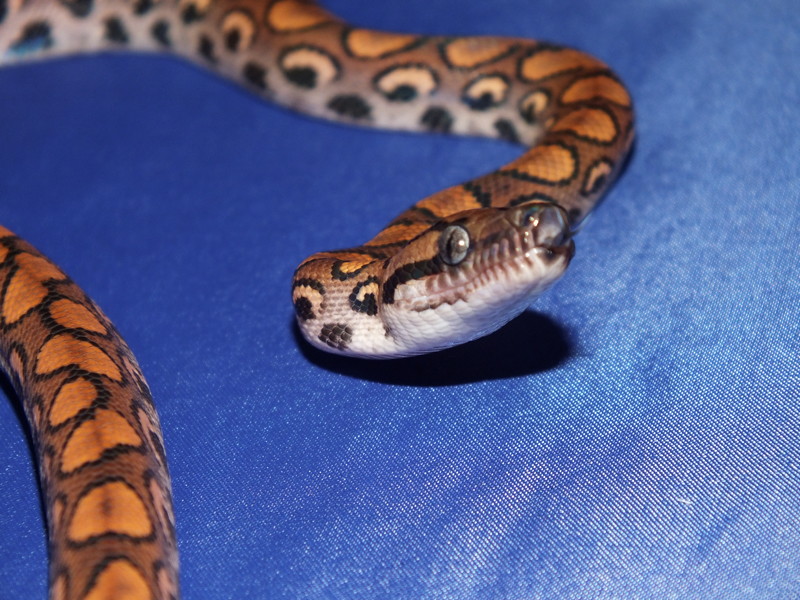 Three-Month Update These shots were taken in late December 2011 to late January 2012, and present an updated view of the baby after the delay. This mini-set includes a front shot and a top shot. 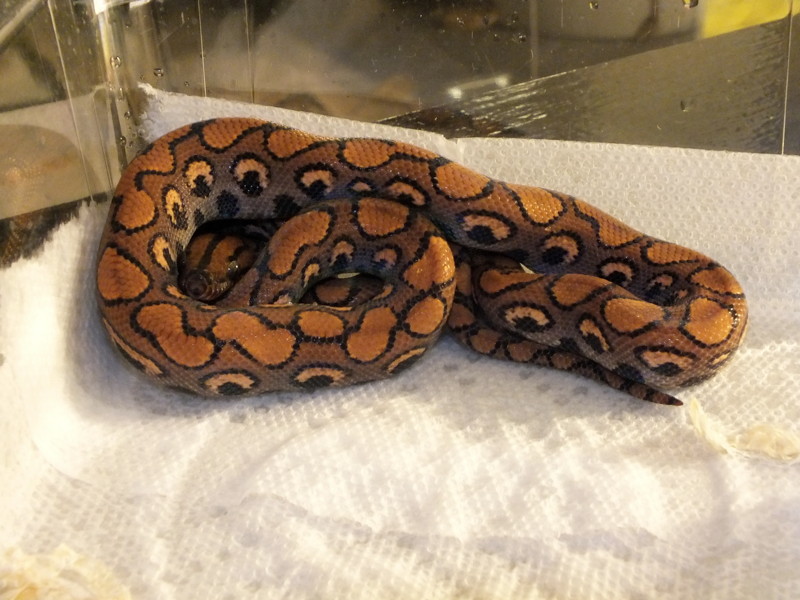  Six-Month Update These shots were taken in March 2012, and present a further updated view of the baby after the delay. This mini-set includes a side shot and a top shot. 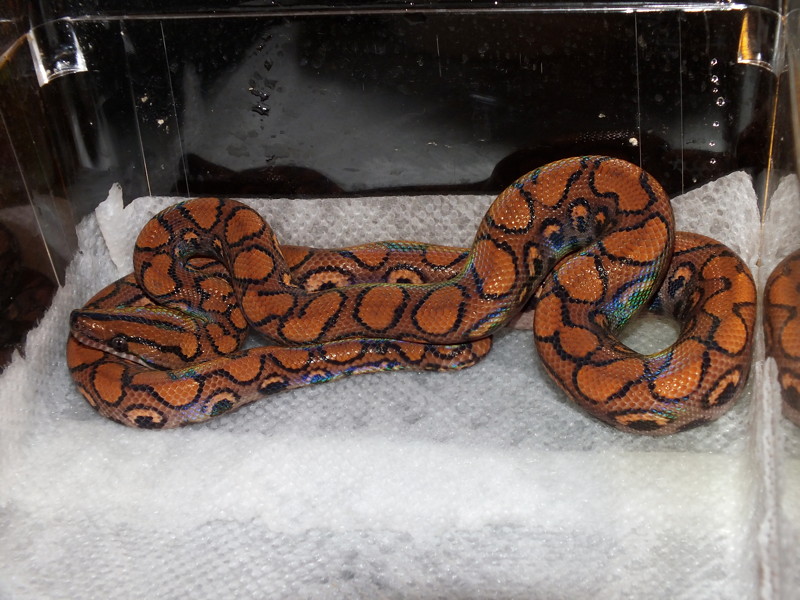 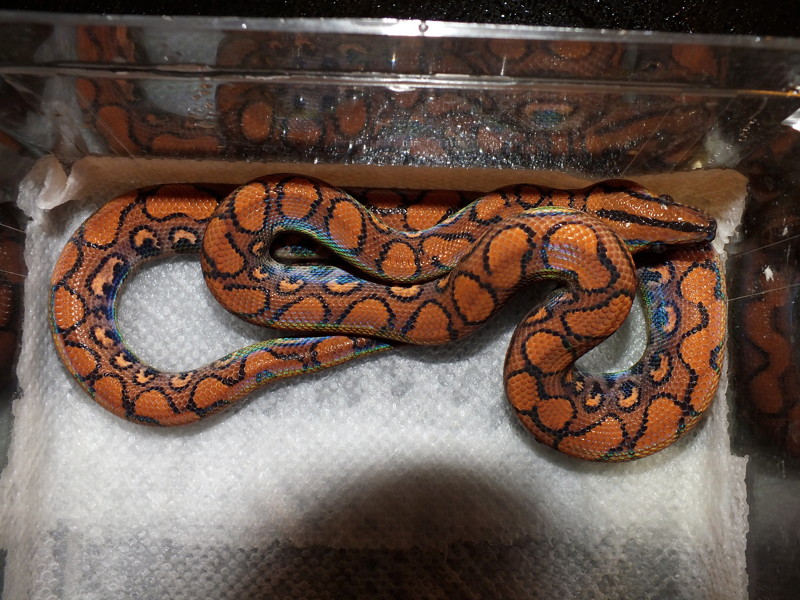 As of March 31, this little one had increased from a birth weight of 32 grams to 89 grams. ------ B-17 (Male) This guy was one of two final babies I found after everyone else was long put away, carefully hiding under the newspaper. Even then, he was fairly mellow, and that has not changed as he aged. Interestingly, he is the only baby in the litter that likes to hang out at the very front of his drawer, something he does almost all the time (and it is not due to temps -- I’ve checked!). Physically, this little one has several unique traits. On his back, he has two linked chains of two spots. On his right side, he has three departures from an otherwise solid crescent pattern, all eclipses (one is an “almost”). On his left side, he also has three departures from an otherwise solid crescent pattern, two eclipses and one merged dot. At Birth These shots were taken in mid-September 2011. The first shot was taken shortly after birth, just after I discovered him as the last holdout hidden away under the newspaper in Mom's viv. The second is a (slightly) later shot, after he was placed in his own drawer-home. 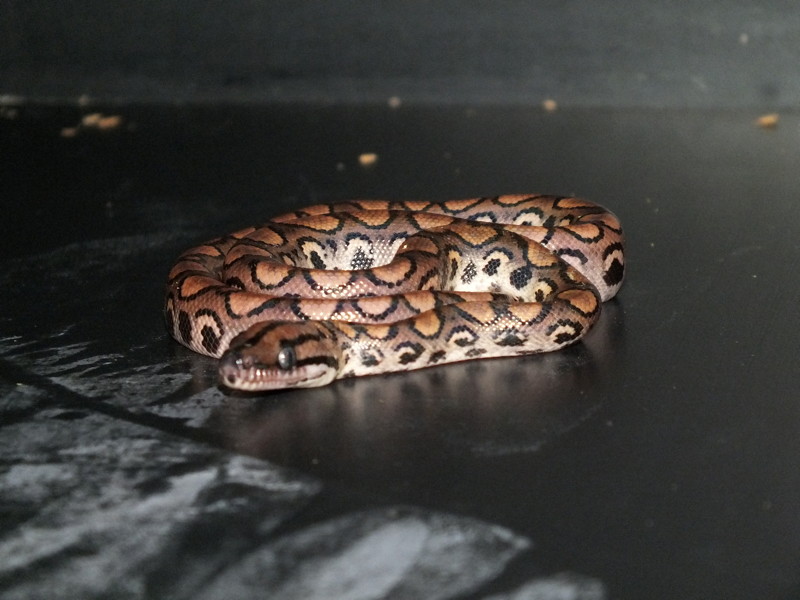 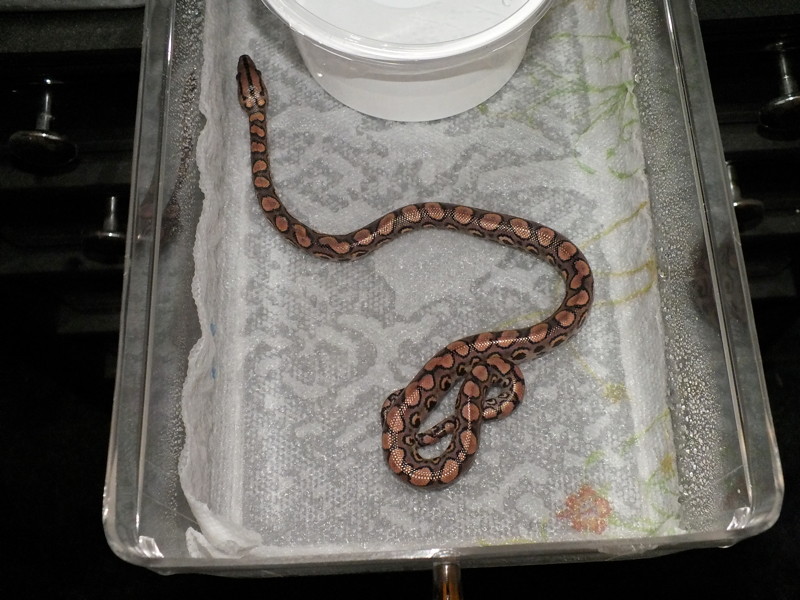 Post Shed This shot was taken in late September 2011. Apologies for the bad lighting; it was taken without formal prep. 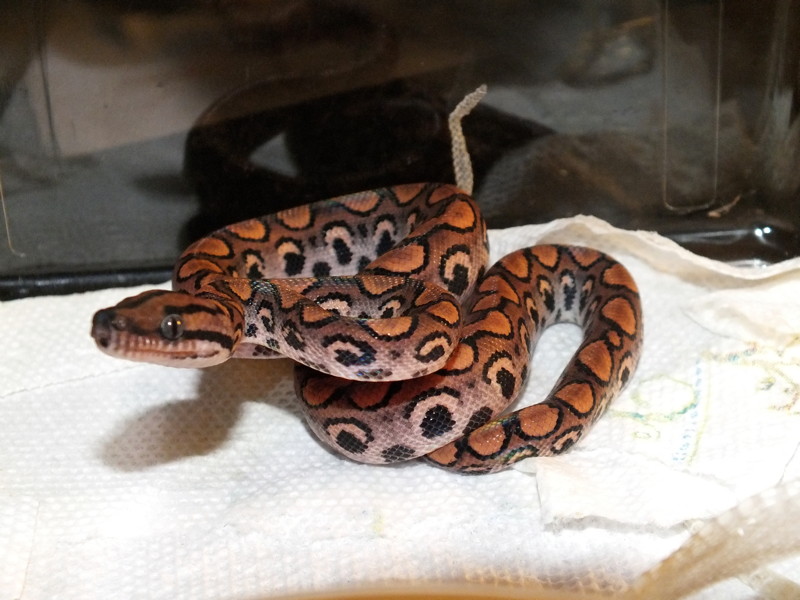 Formal Photo Session This series of shots was taken in early October 2011. Originally, these were to be the sale shots, but circumstances forced a long delay. This mini-set includes a front/side shot, a rear/side shot, a top shot, and a close-up head shot. His neck is craned up in most of them because I had just removed the photo bowl, and he froze to “hide” from me. 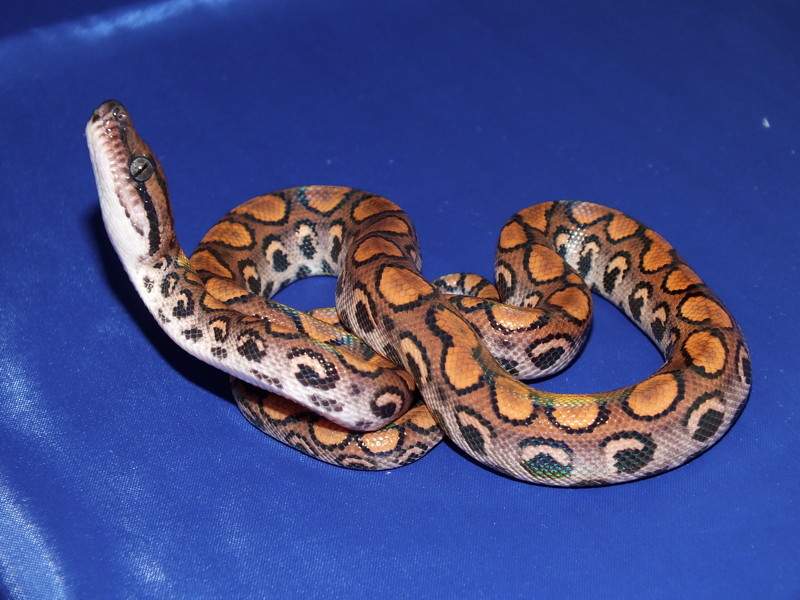  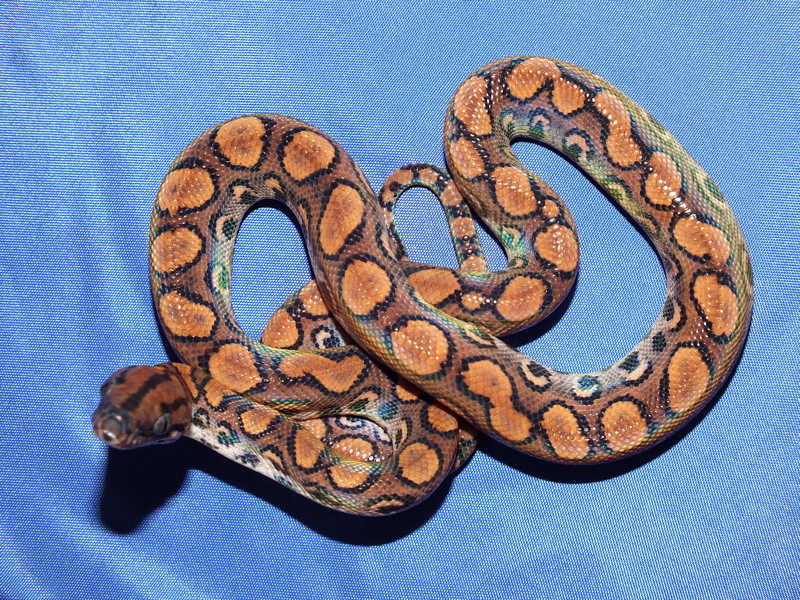  Three-Month Update These shots were taken in late December 2011 to late January 2012, and present an updated view of the baby after the delay. This mini-set includes a front/side shot and a top shot. 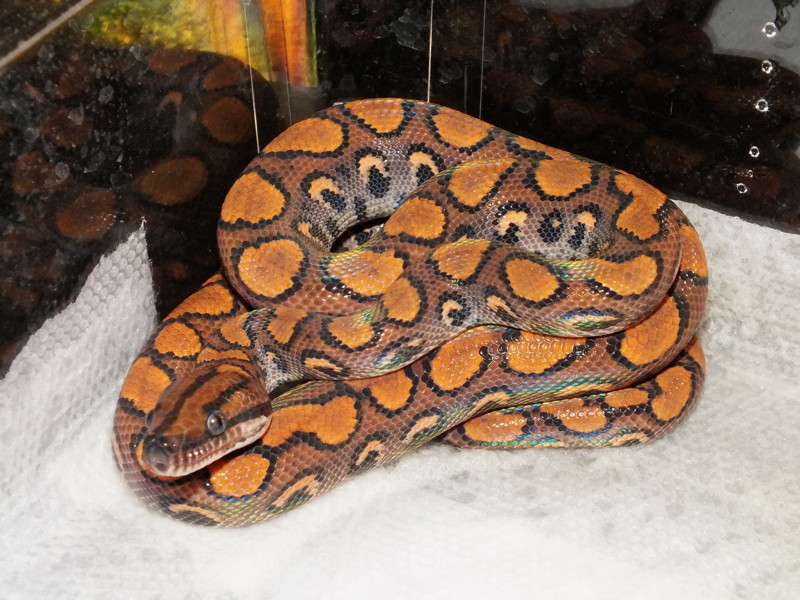 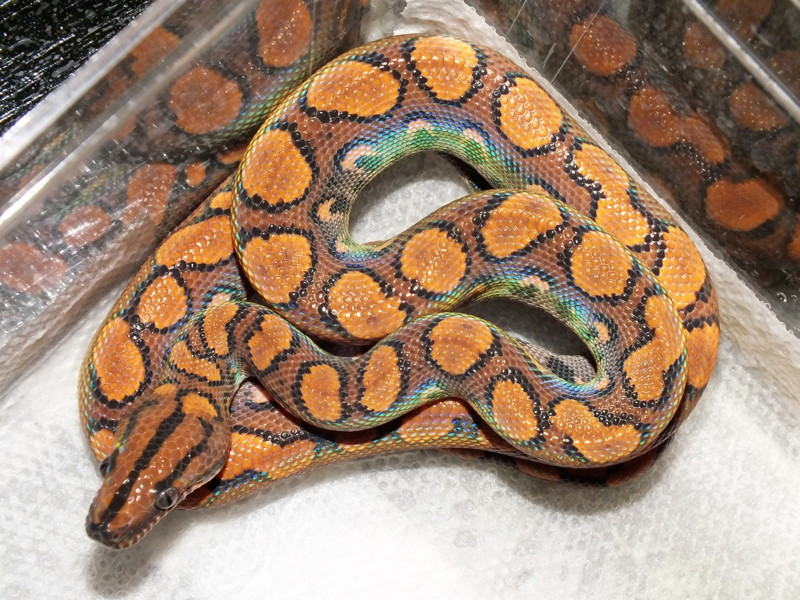 Six-Month Update These shots were taken in March 2012, and present a further updated view of the baby after the delay. This mini-set includes a raised/front shot, a top shot, and a close-up head shot. 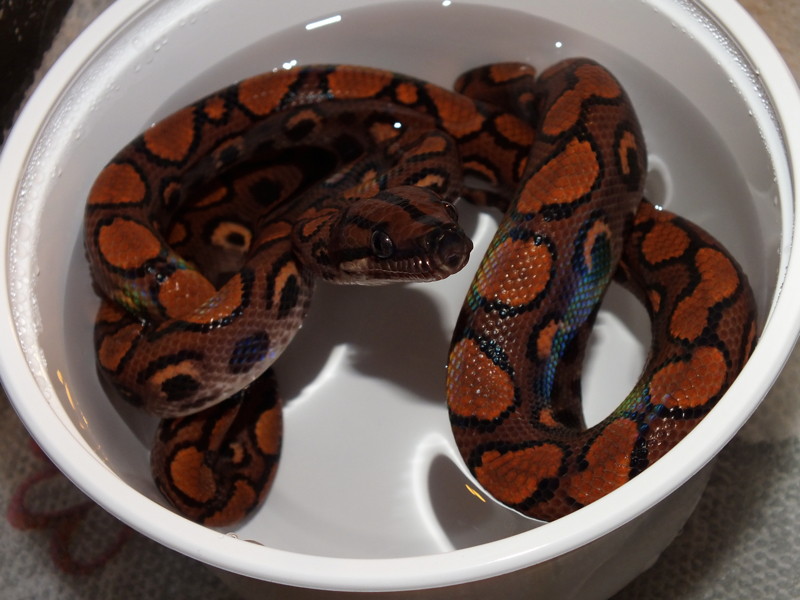 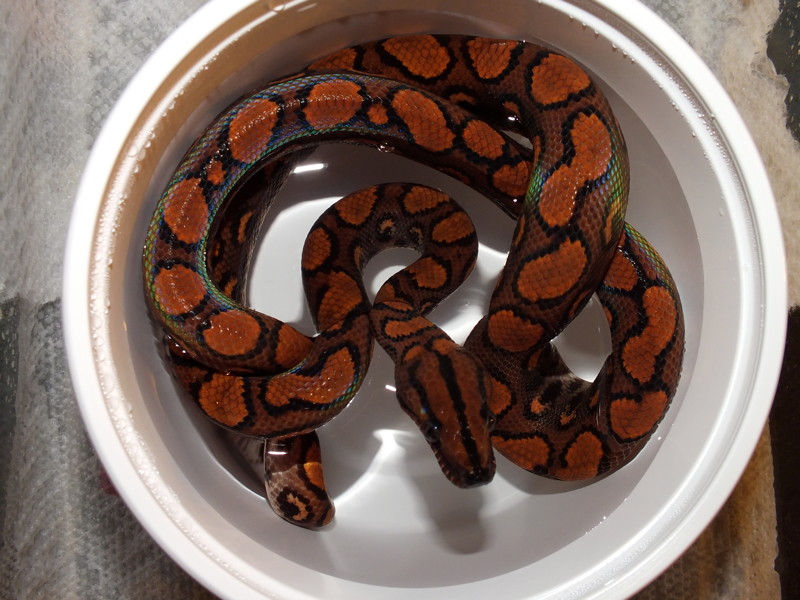 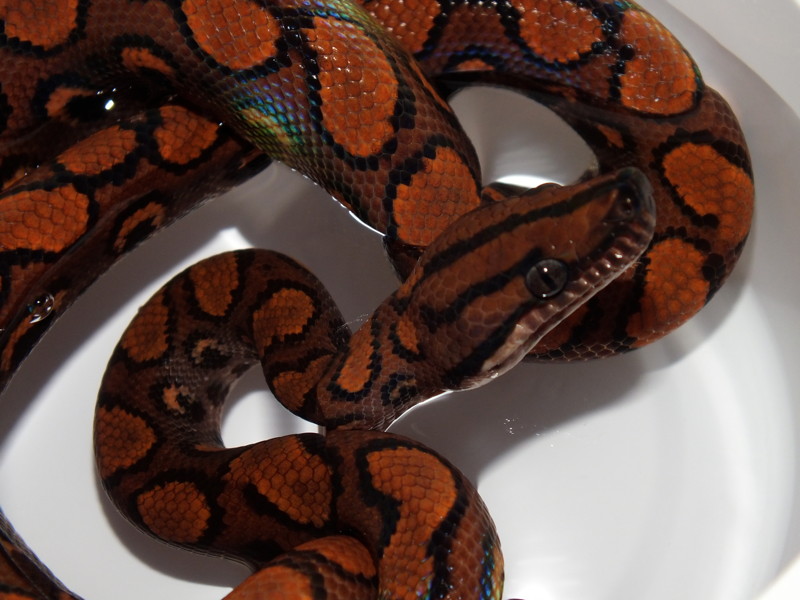 As of March 31, this little one had increased from a birth weight of 31 grams to 90 grams. ------ Partly because last year was a tough one, and partly because this litter turned out so well, I will be holding back four babies in total. Two are more or less decided, and the second two are proving to be tough calls. Suggestions are welcome. Please note that as Hills passed way earlier this year, these 17 little ones will be the sole genetic legacy to his gorgeous color and unusual black back patterning. Rest in peace, buddy -- you done good, and through these little ones your legacy will live on. Thank you, as always, for reading. Thursday, April 19 2012Ashok Captain, Herp Photography, & his Love for India
Ashok Captain is a world renowned herp photographer and Indian snake enthusiast. Read on to learn about some of favorite spots, hear some photography advice, and get a peek into his favorite herping trips.
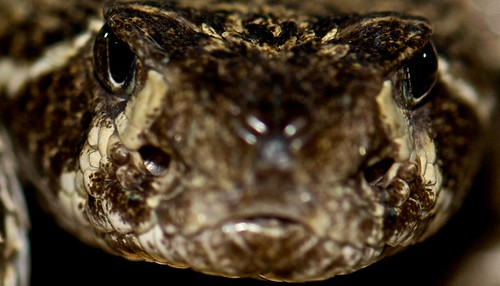 How did you first become interested in reptiles/amphibians (particularly snakes) and photography? A. Captain: In the 90's, we used to go on a lot of jungle trips - initially in the Western Ghats - places close to Pune (where I live). Most trips were during the monsoons (our rainy season) and we'd see a lotta creepies. Initially I tried to 'study' everything - monsoon plants, spiders, solifuges, amblypygids, scorpions, frogs, caecilians, lizards and snakes. I photographed all of these and needed captions for my slides (now digital images)! I soon gave up trying to 'id' everything and drifted towards snakes 'cos it was possible to do a lot (but not all) of the identification without killing 'em/ collecting 'em/ dissecting bits and pieces. This wasn't possible with several of the other animals. Was anyone influential in your decision to go into herpetology as a profession? Umm, nope. Snake taxonomy isn't a profession for me. Pros get funded to do this kinda thing. I spend most of my own money doing this stuff! Three guys who were extremely helpful (when I was a newbie) were Anil and Neelimkumar Khaire (brothers who run both the snake parks in Pune) and Rom Whitaker (he needs no introduction)! (Drum roll as Rom takes a bow). 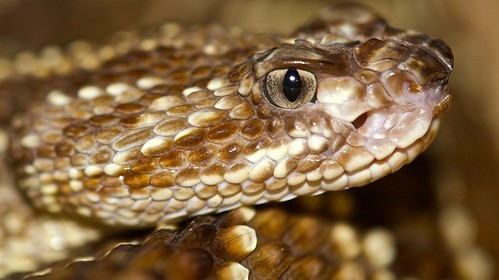 Where is your favorite herping spot in the world? Pretty much anywhere in India (I have a distinct Indian bias) though I have spent most of my 'field time' in the northern Western Ghats and eastern Arunachal Pradesh. 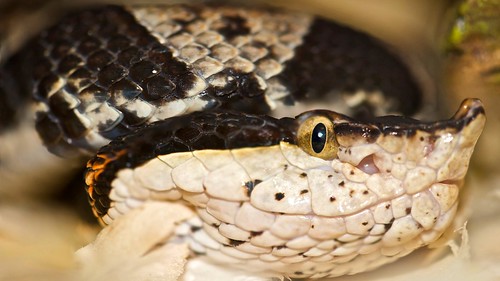 Do you have any favorite herps to find in the wild? Anything that still gets you excited to find? No favorite spots as such. Finding any herp is exciting for me! Do you have a life list? If so, what herp is at the top of your list to find in the wild? No life list as such, but I would love to see Indian Trimeresurus (Peltopelor) macrolepis; the Sri Lankan Trimeresurus (Craspedocephalus) trigonocephalus and the African Bitis gabonica (all in the wild). Is there any country/area that is at the top of your list to visit still? Injun bias again! In India, there are still so many places left to visit - the deserts, southern Western Ghats, Eastern Ghats, the Andamans, Nicobar Islands . . . The full Q&A can be viewed here: Ashok Captain, India, & Herp Photography Wednesday, April 18 2012War on Snakes
Anthony Hensley, 37, of Villa Park, Illinois drowned after he was attacked in his kayak by a mute swan, Cygnus olor. I did some research on this animal and learned a few things. The mute swan is an introduced exotic species, universally considered to be an invasive species. A quick Internet search shows many state departments of natural resources expressing disdain for the negative impact of this exotic animal. It is destructive to the environment by consuming huge quantities of submerged aquatic vegetation, thus destroying critical fish and aquatic wildlife habitat. In addition, the highly aggressive and territorial mute swan out-competes native waterfowl and shore birds for habitat, actively destroys eggs and chicks, and attacks and kills adult birds. It is directly responsible for wiping out native nesting populations of endangered black skimmers and least terns in Maryland, and is responsible for reductions in other waterfowl populations. As we see from the attack and tragic drowning of the man in Illinois, it is highly aggressive toward people: clearly its large size and belligerent disposition make this a dangerous animal.
All of this is strikingly similar to the information used to justify the recent Lacey Act listing of the Burmese python as an "injurious" species. One would assume that mute swans, with a proven record of causing the same problems (actually worse), are similarly listed, but they are not. In fact, they are a protected species by the same USDI/USFWS who “banned” the Burmese python, African rock python, and yellow anaconda. The conclusions are inescapable and undisputable: a widely held fear of snakes, fueled by the media’s lust for sensationalism, along with the strong influence of animal rights interests, have resulted in one animal being persecuted by the federal government, while another “disagreeable” species receives protection and is “managed”. Orwell was correct in that “some animals are more equal than others.” And I had always interpreted Animal Farm as being symbolic. Make no mistake about it, politicians currently see a “war on snakes” as a politically profitable enterprise, an opportunity to garner the adoration of fearful constituents and emotional animal rights advocates. Do not doubt that more efforts are underway on all levels of government to regulate or eliminate your right to keep reptiles, especially large and/or exotic species. HR511 is currently alive and well in Congress. Snake keepers, you absolutely must speak up to your representatives or you are going to lose more of your freedoms. Tell them you are against HR511. Politicians react well to the fear of losing popularity. Contact your Congressman and voice opposition to HR511 as biased, unnecessary legislation. Write or email, or both. You can locate your Congressman here: http://www.house.gov/representatives/ Mute swan references, if you are interested: http://www.mdsg.umd.edu/issues/restoration/non-natives/workshop/mute_swan.html http://www.issg.org/database/species/ecology.asp?si=973&fr=1&sts=sss http://www.pserie.psu.edu/seagrant/ais/watershed/swan.htm http://www.dnr.state.md.us/dnrnews/infocus/muteswanfacts.html http://www.dnr.state.mn.us/invasives/terrestrialanimals/muteswan/index.html Tuesday, April 17 2012kingsnake.com launches new state/local classified ads! kingsnake.com advertisers can now reach both a national and a local market with the same advertisement. There is no extra charge, and no separate account is required to post local and state classifieds. kingsnake.com advertisers can now reach both a national and a local market with the same advertisement. There is no extra charge, and no separate account is required to post local and state classifieds. State-by-state ads are now available at http://market.kingsnake.com/indexlocal.html, with a zip code-based/regional search launching soon. To make sure your ads show up in the state and local ad system, simply include the state and zip code in the appropriate advertising fields in the classified ad posting form. If you already have advertisements posted, you do not have to re-post them to take advantage of this new functionality. To update your existing ads, log into the My Ads section of your classified account, enter your state and zip in the appropriate form fields, fill in the check box that says "update all my ads," and then click submit. The system will update all your existing ads! Easy! To check out the new state and local reptile classifieds, go to http://market.kingsnake.com/indexlocal.html. To update your existing classified ads, please log into http://market.kingsnake.com/account.php?page=manage. To purchase a classified account please, go to http://www.kingsnake.com/shared/services/classified.php. Monday, April 16 2012Natural History and Husbandry of Candoia
The Pacific Boas
There are no other boas within thousands of miles. They most likely had to raft across the Pacific to get to where they now reside. Triangular shaped viper heads, up-turned snouts, no heat sensitive pits, and thick-keeled scales with flattened bodies separate them in structure. Some are semi-fossorial and some have prehensile tails. 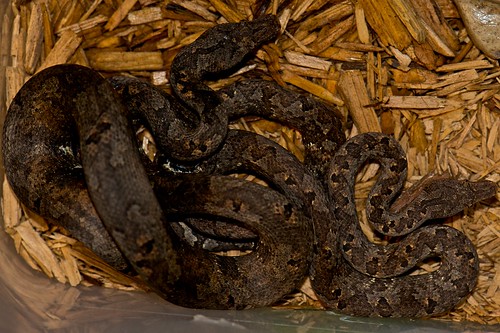 Adult sizes range from a diminutive pencil-thin 16 inches to over 7 feet with girth. They survive in the typical rainforest that most other boas do: dense undergrowth, high humidity, and lots of rain and prey. However these boas thrive equally well in dry grasslands, woodlands, plantations, and around human dwellings. The Candoia genus is like no other genus in the Boidae family. They are unique in their locality and appearance, but are overlooked in the herpetological hobby world. Adult sizes range from a diminutive pencil-thin 16 inches to over 7 feet with girth. They survive in the typical rainforest that most other boas do: dense undergrowth, high humidity, and lots of rain and prey. However these boas thrive equally well in dry grasslands, woodlands, plantations, and around human dwellings. The Candoia genus is like no other genus in the Boidae family. They are unique in their locality and appearance, but are overlooked in the herpetological hobby world. Candoia are one of five Boidae genera that include the Eunectes, Epicrates, and Corallus of the Americas and the Boa that range from the Americas to Madagascar. Candoia do not possess the size of Eunectes, the iridescence of Epicrates, the bright Technicolor coloration of some Corallus, nor the popularity of the Boa genus though. Jerry Conway, one of the first hobbyist to give Candoia a real chance and the first innovator of their care, said it best; “[Candoia] are naturally beautiful…there are no ‘morphs’…no man made nonsense involved with Candoia at all…they are underdogs of the snake world…true, primitive wonders of the wild.” These boas are the hidden gems that have been sitting out in the open. They are easy to care for, the easiest to sex properly, naturally calmer than their relatives, naturally variable, and beautifully unique in the Boidae family. 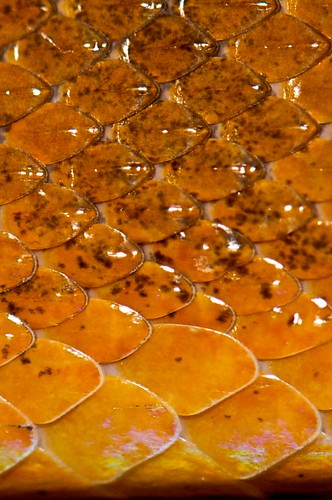 Species and Subspecies Candoia aspera Viper boas, aka New Guinea ground boas, are the most well known species of Candoia in the herpetological world and are commonly found throughout their range. They are found on their namesake island, New Guinea, on Irian Jaya, and on hundreds of islands off the shore of Indonesia. Viper boas are short and stocky, resembling death adders, and display a lot of variation in their coloring. They run the gambit of colors and patterns including black, brown, orange, yellow, and gold, and can be blotched or banded. The most impressive individuals are fire engine red with red ventral scales. These snakes have the thickest keeled scales of all Candoia, are between 22 and 36 inches long as adults, and spend a lot of their time in their water bowls. They are also completely terrestrial and even semi-fossorial. Two subspecies are recognized: C. a. aspera (Bismarck Ground boa) and C. a. schmidti (New Guinea Ground boa). 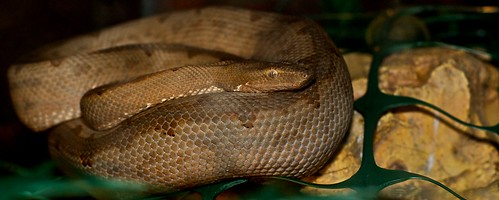 Candoia bibroni Two subspecies are recognized: C. b. australis Solomon Islands tree boas are probably the second most well known species of Candoia, although not nearly as well known as C. aspera. Solomon Islands tree boas can be found throughout the islands and will usually be found in coastal mangrove or cultivated areas. They can be quite variable in color and pattern, colored in reds, pinks, oranges, yellows, browns, grays and black. They may have blotched or splotchy patterning, uniform color, or have an almost zig-zag dorsal stripe. Along with their great display of colors and patterns, C. b. australis also have the ability to lighten and darken in color and patterning throughout the day. I’ve seen individuals change from a dark brownish-red with heavy patterning to a light pinkish-tan with faint patterning, over the course of a few hours. This species’ habits are almost completely opposite of the Viper boas’ habits. They are arboreal 90% of the time, sometimes even perched in the classic fashion of a Green Tree python. Their thin bodies lend themselves nicely to an arboreal lifestyle, where they can stretch across and move between branches with ease. Rarely you’ll spot individuals hanging out and coiled up on the ground. Males of this species range from 3 to 4 feet in length, while females rarely exceed 6 feet. 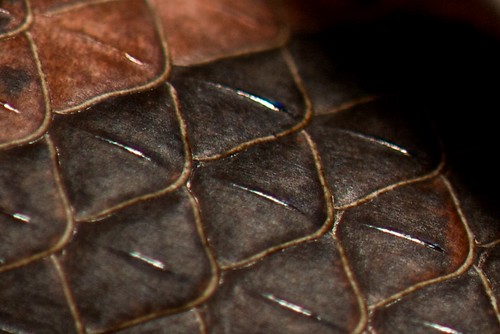 The full-article, as well as more posts, photos, and snake care tips from Chris Carille can be seen on his personal blog here: http://nyexotics.blogspot.com/ Saturday, April 14 2012Red Ear Slider Eggs
My 6" female red ear laid an egg about a week ago while she was in the water, and then she laid another one today. (A week later.) I now have her separated in her own area where she is able to lay/burry the rest, out of the water, but I am not sure how long I can/should keep her there. Can anyone tell me how long it takes to lay all the eggs, however many there may be? I am not sure if it's a week, two weeks, a month, etc. Any info would be helpful. Thanks! Julie
Friday, April 13 2012Educating the Masses: Chicago Herp Society's ReptileFest Educational outreach is the key to changing people's perceptions about reptiles, PERIOD. It creates a personal connection to reptile ownership that will override misconceptions put out there by the media and others. Educational outreach is the key to changing people's perceptions about reptiles, PERIOD. It creates a personal connection to reptile ownership that will override misconceptions put out there by the media and others.With that thought in mind, I am locked and loaded for this year's ReptileFest, an event hosted and organized by the Chicago Herpetologial Society. I will be both exhibiting and covering the event for kingsnake.com. Coverage will be a bit sporadic however, as I will be staffing 12 tables with my slave labor and good friend Chris Law. My exhibit combines my beautiful beloved morelia, my reptile rescue group. and the International Reptile Conservation Foundation. Keep an eye here or on our Facebook page for fun stuff! It is a very unusual event in that it will have no live animal sales, but that isn't all that makes it special. The fact that there will be around 400 animals and 200 species on display is pretty special. The really cool part is that 99 percent of these animals are privately owned. These are people's pets, and they can share the day to day joy on a far different level than, say, a zoo keeper would. Our exhibits will range from a 5-year-old darling girl and her corn snake display, to professionals like Rob Carmichael from the Wildlife Discovery Center showing off Illinois native venomous and doing proper public education without sensationalism. As I get ready to turn the house over to my husband and pick up my trailer of supplies before I head down to Chi-Town, I hope that this weekend will serve as an inspiration to others. Remember, Snake Day is May 14! Photo courtesy of Mike Heinrich - ReptileFest 2011 Monday, April 9 2012Snakes worldwide developing increasing resistance to neurotoxin Neurotoxin compositions may vary worldwide, snakes on four continents are demonstrating remarkably similar evolutionary responses enabling them to combat the toxins. Neurotoxin compositions may vary worldwide, snakes on four continents are demonstrating remarkably similar evolutionary responses enabling them to combat the toxins.(University of Notre Dame biologist Michael) Pfrender and colleagues found species of snakes in North, Central and South Americas and Asia that are able to feed on amphibians that secrete a deadly neurotoxic poison, tetrodotoxin or TTX. These snakes have similar mutations in a key sodium-channel gene that makes them highly resistant to TTX. These mutations prevent TTX from blocking the sodium channels in muscle, which would otherwise immobilize the snakes by paralyzing nervous and muscle tissue. To read the full article, click here. Sunday, April 8 2012HSUS offers reward for capture of python mutilator in one state, while their policies lead to python abuse in othersIn bitterly ironic twist, the Humane Society of the United States is offering a reward of up to $2,500 for information leading to the identification, arrest and conviction of the person or persons responsible for the mutilation, neglect, and abandonment of an emaciated 7-foot male Burmese python who was stabbed twice, shot, and released in York Haven, Pa. "Snakes require specialized expertise and care and deserve the same humane treatment as all other animals,” said Sarah Speed, Pennsylvania state director for the HSUS. Sadly the Humane Society of the United States has said nothing about the recent mutilation and slaughter of a similar, yet larger, Burmese python by Florida Forest Service Rangers, killed by being beaten to death by rakes: Tarrete held the tail, and Chaney grabbed the head. The two killed it with a rake rangers usually use to set fire breaks during controlled burns, Tarrete said. Perhaps Sarah Speed can speak to her compatriots at HSUS in Florida about offering a similar reward and prosecute the Florida Forest Rangers with the same enthusiasm. Unfortunately her compatriots at HSUS, both in Florida and at the national level, were among the main proponents of the new federal regulations, and state regulations, that allow a duality in laws to occur. Where in one state mutilating a python is a crime, and in another it is a state-funded job opportunity. Perhaps she can also ask why her organization is paying thousands of dollars to prosecute someone for mutilating a python in Pennsylvania, and has simultaneously spent hundreds of thousands of dollars convincing the State of Florida and the USFWS to essentially mutilate these animals on an industrial scale. In the meantime this is yet another example of Burmese pythons being "dumped" by irresponsible owners, after the species was recently listed by the USFWS as "injurious," preventing import and interstate transport. This despite USFWS assurance that this would not happen as owners would have local outlets to place their animals. Unfortunately this is just the beginning, and these numbers will continue to rise as more Burmese python owners find fewer and fewer people and organizations willing to accept their animals. And sadly, one wonders if the snakes would have both met the same ends in shelters, had neither been mutilated, just surrendered. Friday, April 6 2012Of pythons and pit bulls: Pushing back against media bias People used to say "Euuuw!" when they heard I had pythons, and shiver in fear at my pit bulls. Now, those reactions are reversed. People used to say "Euuuw!" when they heard I had pythons, and shiver in fear at my pit bulls. Now, those reactions are reversed.Over the years, the pit bull community has taken a very proactive role in fighting false negative stereotypes about our dogs. For longer than I have owned dogs, people in the community have stepped out, created educational days, spent time talking about our dogs to anyone who will listen. It's time for the python community to adopt what has been an extremely successful program for getting out the truth about our pets. Consider the headline on an article on ctpost.com: DEEP collects 5 illegal pets, one vicious python, at Beardsley Zoo The article goes on to explain the surrender of a Burmese python in lurid detail: The most exciting moment of the day occurred behind closed doors. That is the scene people who have never met a python will always remember. They'll get the idea pythons are dangerous beasts who will strike at you and wrap around you and, presumably, send you to your scaly doom -- something those of us who keep them know is a distorted and false view of our pets. Distorted or not, stories like this fill the newscasts, papers, and websites non-snake owning people read every day. It's time we learned from the pit bull people and started pushing back. We need to attend Snake Day and herp society events that are occurring this spring nationwide. Offer to do presentations at local schools, camps, and community groups. Set up a booth at festivals and street fairs. We need to talk about our pets to other pet people, whenever and wherever we can. This is our opportunity to reach out and change minds. It worked with pit bulls. It will work with pythons -- if we do the work to get our voices heard. Will you start speaking out this spring? Sunday, April 1 2012Escaped pythons linked to secret U.S. Army project from 1960s According to documents and interviews obtained for his book, Vietnam's Underground War: Snakes, Rats and Boonie Hats, Icelandic author Uno Imnottyourdottr makes the shocking revelation that the python and boa problem in the Florida Everglades was the result of the purposeful release of animals used in a secret U.S. Army/CIA sponsored project to develop large constrictor snakes as weapons to fight in the extensive Vietnamese tunnel network. According to documents and interviews obtained for his book, Vietnam's Underground War: Snakes, Rats and Boonie Hats, Icelandic author Uno Imnottyourdottr makes the shocking revelation that the python and boa problem in the Florida Everglades was the result of the purposeful release of animals used in a secret U.S. Army/CIA sponsored project to develop large constrictor snakes as weapons to fight in the extensive Vietnamese tunnel network. Dubbed Operation: Blue River in official documents, and gaining the unofficial name Operation: TubeSnake by wags assigned to the project, thousands of boa constrictors, pythons, and anacondas were surreptitiously purchased by the military from Florida wildlife importers in the late 1960s and early 70s and brought to MacDill AFB in Tampa for processing, before being sent to a secure containment facility deep in the Everglades. Once there, the snakes were evaluated for their ability to be trained and suitability for mission, and were given basic mission testing by species. Snakes were equipped with a variety of equipment depending on mission assignment. Sensor and camera platforms, including infra-red and millimeter band and side-looking radar, as well as UHF/VHF communications equipment were utilized in the reconnaissance role, as well as a variety of weapons to be used literally as a hunter-killer platform. Weaponized snakes included a variety of munitions including everything from small explosive charges to large anti-tank mines. Chemical weapons such as CS gas and pepper spray were also evaluated, difficulties arising in finding applicable gas mask solutions for the constrictors. Testing of the animals revealed issues with trainability as well as limited load carrying capabilities. According to Army documents Burmese Pythons were found to be the species most suitable to the mission profile, and after late 1971 only Burmese Pythons were used although weapons and sensor platforms had been developed and successfully tested on snakes as small as 2 feet long and as large as 18 feet long. According to Imnottyourdottr's book, Operation Blue River was quietly discontinued in 1974 before being tested in combat, and all the constrictor snakes remaining in the project were demilitarized and then released outside of the facility into the surrounding swampland, after Congressional investigations were opened into the CIA's failed attempts to train King Cobras as assassins. It was hope that the highly trained constrictors could be recovered should the project be revived, but military priorities by then had shifted to the Middle East. Million Snake March hits Washington D.C. Millions of undocumented boas and pythons descended on the National Mall in Washington D.C. today demanding that Congress afford them the protections that others have received, and to demand that Congress stop the building of a wall between Louisiana and Texas to prevent the snakes further migration westward. Acting as their spokesman Norville T. Bass, President of the American Snakehandlers Association, said, "These snakes have come here and are doing jobs that American snakes by and large don't want, and now with no due process the government wants to stop them from traveling between states. Some of these snakes have family in other states. What happens to them?" Millions of undocumented boas and pythons descended on the National Mall in Washington D.C. today demanding that Congress afford them the protections that others have received, and to demand that Congress stop the building of a wall between Louisiana and Texas to prevent the snakes further migration westward. Acting as their spokesman Norville T. Bass, President of the American Snakehandlers Association, said, "These snakes have come here and are doing jobs that American snakes by and large don't want, and now with no due process the government wants to stop them from traveling between states. Some of these snakes have family in other states. What happens to them?"Watching the slithery procession of participants while providing crowd control on foot, Sergeant Eric Witherspoon of the Metro D.C. Police Department offered, "We haven't seen this many snakes since the last time Congress was in session." Asked about the lack of mounted patrols at the event, Witherspoon said, "The horses don't like snakes, and some of the officers aren't too keen either," as a reticulated python slithered across his boots. Bystanders at the event, Cecil and Trudy Horsfeldii from Rockford Illinois, were caught up by the day, but a little confused as to what was going on. "Is this the Rick Astley flash mob? We were all supposed to meet at 3 pm and go to the Air and Space Museum." It was difficult to tell just how many of the reptiles packed the Mall, their squirming, writhing mass being difficult to calculate with any accuracy. By dusk, however, the snakes, their representatives, and the media had vanished, leaving cleaning crews to clear D.C.s Mall area of debris that always accompanies an event like this, like cups, signs and thousands of shed skins. But the snakes shall return soon when the Senate convenes again. Obama okays use of drones in fight against invasive pythons Multiple White House sources have confirmed that the Obama administration has approved the use of armed drones in the fight against the invasive Burmese python, pending clearance by the Federal Aviation Administration. While the use of armed drones to eliminate threats outside U.S. borders has become rather commonplace, this is the first time that the weapons have been approved for use inside the United States. Multiple White House sources have confirmed that the Obama administration has approved the use of armed drones in the fight against the invasive Burmese python, pending clearance by the Federal Aviation Administration. While the use of armed drones to eliminate threats outside U.S. borders has become rather commonplace, this is the first time that the weapons have been approved for use inside the United States."This is an escalation that we don't think the pythons are prepared for. We hope the technology will give us an edge." said one unnamed official. When asked about the $1,200,000 per missile/python cost he replied, "They're eating endangered wood rats. And they are putting American snakes out of work. They have to be stopped before they make the I-10 corridor. Once that happens, we'll start finding em in El Paso, Los Angeles, San Francisco, Portland, Seattle...then it's game over. The Canadians are even less prepared than we are." Both Lockheed-Martin and Northrop-Grumman are said to be preparing drone-based python remediation programs, as are European defense contractors SAAB and MBB. Brazil's Embraer is said to have a head start after developing a similar drone based Anaconda remediation program for it's neighbor Venezuela, but faces challenges selling in the U.S. market after it's Super Tucano deal got hung up in congressional red-tape. "We are the only ones that have actual field experience using laser guided weapons from high altitude to remove yellow Anacondas, the Israelis have only gotten theirs to work with Sand Vipers, and then only with the nominate species Vipera ammodytes" said Embraer's Python Project Manager Pedro Borbón."The Israelis have no jungles to test in as well, all of their work has been in the desert. That might be fine once the pythons reach New Mexico and Arizona, but that cedes the pythons the entire gulf coast." Other American defense contractors are hard at work on their own remediation products, services and proposals, some less high-tech than others. World Ultradyne Security Systems, formerly a division of Blackwater Associates, is putting its former special forces operatives to work training "A Teams", or action teams, of specially trained mongoose, to hunt out the pythons on the ground. "We' have 100,000 of these rodents ready and trained so far, we are just waiting on the go ahead from the Park Service and USF&W to insert them into the Everglades with a large scale airdrop from C-130 transport aircraft. We're not going to win this until we put boots on the ground, four tiny jump boots at a time" Said Earl Wycleff, former Army Ranger and program manager. When asked about the possibility that the mongoose themselves may not return, and in turn become established Ultradyne has already considered that and is preparing "B Teams" of cougars to release and remediate any mongoose that fail to return. And if the cougars become established? "Bears. Bears are cougars' natural enemy, so we are working with bears. The Russian bears seem easiest to train, probably due to their extensive circus background."
(Page 1 of 1, totaling 14 entries)
|
Our SponsorsArchivesCategoriesSubscribe |
|
AprilFirstBioEngineering | GunHobbyist.com | GunShowGuide.com | GunShows.mobi | GunBusinessGuide.com | club kingsnake | live stage magazine
| ||||||||




